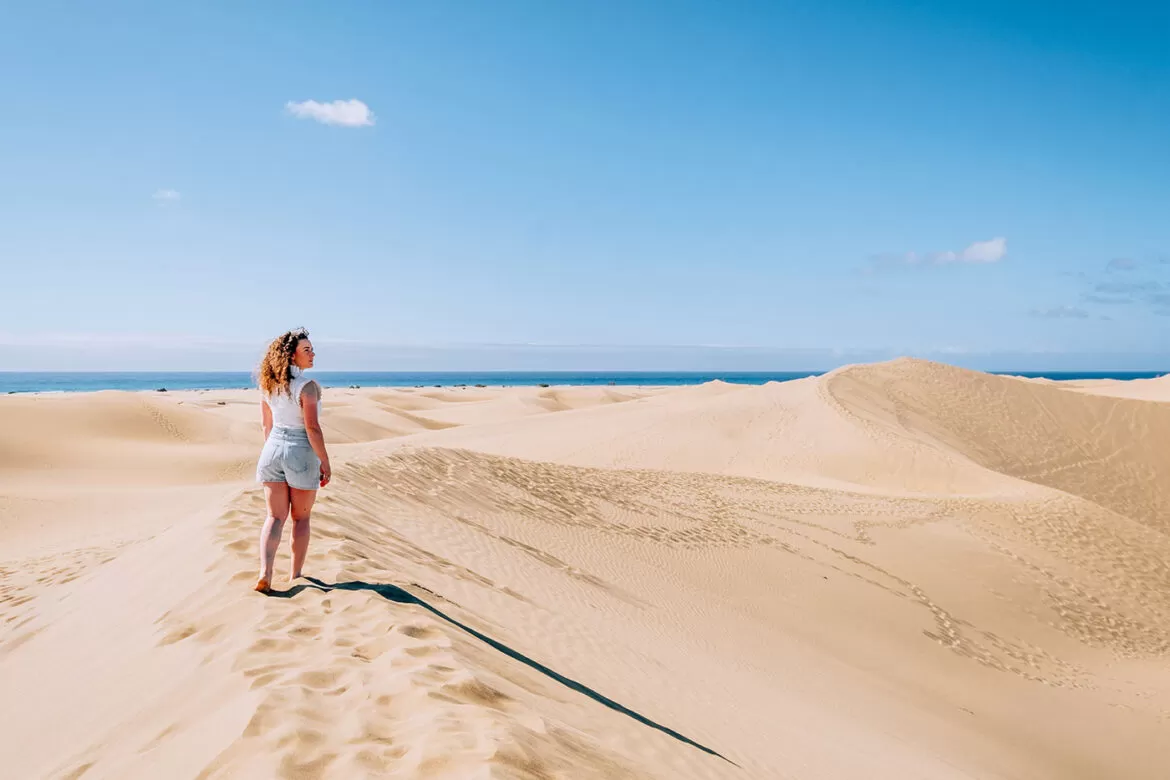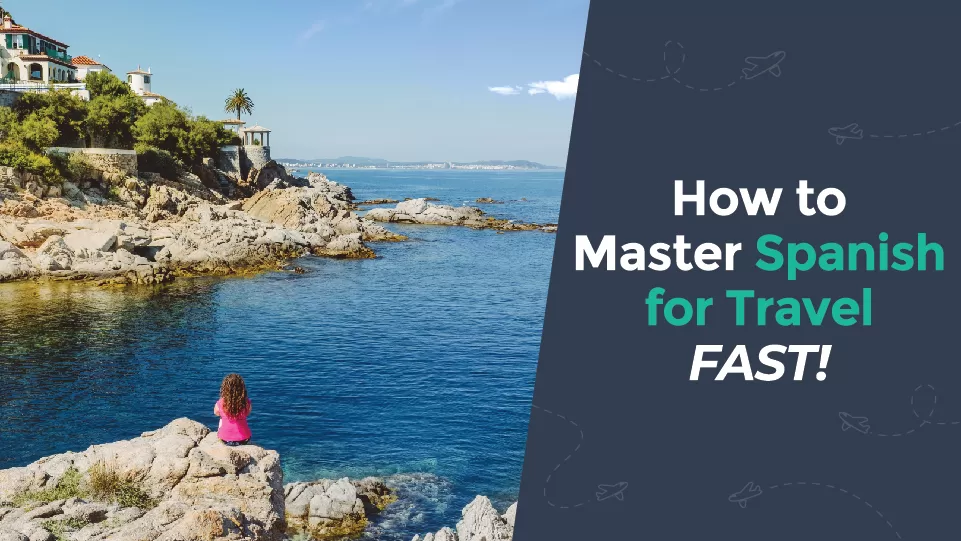Far from the Spanish mainland, the Canary Islands are an archipelago of volcanic islands known for their sandy beaches, year-round warm temperatures, and abundance of natural wonders. They are a tourist paradise, with 12 million visitors reaching the Spanish outpost annually. Collectively known in Spanish as Islas Canarias, they have been a place of wonder since ancient times. Surprisingly, these Atlantic islands probably owe their name to man’s best friend and not the cute canary yellow birds native to the island.
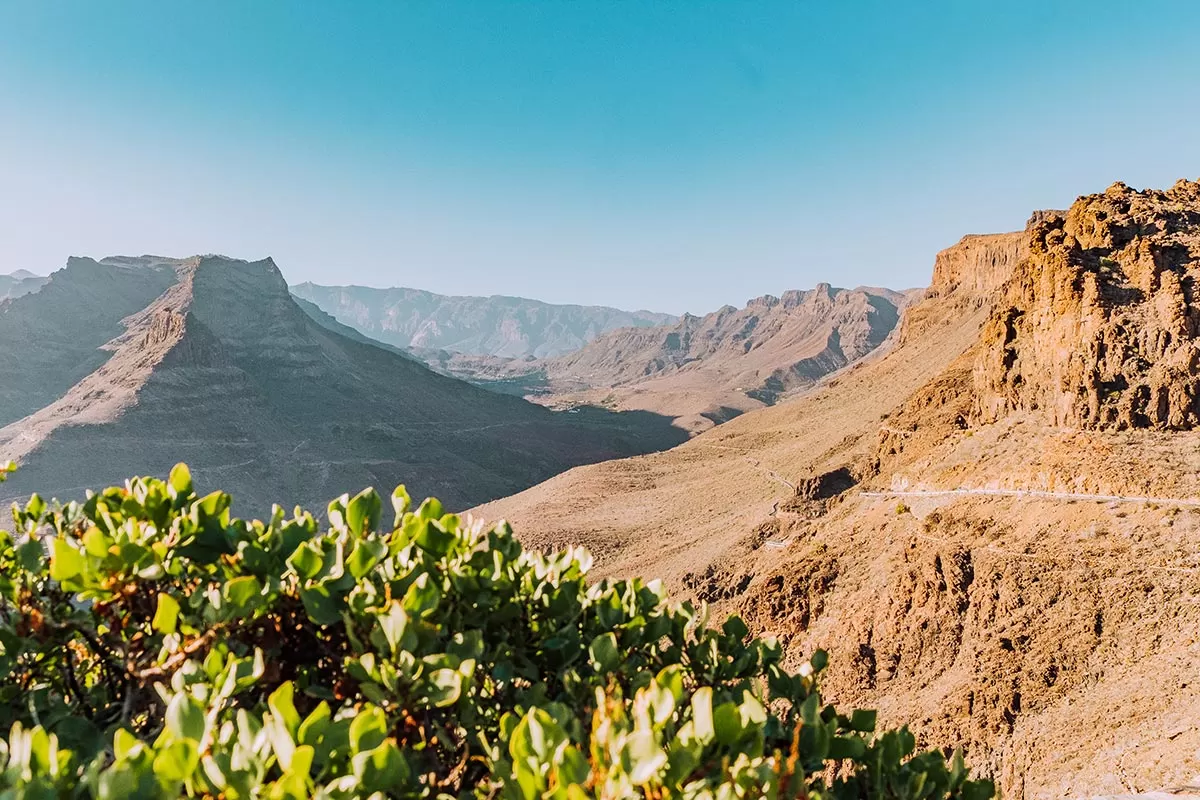
Volcanic Caldera
In Latin, Canariae Insulae means ‘Island of Dogs.’ According to the great Roman encyclopedist Pliny the Elder, the island of Gran Canaria was named by a Mauretanian king, Juba II, due to the ‘vast multitudes of dogs of very large size’ living here. Thankfully, today the native birds named after the islands far outnumber wild dogs.
Lying 62 miles (100 km) off the Moroccan coastline, the Canaries comprise seven large islands and many smaller ones. Most are well-known tourist destinations. They include Tenerife, Fuerteventura, Gran Canaria, Lanzarote, La Palma, La Gomera and El Hierro (in descending size order.)
All the islands are a joy to explore. But we will focus on one of the most popular as we set out to discover some of the best things to do in Gran Canaria.
A Brief History of Gran Canaria
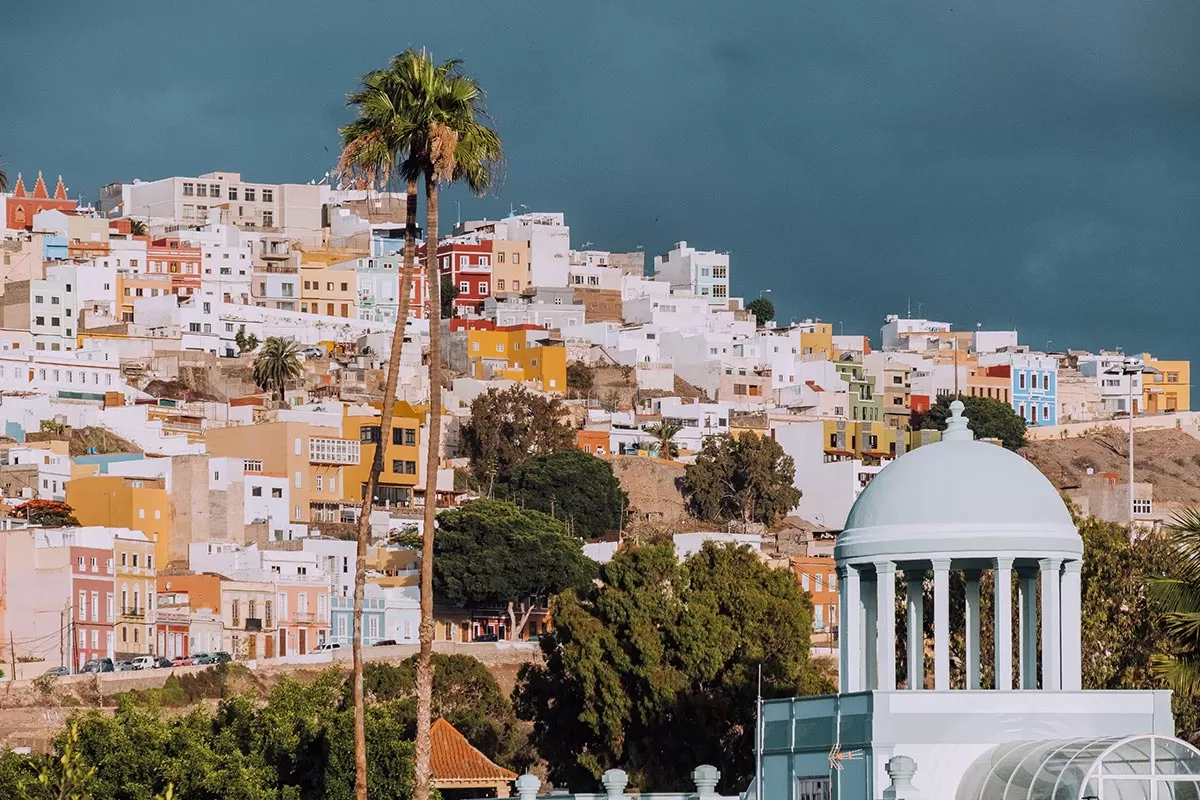 Before diving into what makes the island so special for visitors today, a brief history lesson offers a revealing insight into the island’s cultural heritage. The first inhabitants, the Guanche and Canario, were likely descended from the Berbers of North Africa.
Before diving into what makes the island so special for visitors today, a brief history lesson offers a revealing insight into the island’s cultural heritage. The first inhabitants, the Guanche and Canario, were likely descended from the Berbers of North Africa.
The development of Gran Canaria and the surrounding islands is shaped by their distant location in the Atlantic Ocean and distinctive volcanic landscapes. The island’s sub-tropical climate and fertile soils were ideal for growing valuable crops.
During its early history, Gran Canaria was visited by Arab traders and European explorers navigating the open oceans. The most famous was Christopher Columbus, whose fleets visited the island before heading west to the Americas.
By the time Columbus visited the islands, they had already fallen under Spanish control. Throughout the fifteenth century, expeditions from the Spanish mainland conquered the islands.
One of the last islands to be conquered, Gran Canaria fell under Castilian control in 1483. It followed 5 years of bloody conflict that saw many islanders slain by a tiny invading force led by Juan Rejón.
Arriving with just 30 soldiers, Juan Rejón founded what is now the island capital, Las Palmas de Gran Canaria (originally Real de Las Palmas.) By 1483, the entirety of the island belonged to the Crown of Castile after the conquistador, Pedro de Vera, defeated the last pockets of resistance.
The following century was only marginally more peaceful for Gran Canaria. As the Atlantic trade routes flourished, so did piracy around the Canaries. In 1599, Las Palmas was subjected to an attack that resonated through the ages. A massive fleet of 74 ships and 12,000 men occupied Las Palmas, led by the Dutch Admiral and occasional pirate Pieter van der Does.
Amidst the plundering, the Dutch pirate also promoted a new form of Christianity, Protestantism. This infamously led to Protestant services being conducted in the Catholic Santa Ana Cathedral. They might have been churchgoers, but the pirates were still intent on ravaging Gran Canaria.
Four thousand men were sent to claim Santa Brigida, another island town. By then, the resistance was fierce. 300 Canarians and Spanish soldiers famously defeated the pirate army. And in 1599, a Spanish army of 8,000 finally drove the invading force from the island.
Before sailing away, the pirates ransacked and razed Las Palmas. Infamously, the pious pirate captain stole the Santa Ana cathedral bell as a souvenir of his explosive time on Gran Canaria.
Today, the scars of piracy have healed. But you can see vestiges of that legacy in the Vegueta neighborhood around the Cathedral of Santa Ana. Here, stone piping on some homes resemble canons. A reminder of their role in spreading terror on the islands.
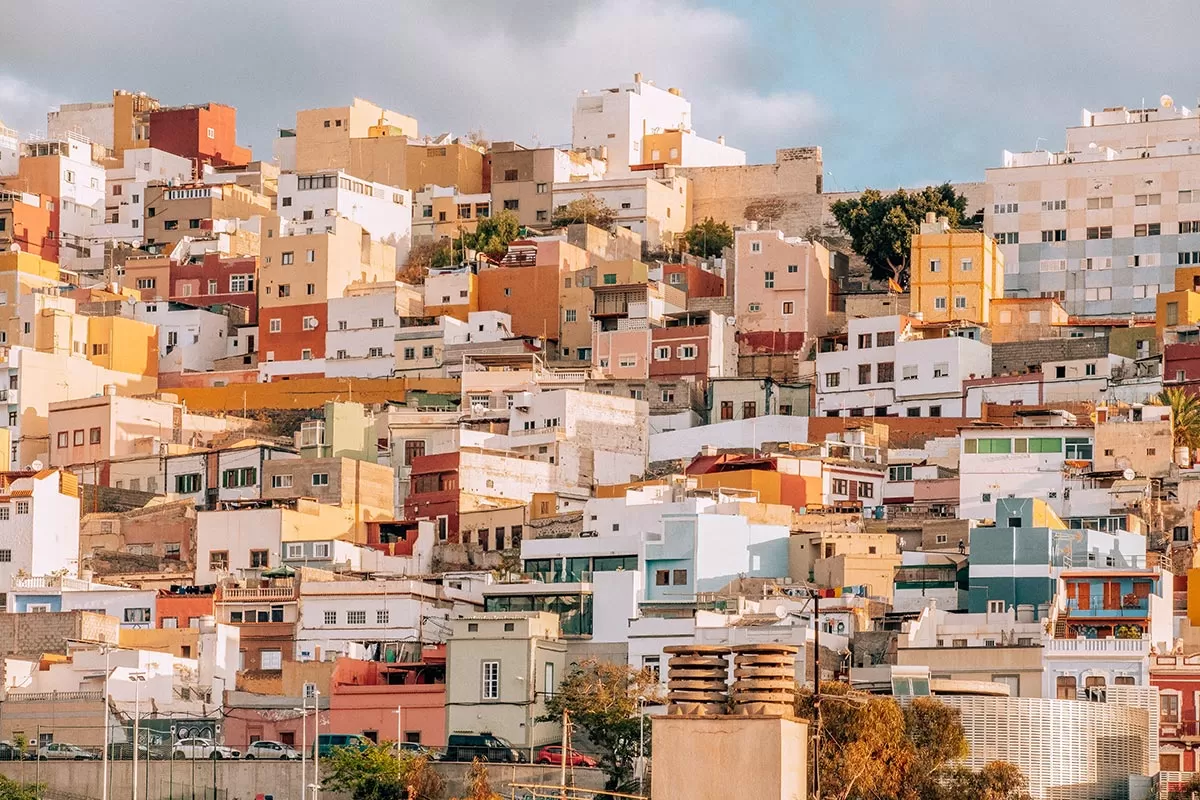 During the Golden Age of Piracy, attacks on the Canary Islands intensified. Yet, with improved fortifications and governance, none were as devastating as the attack of 1599. Despite occasionally featuring in the imperial rivalries that shaped European politics, Gran Canaria has been peaceful ever since.
During the Golden Age of Piracy, attacks on the Canary Islands intensified. Yet, with improved fortifications and governance, none were as devastating as the attack of 1599. Despite occasionally featuring in the imperial rivalries that shaped European politics, Gran Canaria has been peaceful ever since.
Las Palmas gained one final claim to notoriety in 1936 as the fleeting home to General Franco. Relegated to the island by the new leftist government of 1936, he soon returned to join the failed coup that would spark the Spanish Civil War. A colorful backdrop to some of the best things to do in Gran Canaria that we are now going to explore.
36 Things to do in Gran Canaria, Spain
1. Take a guided walking tour of Las Palmas de Gran Canaria historical quarter, Vegueta
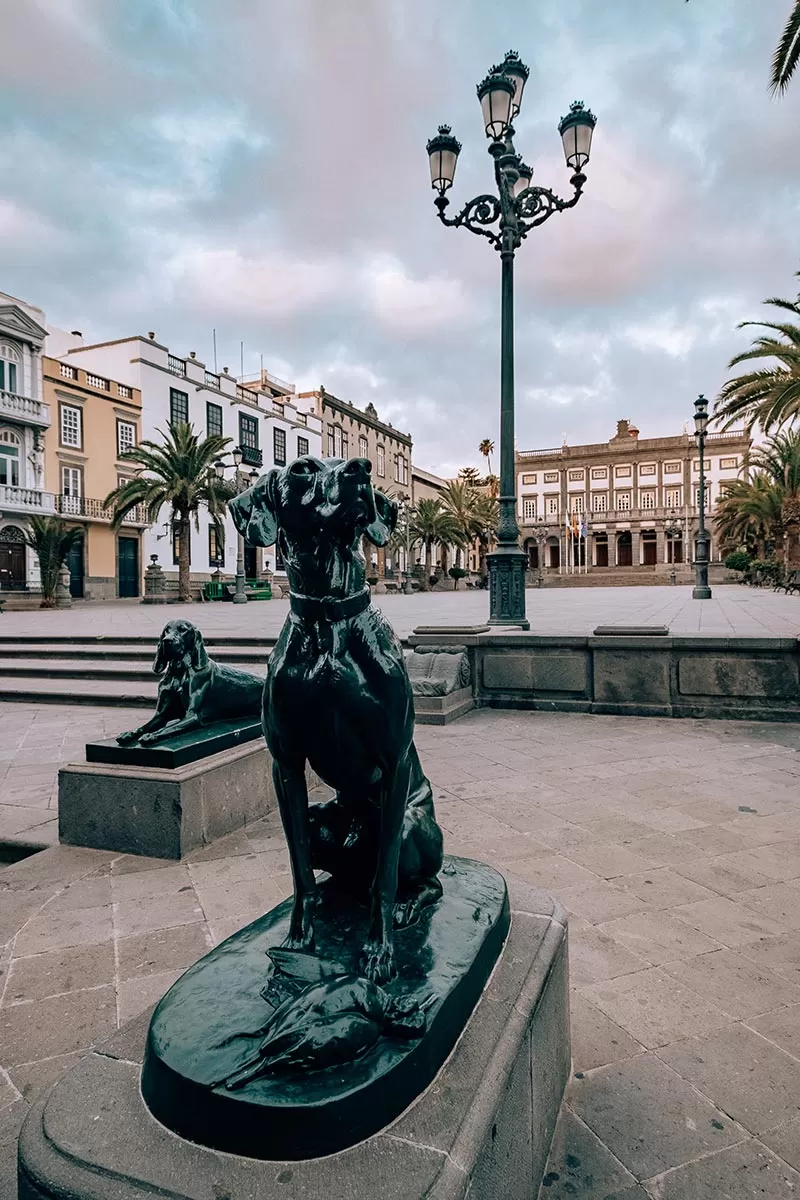 Las Palmas is the capital and historic heart of Gran Canaria. It is the largest city in the Canaries (9th largest in Spain) and home to some timeless neighborhoods. A guided tour of Vegueta and Triana, the two oldest quarters, is highly recommended.
Las Palmas is the capital and historic heart of Gran Canaria. It is the largest city in the Canaries (9th largest in Spain) and home to some timeless neighborhoods. A guided tour of Vegueta and Triana, the two oldest quarters, is highly recommended.
The premier landmark is the venerable Cathedral of Las Palmas de Gran Canaria, aka Cathedral of Santa Ana. This magnificent building took 70 years to complete and was opened in 1570.
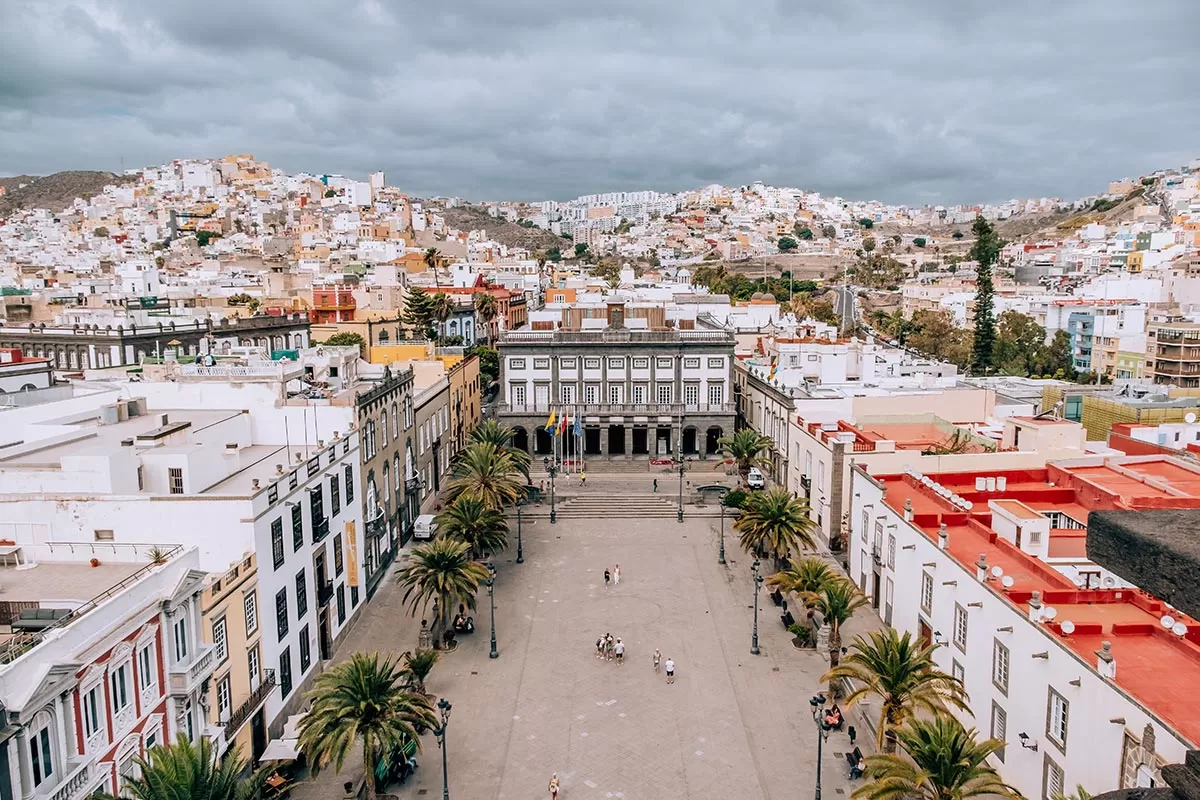
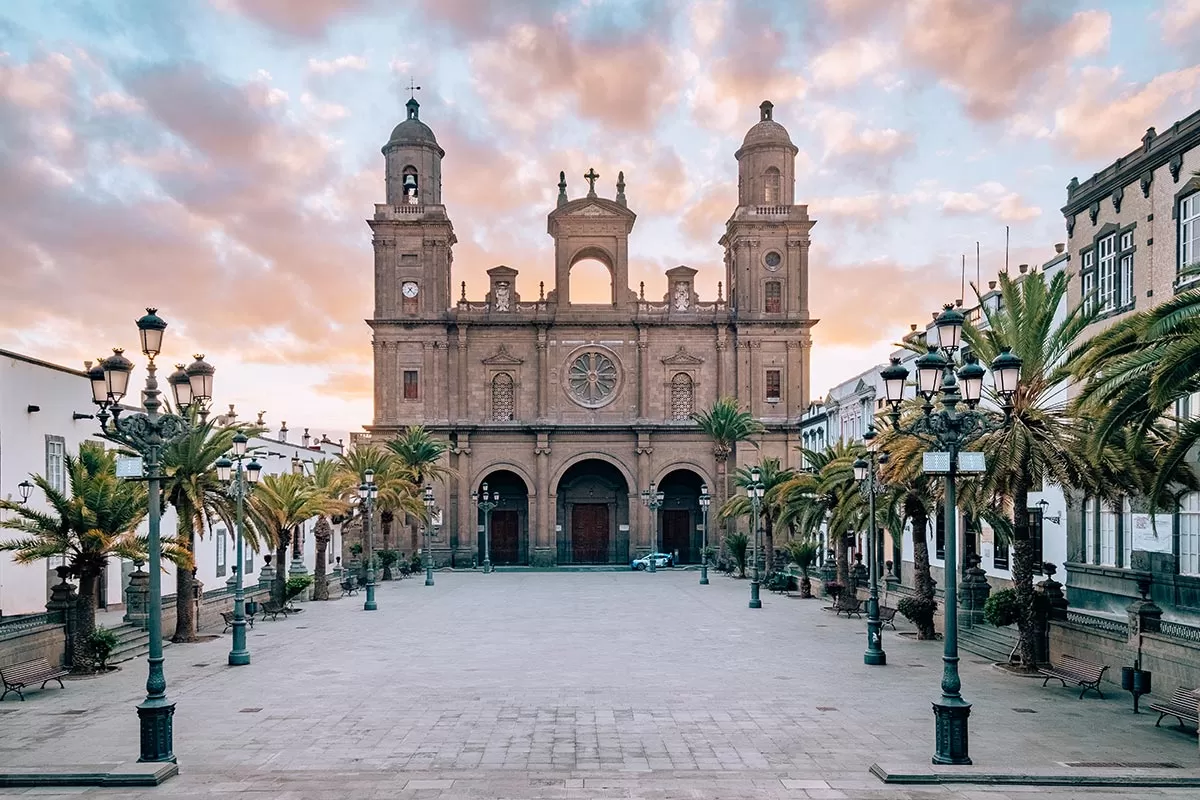
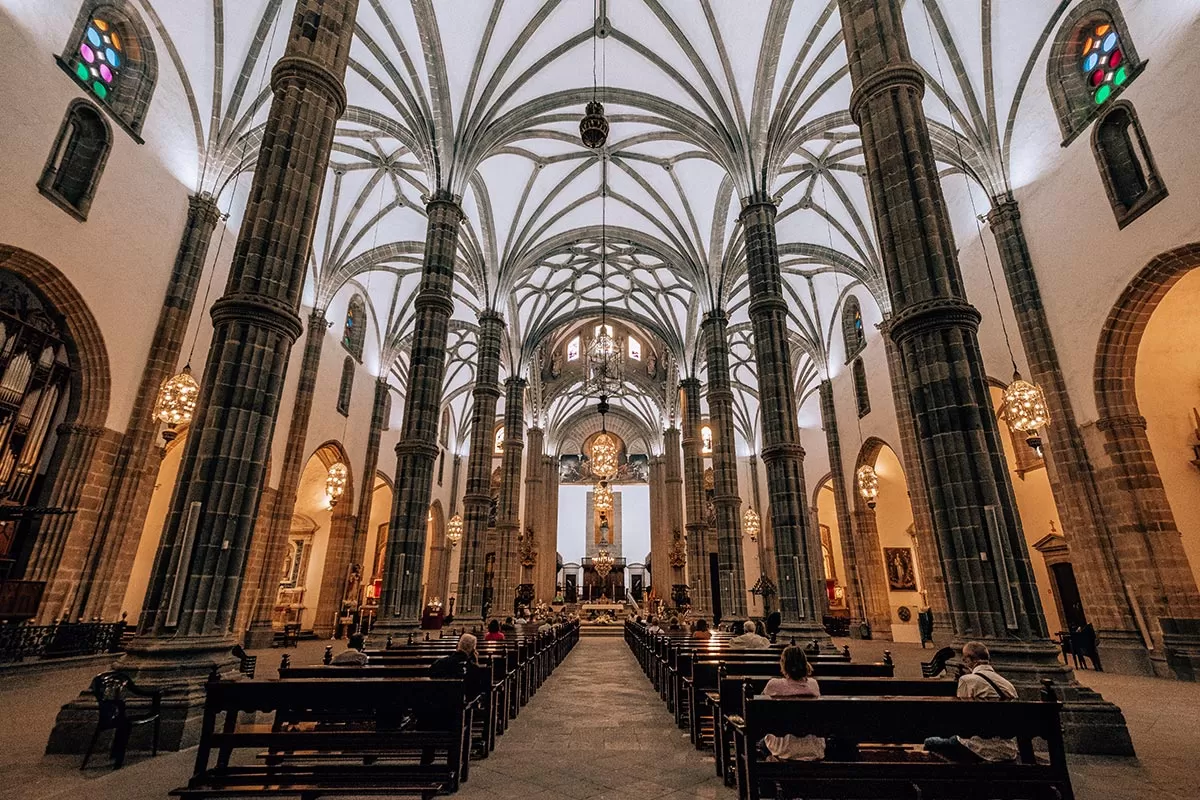
Inside Cathedral of Santa Ana
The celebrated cathedral is a fine example of Gothic Pointed architecture. Inside, soaring columns support piers creatively sculpted to resemble palm trees. The star feature is the bell tower, which commands spectacular views over Las Palmas.
Fortunately for tired legs, an elevator gets you close to the top. You’ll have to walk the remaining 54 steps, where any breath you have left will be taken away by the views.
Info for Santa Ana Cathedral:
- Entry to the belltower is €1.50
- Monday to Friday 10 am to 4.30 pm. Saturday 10 am to 1.30 pm. Closed Sundays and public holidays.
- For more details, visit the official website.
Outside the cathedral is the grand Plaza de Santa Ana. The peaceful square is lined with Spanish colonial buildings. Yet it’s the collection of handsome bronze statues of dogs that everybody talks about, the famous canariae that Pliny the Elder wrote of and from which the island is named.
Among the collection of fetching buildings overlooking the square is Casa Regental, a 17th-century building, and residence of the president of Gran Canaria’s High Court. You can also see the ornate façade of the Palacio Episcopal, all that remains after the fire of 1599 that destroyed much of the city. In better condition is the handsome Casas Consistoriales, the 19th-century town hall.
Deeper into the picturesque old quarter, you’ll find other intriguing diversions. You might want to take a moment in the scenic Plaza del Espíritu Santo (Square of the Holy Spirit) and marvel at its beautiful fountain. Overlooking the square are notable buildings, including the dainty Ermita del Espiritu Santo – Church of the Holy Spirit.
A tour of the neighborhood is a tour of life after colonization. To discover more about island life before the arrival of conquistadors, the Museo Canario (Canary Island Museum) is a fascinating place to while away an afternoon.
The diverting exhibits cover the oft-overlooked pre-colonial history of the Canary Islands. It is flush with archeological curiosities and eye-opening insights into aboriginal life in the Canaries.
You will find the Museo Canario on the corner of Calle Doctor Verneau.
Info for Museo Canario:
- Entry is €5 (free to under 12s)
- Monday to Friday 10 am to 8 pm. Weekends and public holidays 10 am to 2 pm.
- For more details, visit the official website.
Casa de Colón (Christopher Columbus’ House)



Your next stop should be the delightful Casa de Colón. Christopher Columbus reportedly stayed here in 1492 before heading across the Atlantic to the New World. The former home of island governors is an architectural gem of lattice balconies and ornate wood carvings, centered around two tranquil courtyards.
Casa de Colón hosts the Columbus House Museum. The diverse exhibits in this well-curated museum offer a fascinating insight into the explorer’s life and impact. The collection includes artefacts like hand-drawn maps and journals and a mockup of the interior of Santa Maria, Columbus’s flagship.
Info for Casa de Colón: Entry is €4
- Weekdays 10 am to 6 pm. Sundays and Public holidays 10 am to 3 pm.
- For more details, visit the official website.
As you explore the thriving and wonderfully preserved old quarters, you pass museums, art galleries (the Atlantic Center for Modern Art stands out), shops, bars, and more. Enjoy the tour to discover the hidden secrets, then return to leisurely explore the atmospheric cobbled streets of Vegueta.
Explore Triana
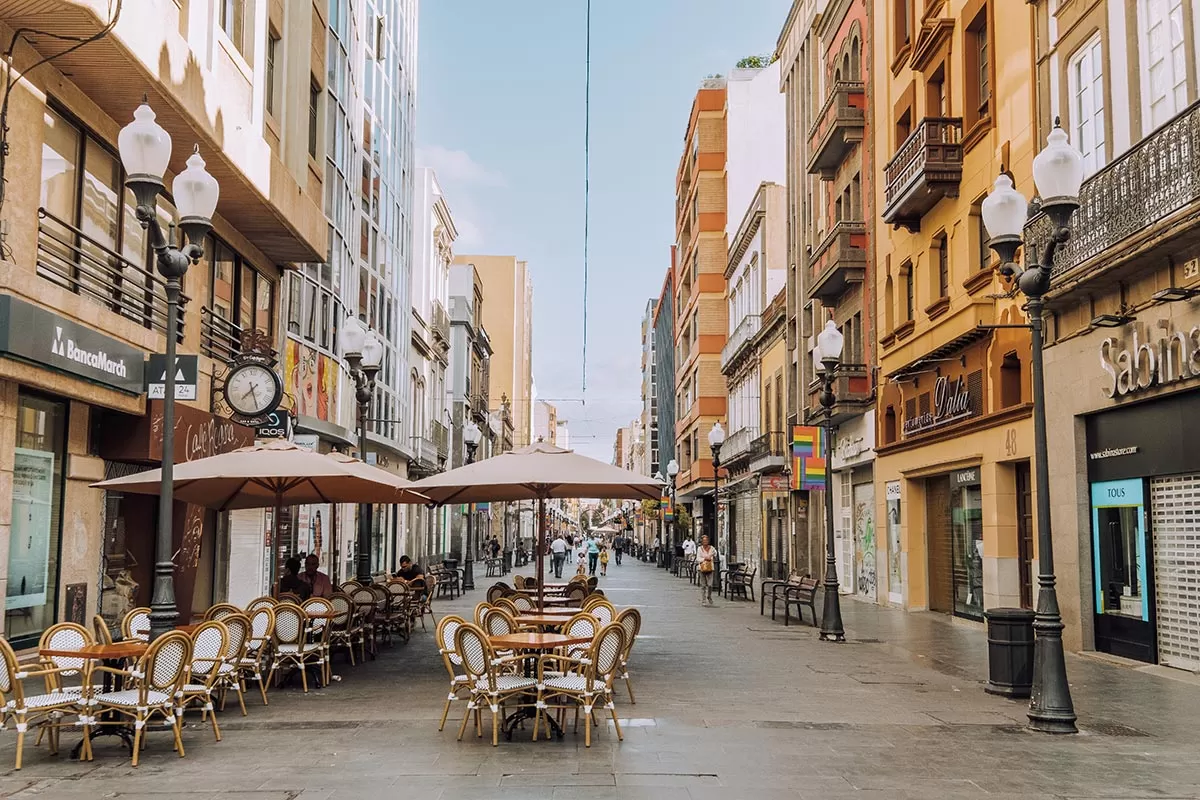
Calle Triana
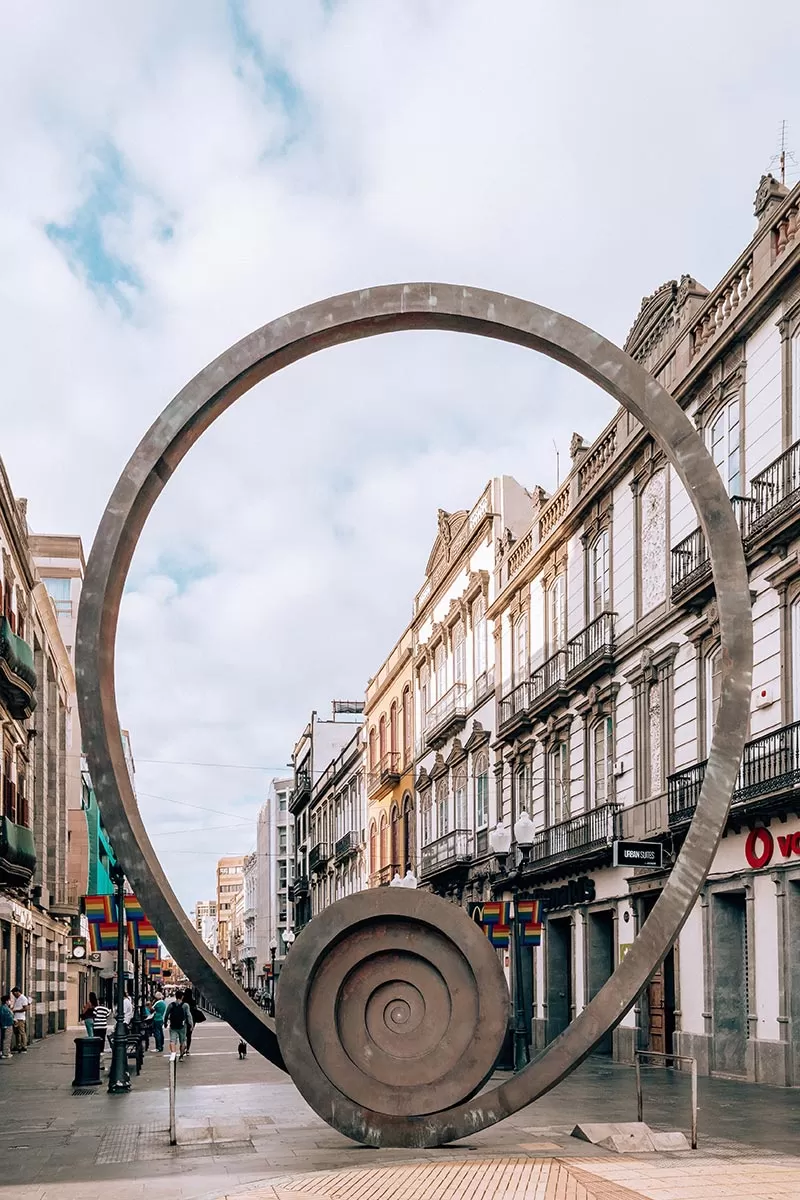
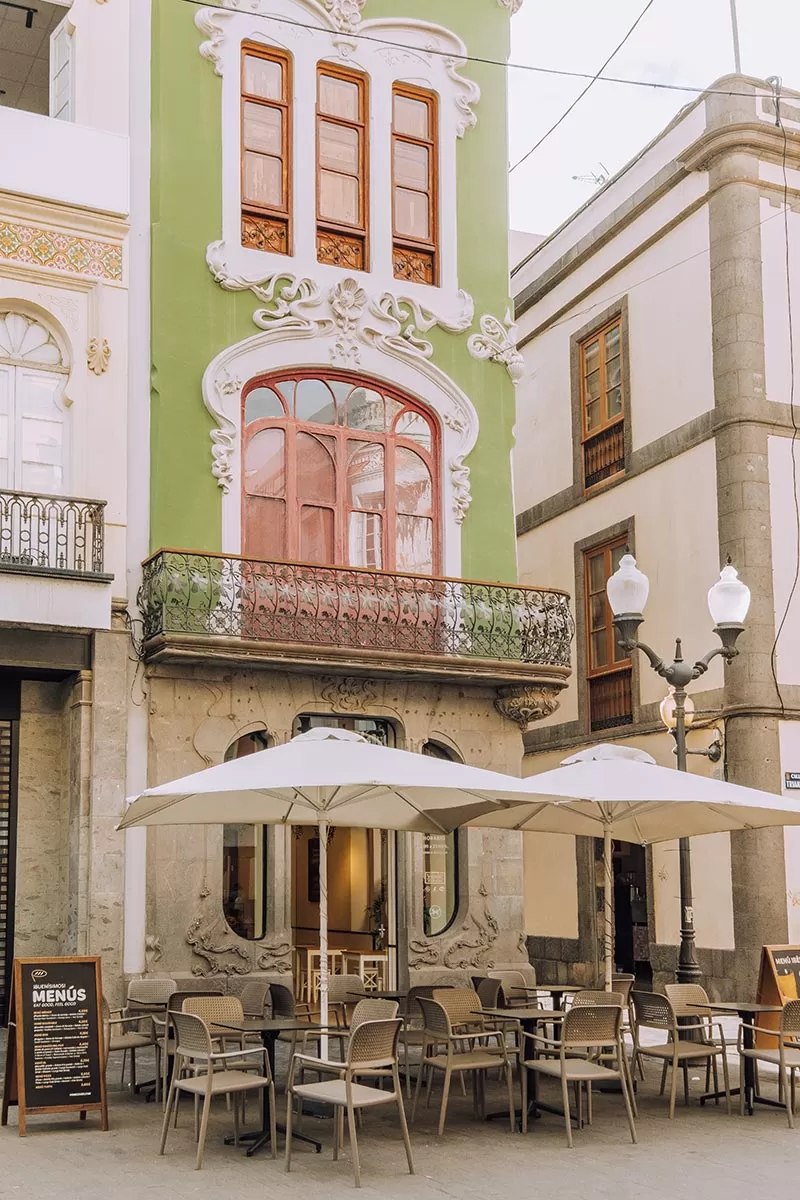 A walking tour of the old neighborhoods of Las Palmas includes the lively and captivating Triana quarter. Triana borders the Vegueta neighborhood and is the commercial center of Las Palmas.
A walking tour of the old neighborhoods of Las Palmas includes the lively and captivating Triana quarter. Triana borders the Vegueta neighborhood and is the commercial center of Las Palmas.
Scything through the quarter is the Calle Triana, which manages to be both an officially designated historic monument and a thriving shopping street. The happily pedestrianized street teems with old-world shops and upmarket boutiques that jostle with international chains and alluring eateries.
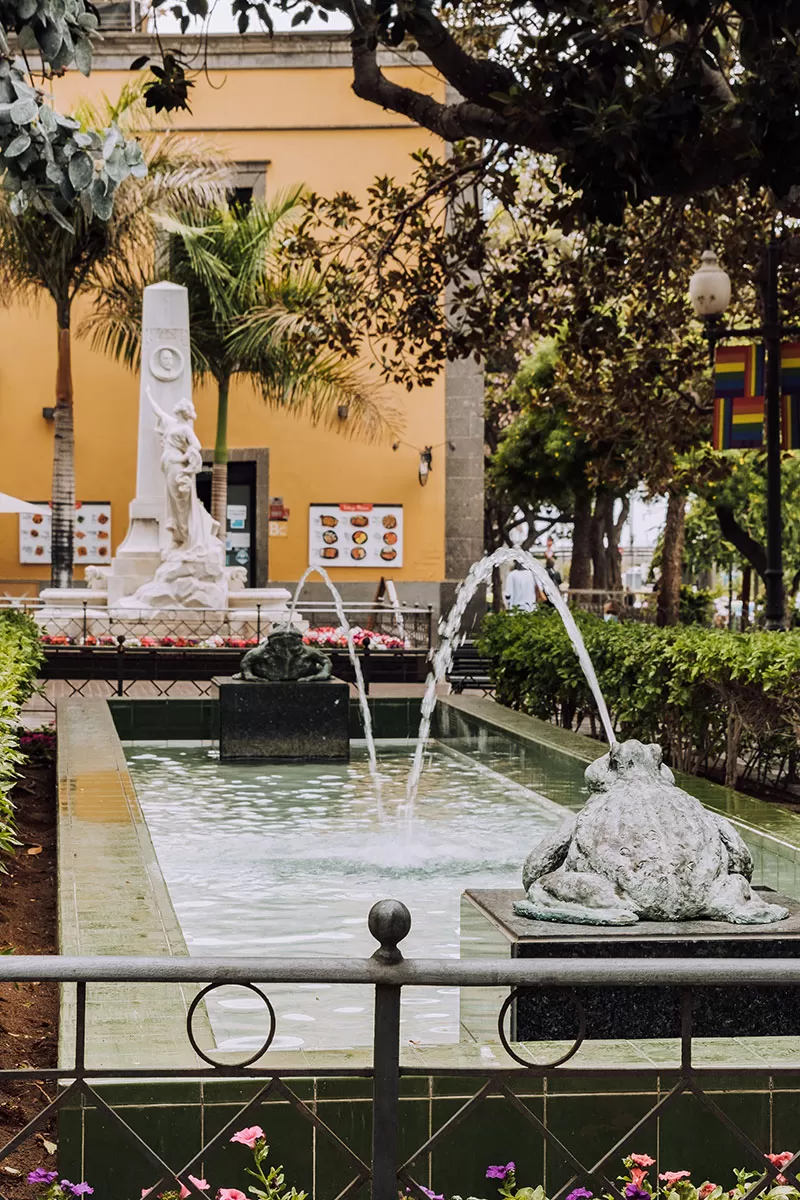
Plaza de las Ranas
The area, which sits opposite the colorful city market, Mercado de Vegueta, has long been a commercial district. European merchants have made their home here since the middle-ages, which accounts for the lavishly designed buildings that define the neighborhood.
It’s not all about shopping in Triana. One of my favorite things to do in Gran Canaria is take in a show at Teatro Pérez Galdós. Named after the fabled Spanish writer Benito Pérez Galdós, the leading cultural venue on the island houses a sizable auditorium and a diverse musical program, ranging from jazz to opera. Check their website for updated events.

Palacete Rodríguez Quegles
Tip: If the works of Pérez Galdós interest you, be sure to visit the nearby Casa Museo de Pérez Galdós. For more details, visit the official website. Other landmarks to squeeze in are the Palacete Rodríguez Quegles, a chic and relatively new addition to the cityscape. Built in 1901, the council-owned building is now a cultural venue.
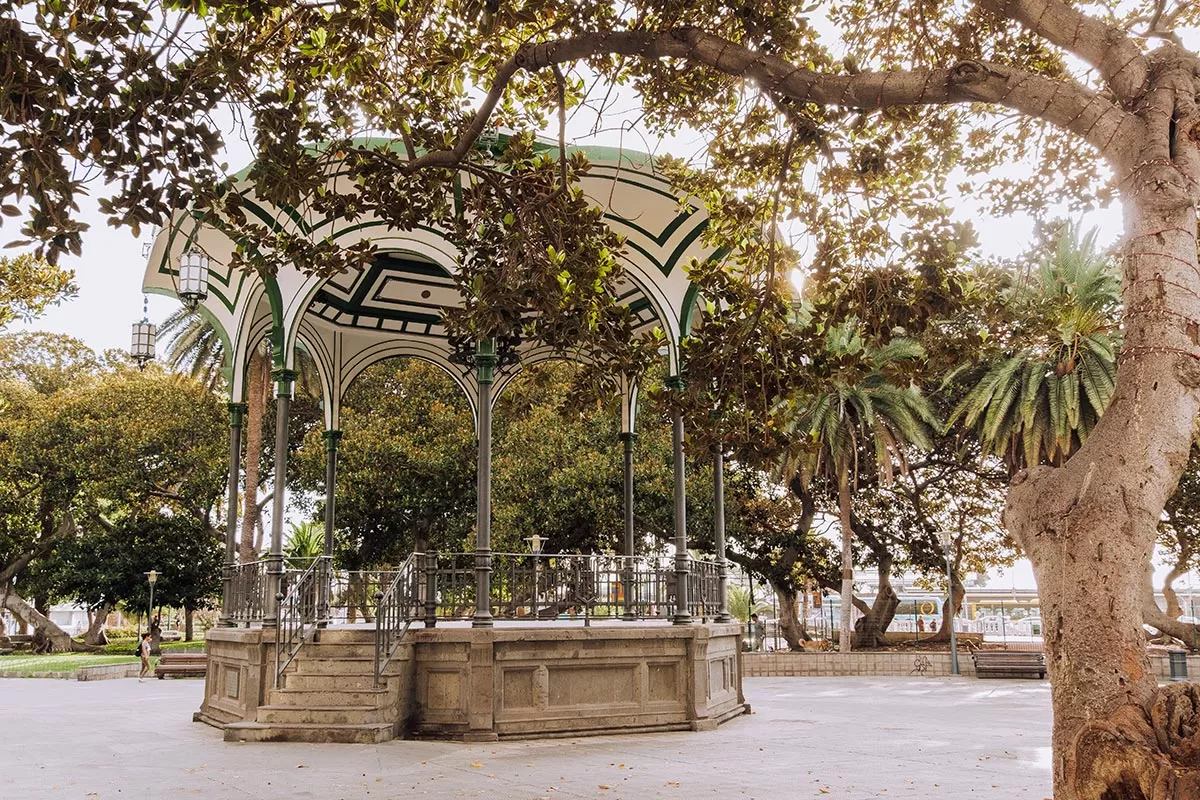
Parque San Telmo
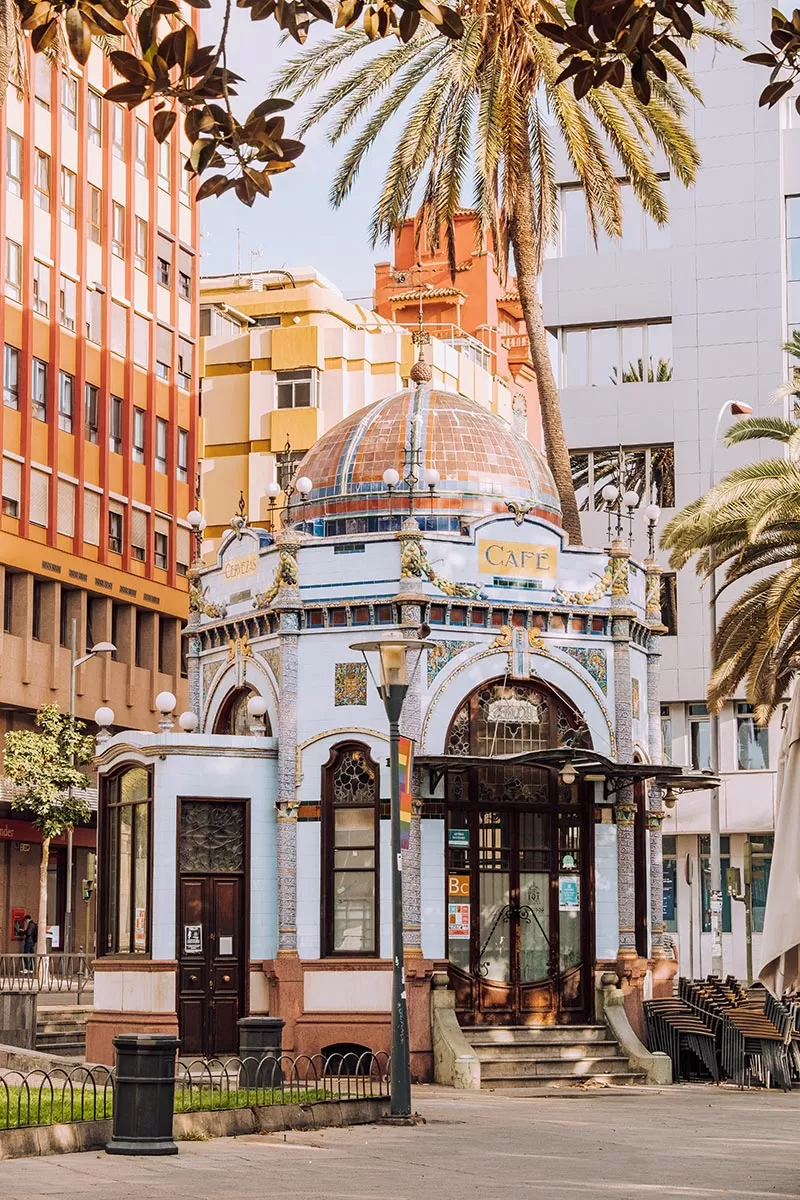
El Modernista – San Telmo – Parque San Telmo
After stomping over so many cobbles, a break might be in order at this point. The spacious La Alameda de Colón is the place to go. This leafy square has a playground for children and shaded benches to enjoy ice cream from one of the vendors on Calle Triana.
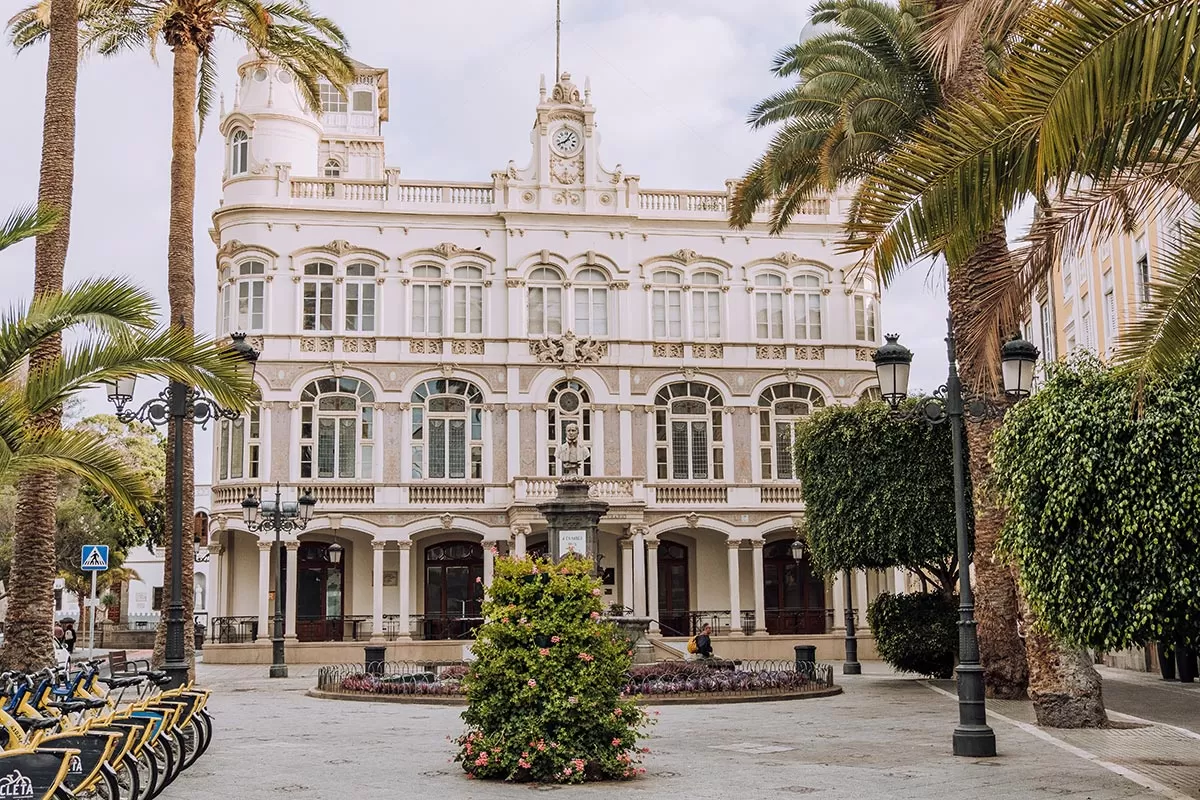
Literary Cabinet (Gabinete Literario)
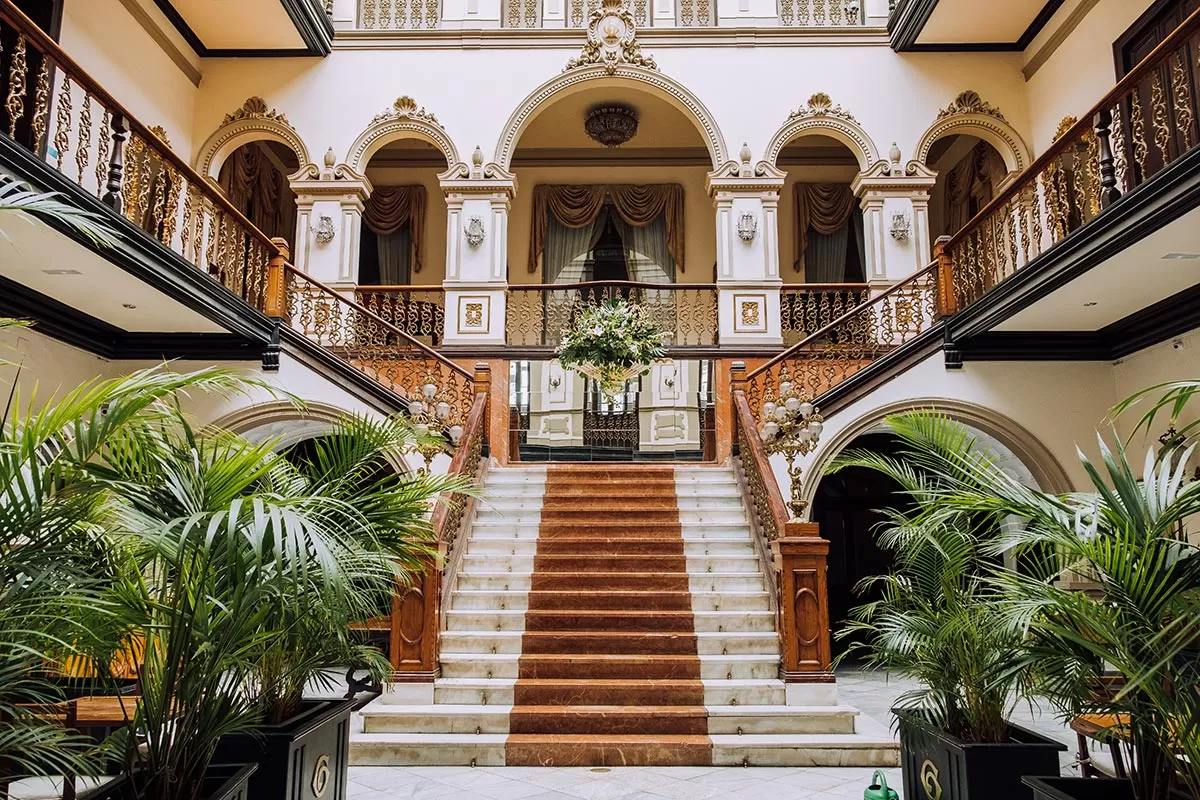
Inside the Literary Cabinet (Gabinete Literario)
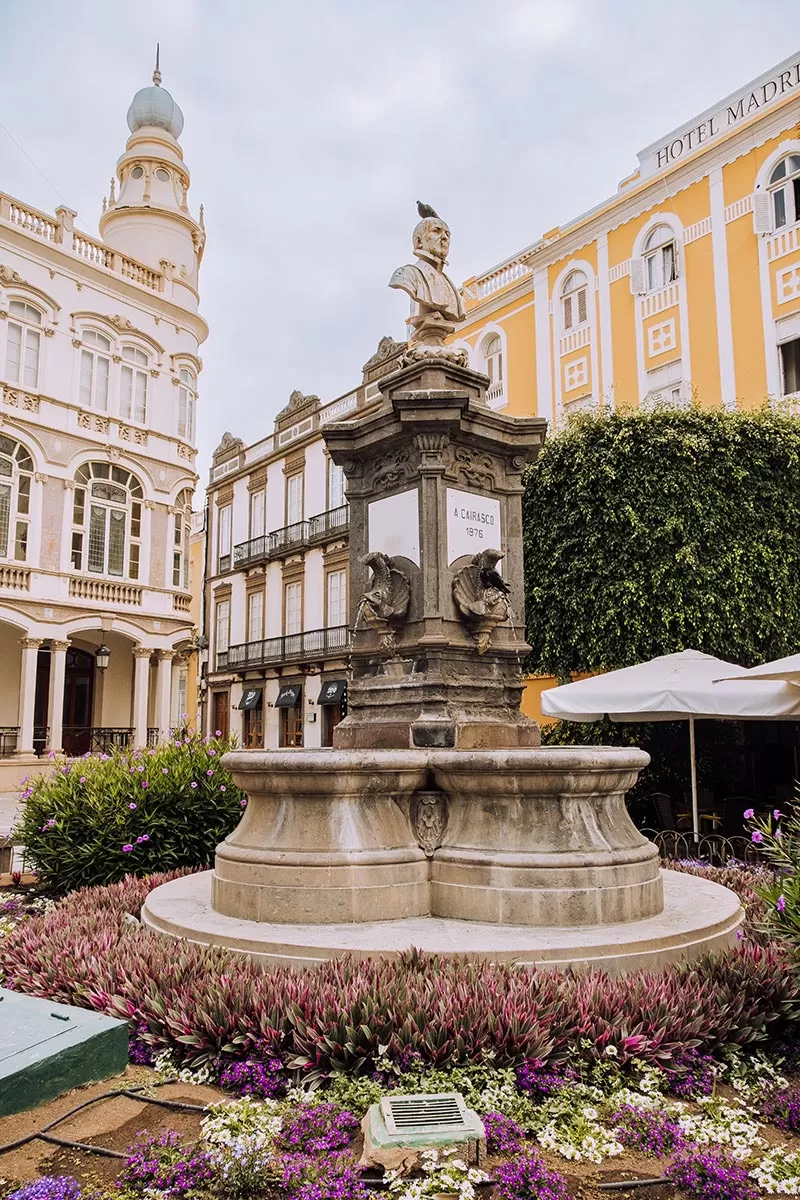
Fountain in front of the Literary Cabinet (Gabinete Literario)
Alternatively, stop at Gabinete Literario (Literary Cabinet). This cultural and literary center is a magnificent landmark building and must be seen. But it also hides a lovely restaurant with a tasty menu and delectable views. For more details visit the official website. Of all the things to do in Gran Canaria, a walking tour of these two magical quarters is very much at the top of this list.
2. Soak up the vibrant atmosphere on Playa de la Canteras
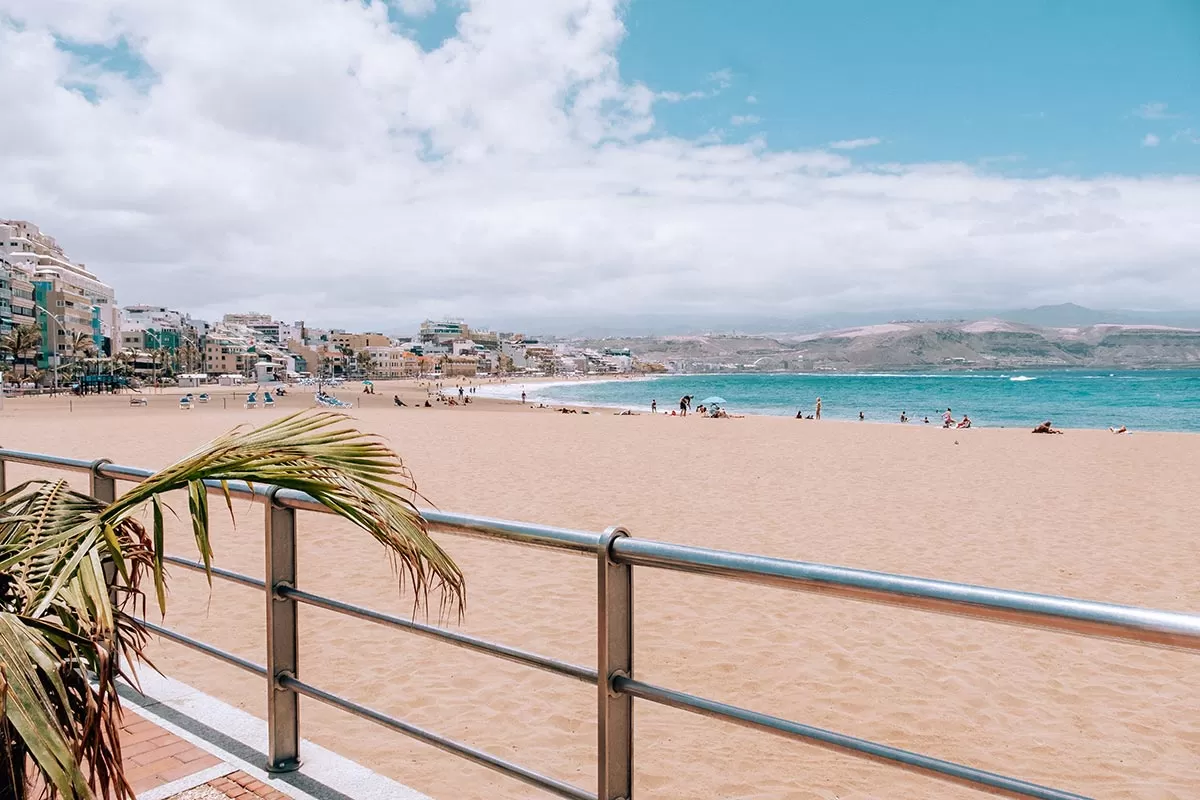
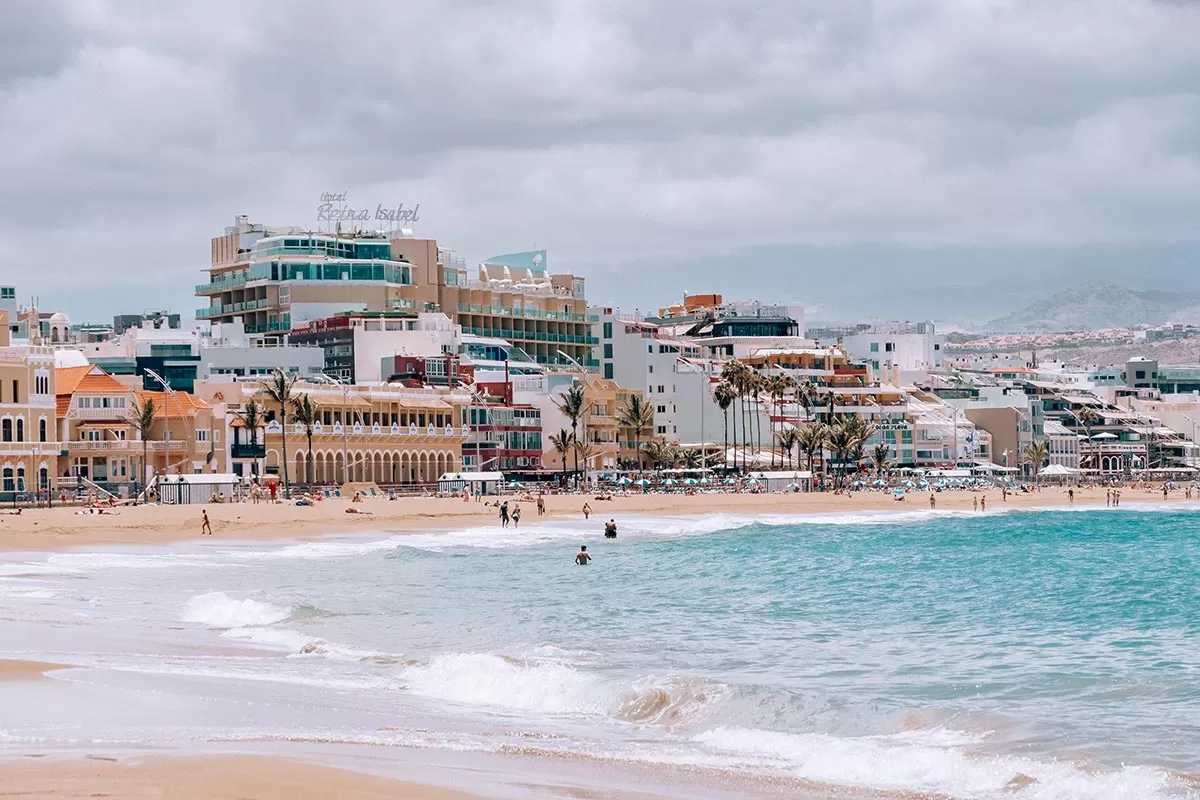 Predictably, beaches figure prominently on most checklists of things to do in Gran Canaria. And we look at some of the best as we move through this guide. But first we will start with one of my favorites, Playa de la Canteras.
Predictably, beaches figure prominently on most checklists of things to do in Gran Canaria. And we look at some of the best as we move through this guide. But first we will start with one of my favorites, Playa de la Canteras.
The golden sands of Canteras beach stretch for 1.2 miles (2 km) around the edge of the urban conurbation. Despite bordering the bustling metropolis, the beach is clean and welcoming. If you look out over the water, you could imagine being on a beach far from the island’s capital.
The appeal of this beach is you have all the city facilities on your doorstep. Rows of bars and restaurants line the busy promenade. It‘s a great place to spend time, day or night.
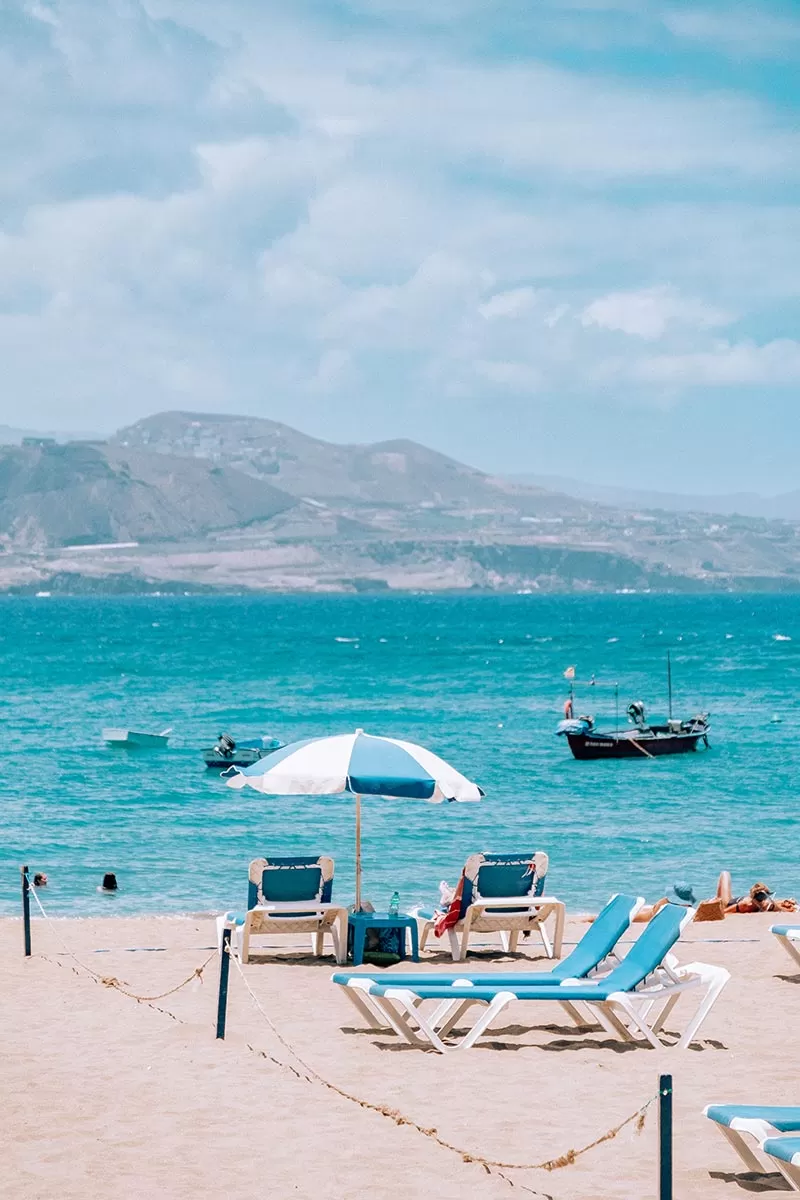
As a city beach, there are playgrounds, sports courts, and showers. Plus, ever-present lifeguards. Curving around the bay and protected by a natural volcanic marine shelf, the waters are calm and crystal clear. Marine life is abundant, and snorkeling is top-tier. It is rare to find such a pretty urban beach, but Playa de la Canteras is right up there with the best.
3. Enjoy a tapas lunch at Piscos & Buches in the foodie heaven of Mercado del Puerto
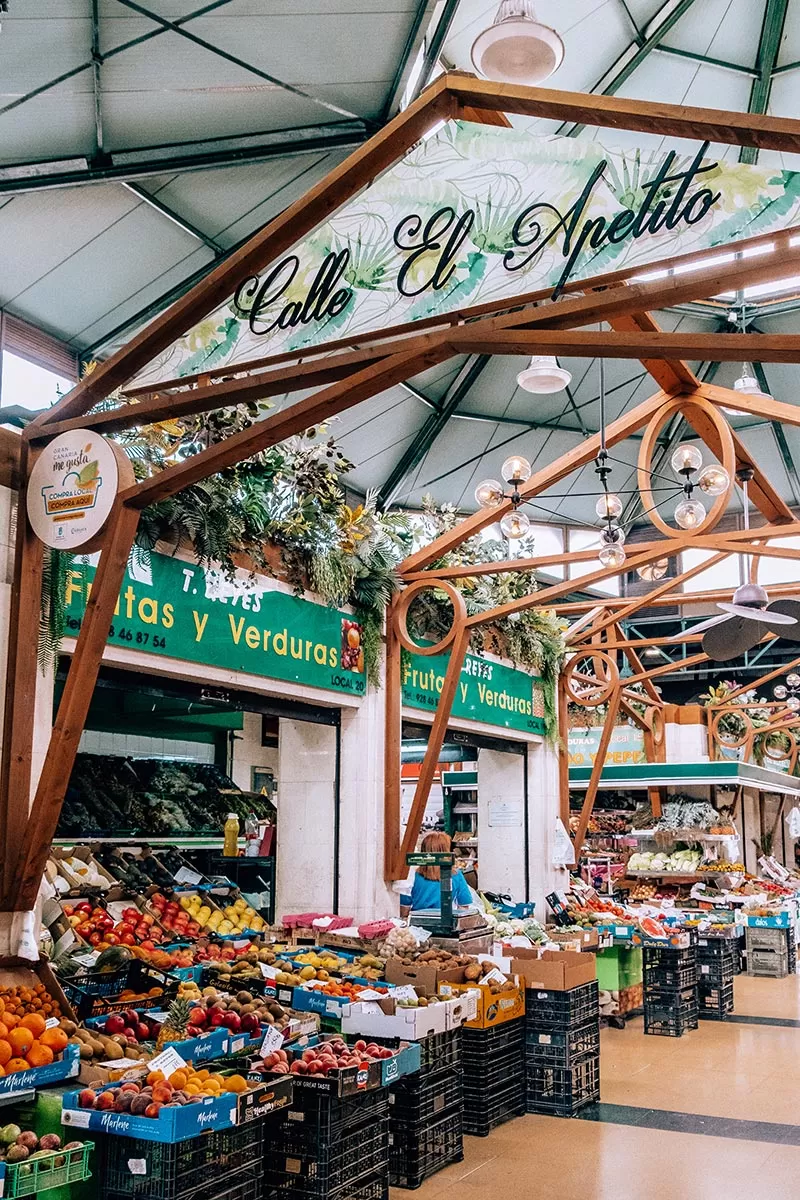
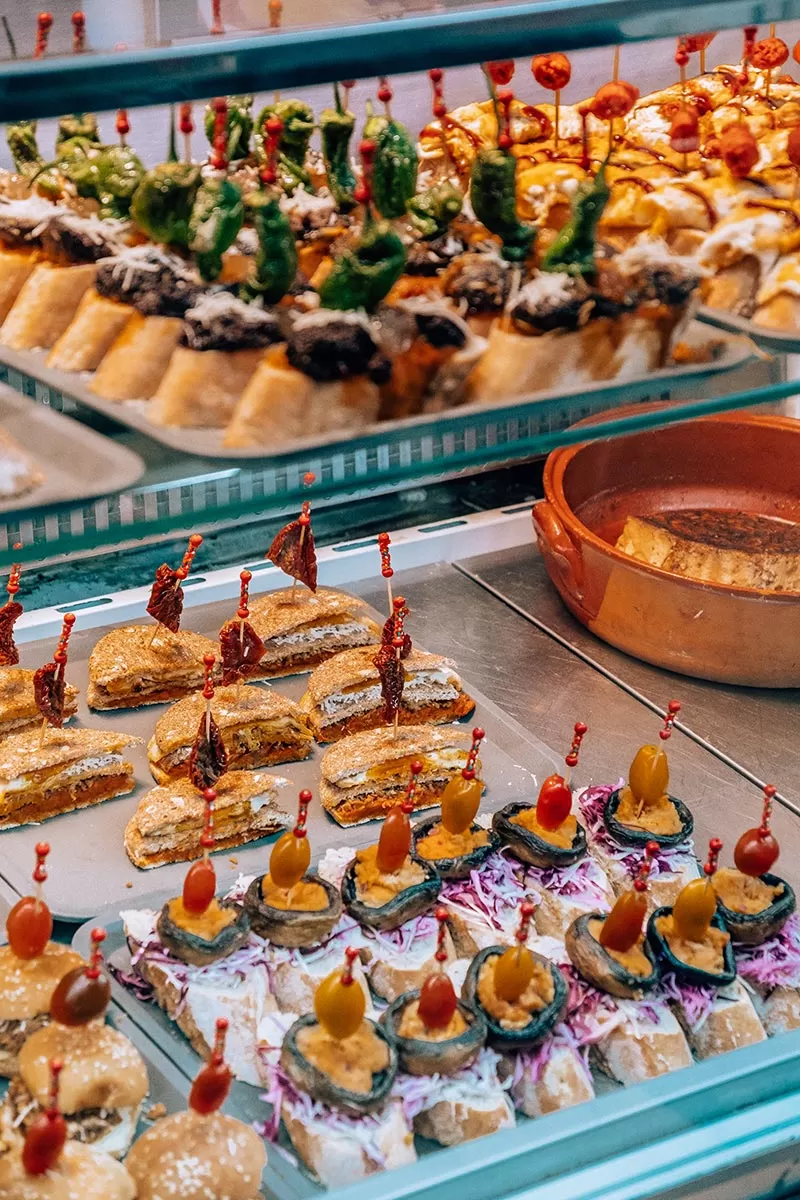 Wherever you go in Spain, there is usually a buzzing market that is a riot of color and gourmet delights. Close to the delightful Las Canteras Beach where you can go paragliding is another example, the Mercado del Puerto, which has emerged as one of the gastronomic temples in Las Palmas.
Wherever you go in Spain, there is usually a buzzing market that is a riot of color and gourmet delights. Close to the delightful Las Canteras Beach where you can go paragliding is another example, the Mercado del Puerto, which has emerged as one of the gastronomic temples in Las Palmas.
Designed by the team behind the Eiffel Tower, this modernist market of wrought-iron arches and immense character was built in 1891 on the site of an existing market.
Since 1991, the market in a fashionable urban neighborhood has divided its stalls. There is now a split between traditional produce sellers and kitchens serving local delicacies using the freshest of fresh ingredients.
It is one of the trendiest things to do in Gran Canaria, as locals and travelers feast at the outdoor terraces on fresh seafood, international dishes, and, above all, tapas.
For tapas to savor, try to grab a table at Piscos & Buches. The calamari is so fresh it might still be wriggling, and the wide selection and fresh and prepared tapas draw inspiration from across Spain. The laidback space and unpretentious style have placed Piscos & Buches firmly on the culinary map of Gran Canaria.
Even if you’re not hungry, the market is filled with enticing sights and smells close to one of the coolest urban beaches you’ll find. My advice, come here with an appetite. You won’t regret it.
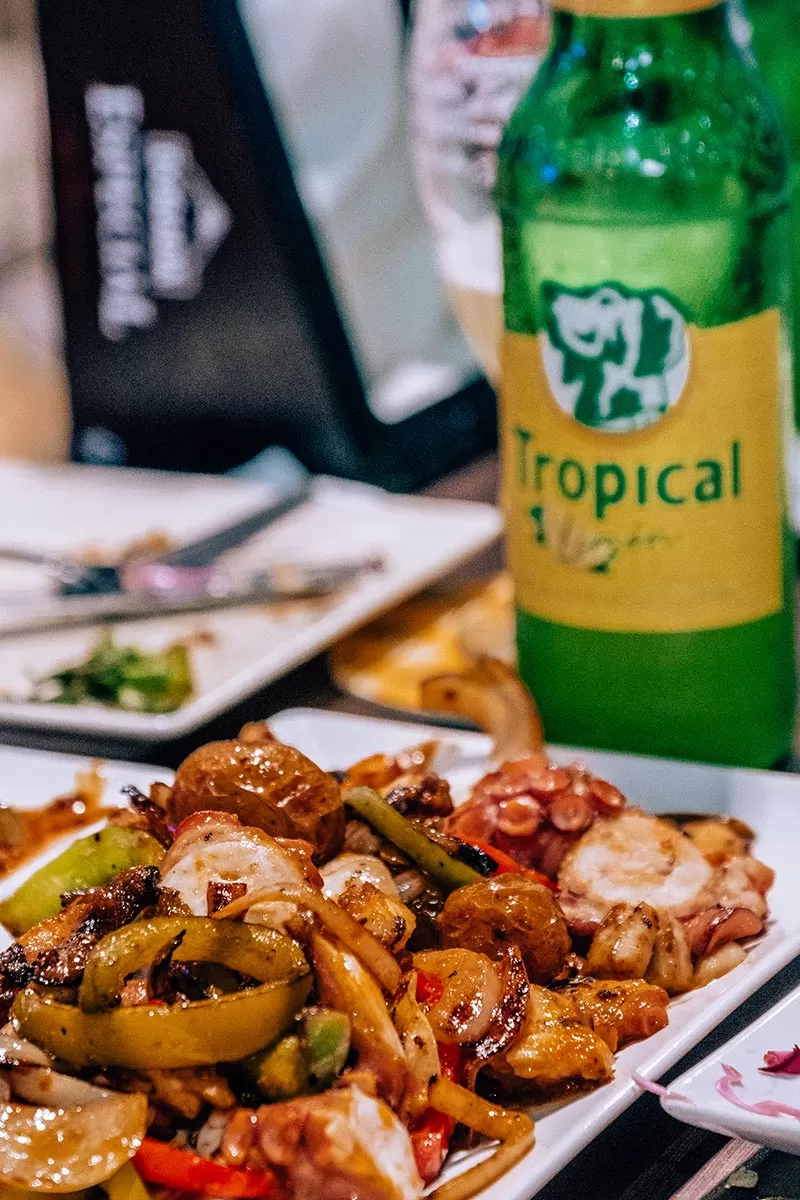
Seafood at Piscos & Buches
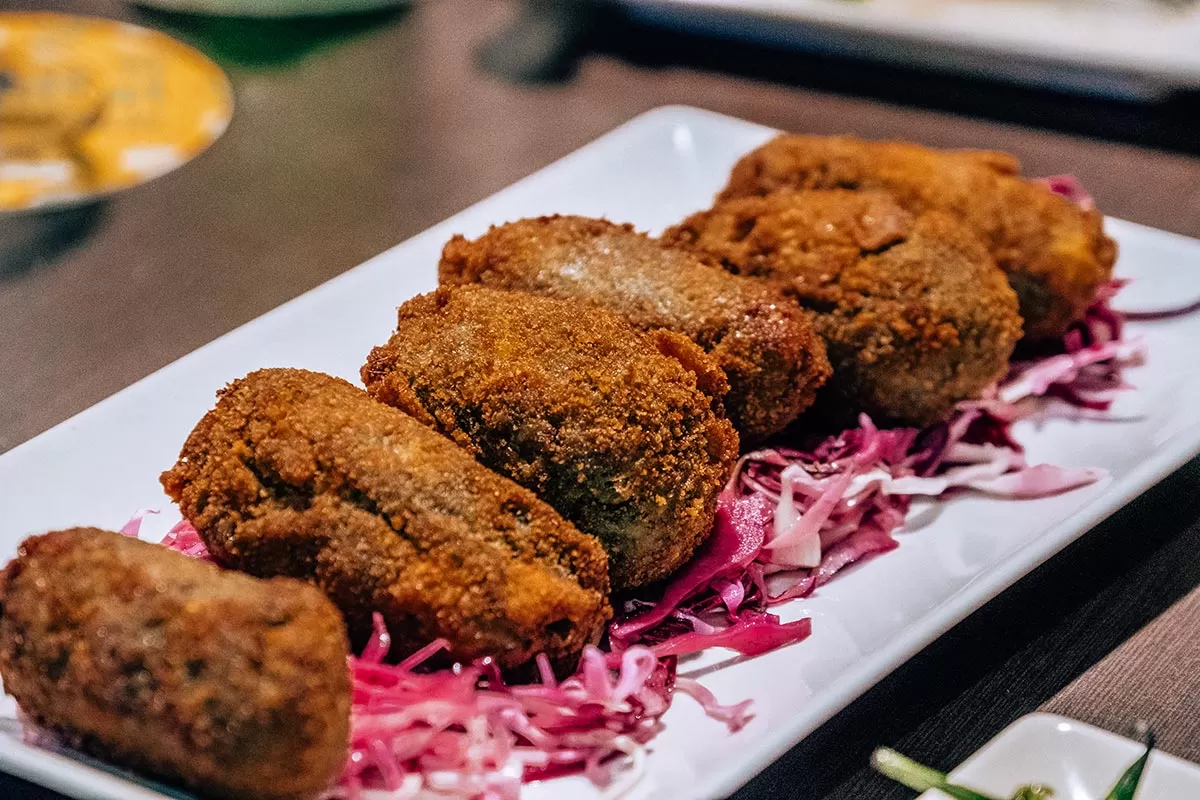
Croquettes at Piscos & Buches
Info for Mercado del Puerto:
- Monday – 12 pm to pm
- Tuesday to Thursday – 12 pm to 12 am
- Friday and Saturday – 12 pm to 12 am
- Sunday – 12 pm to 5 pm
- nº76, C. Albareda, 35008 Las Palmas de Gran Canaria
- For more details, visit the official website.
4. Enjoy sumptuous views and Michelin-starred dining at the elegant Santa Catalina hotel
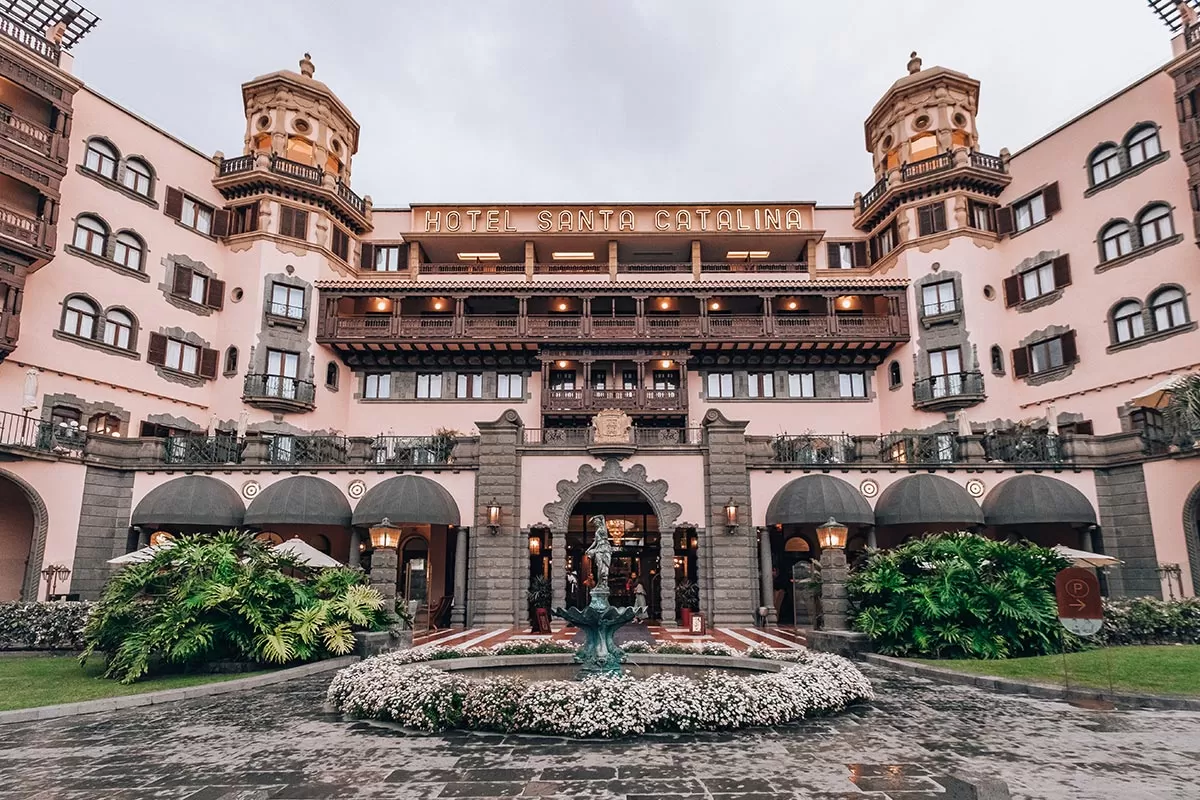
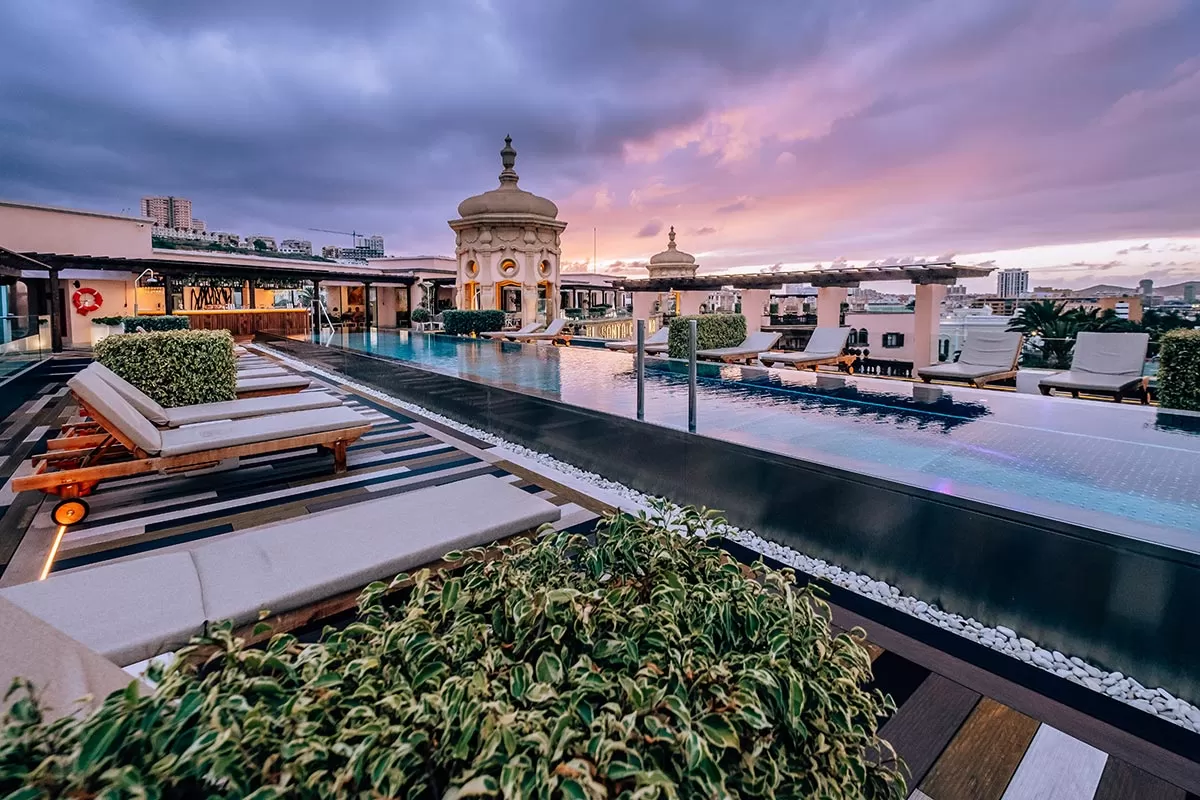 The down-to-earth dining experience at Mercado del Puerto is a winner for gastronomes. But if you’re looking to take things up a level, consider including Santa Catalina in your vacation plans. A member of the chic Barceló Group hotel chain, this 5-star delight is more than just another swanky hotel. The iconic building is one of the oldest hotels in Gran Canaria, recently transformed by an extensive renovation.
The down-to-earth dining experience at Mercado del Puerto is a winner for gastronomes. But if you’re looking to take things up a level, consider including Santa Catalina in your vacation plans. A member of the chic Barceló Group hotel chain, this 5-star delight is more than just another swanky hotel. The iconic building is one of the oldest hotels in Gran Canaria, recently transformed by an extensive renovation.
The complex has three excellent restaurants, a piano bar, and a magical rooftop bar. The headline stealer is the haute-cuisine Poemas restaurant, which was recently awarded a Michelin Star. Overseen by the feted Padrón brothers, the refined setting welcomes guests on a culinary tour de force that absorbs influences from several counties.
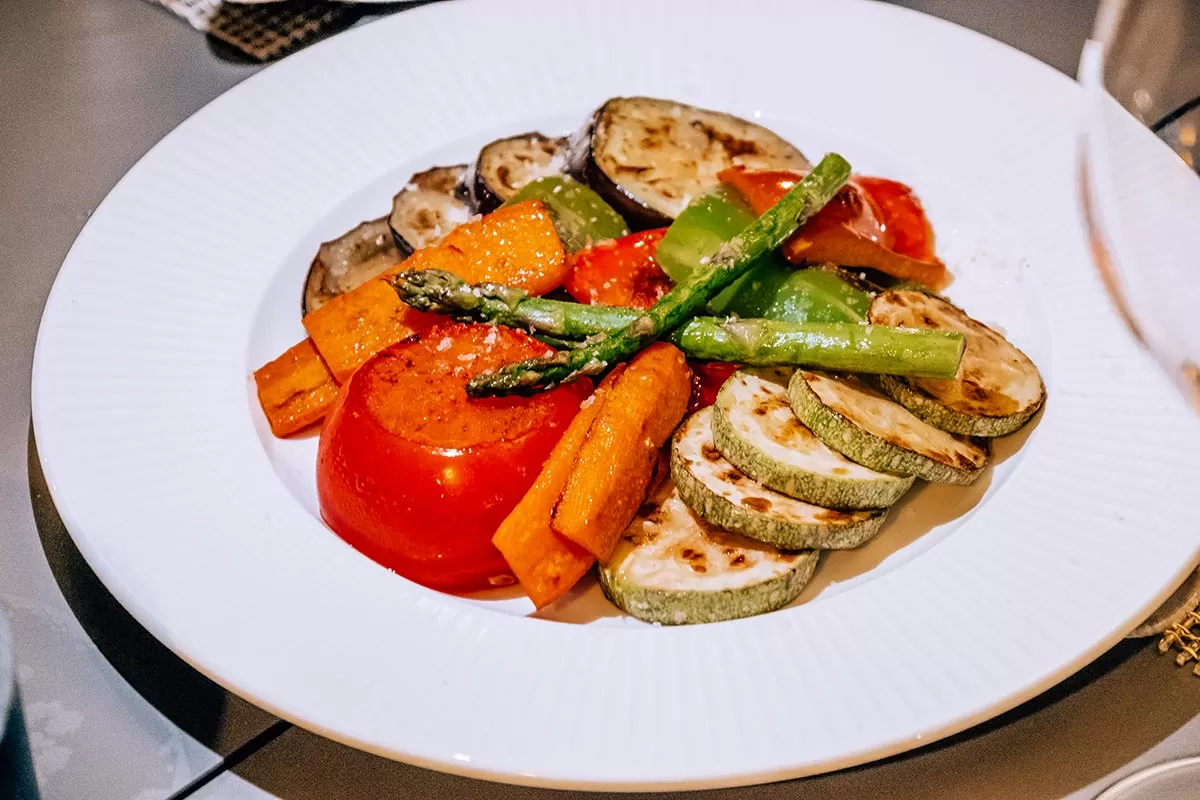
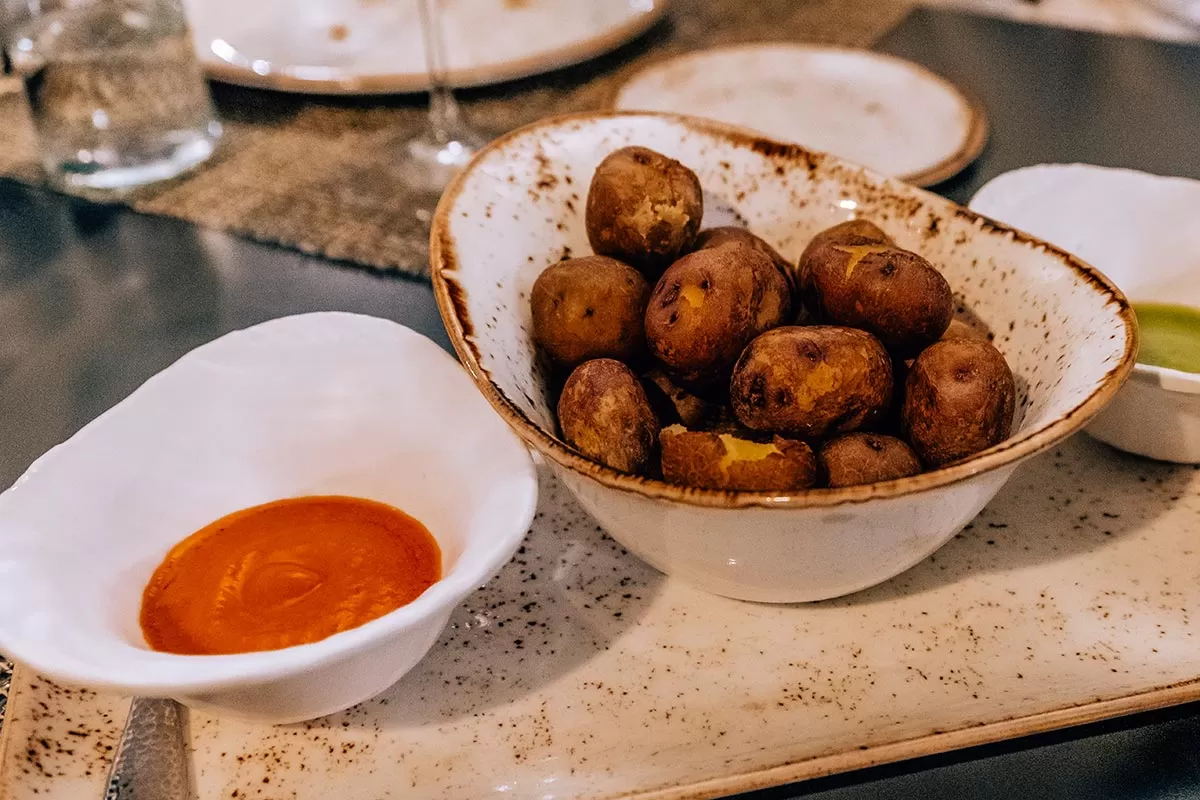
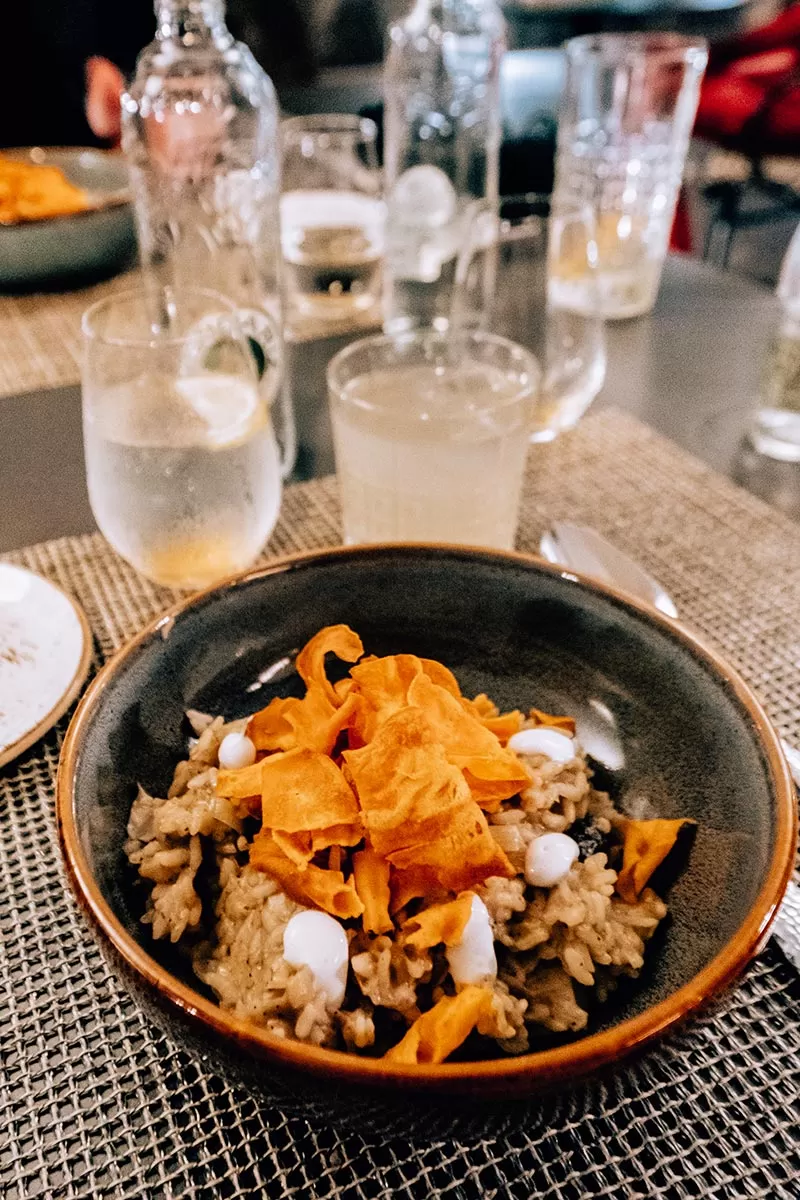
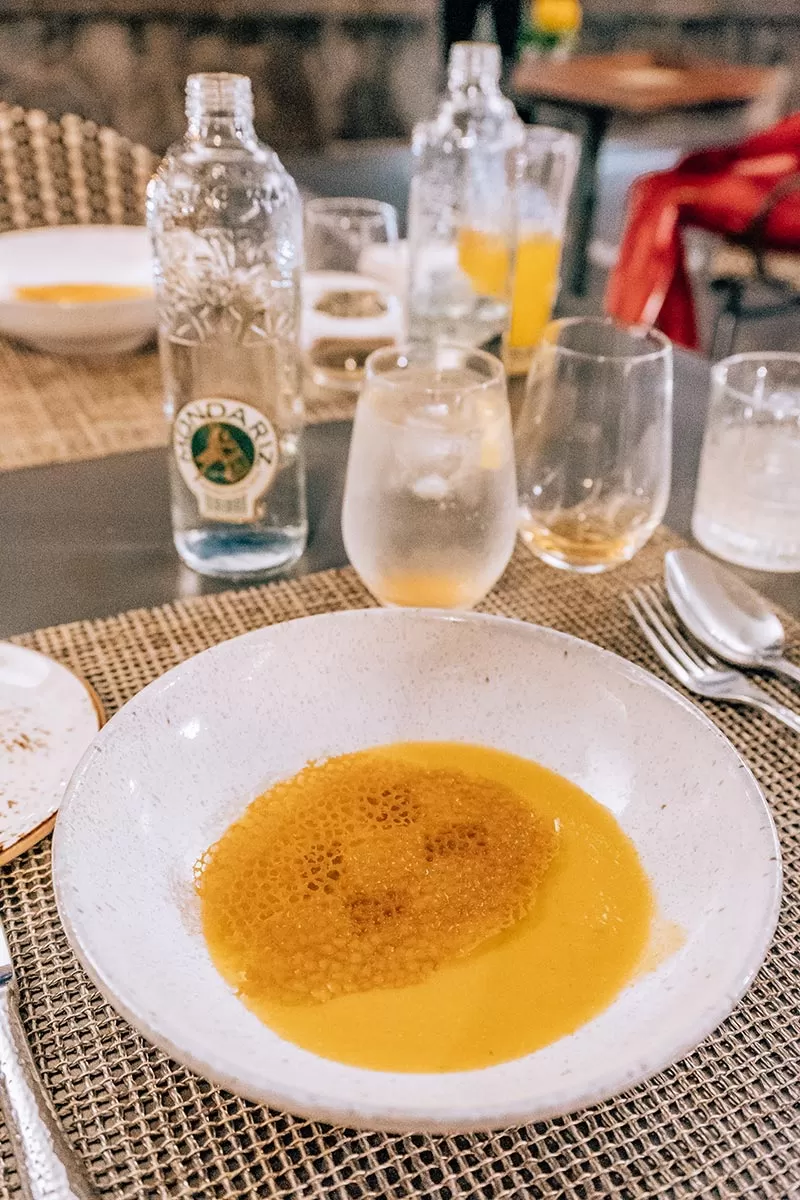
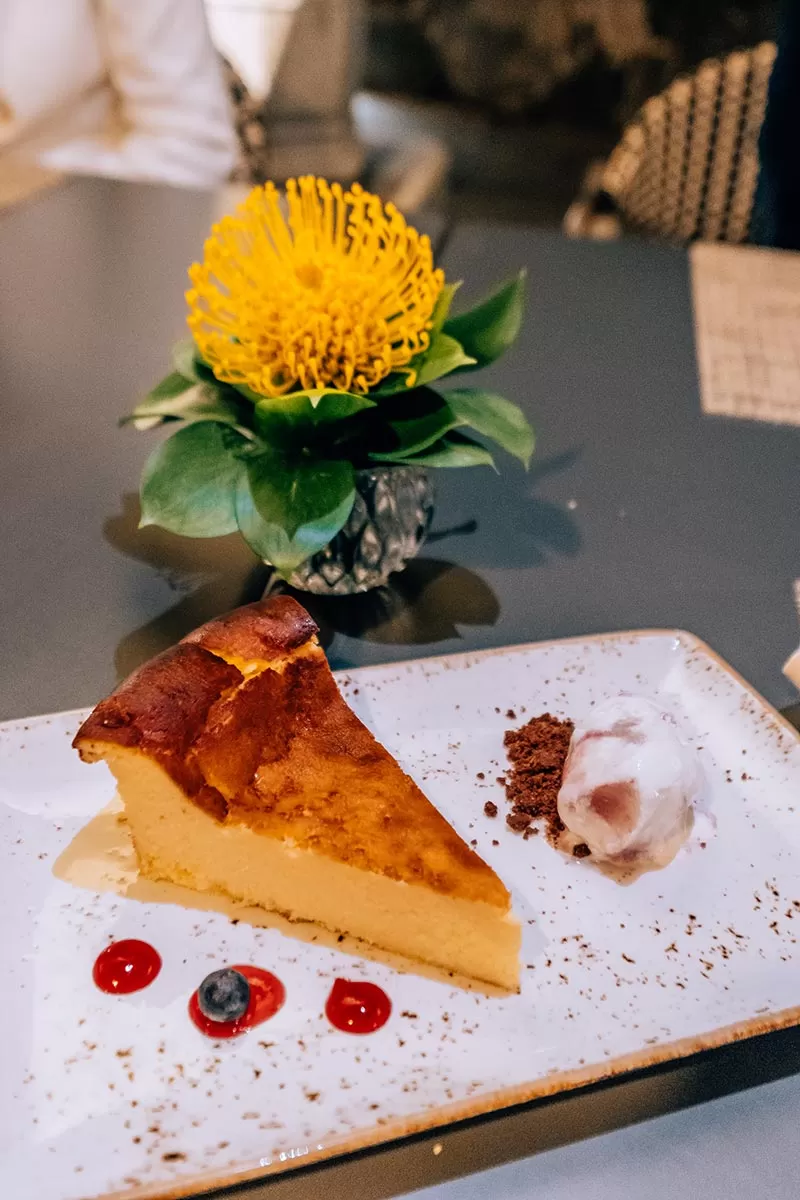
The supporting cast of dining options includes the 1890 La Bodeguita, a tapas bar that spills onto a patio in the hotel garden. You can find cheaper tapas bars around Las Palmas, but this is as close to gourmet as tapas gets.
For less gut (and budget) busting Mediterranean fare, the suite of restaurants is completed by Camarote. Simply translated as Cabin, Camarote is a sexy poolside café that enjoys views over the picturesque Parque Doramas adjacent to the hotel.
If you want to skip dinner, the rooftop Ali’s bar with an alluring infinity pool is a slice of paradise reimagined. Ali’s bar is exclusive enough that only guests with a VIP pass can drink here during the day. But after 5.30 pm, it opens to everybody. An idyllic spot to watch the sun set over Las Palmas Port and the sparkling waters below. And don’t forget the elegant piano bar for a relaxing nightcap.
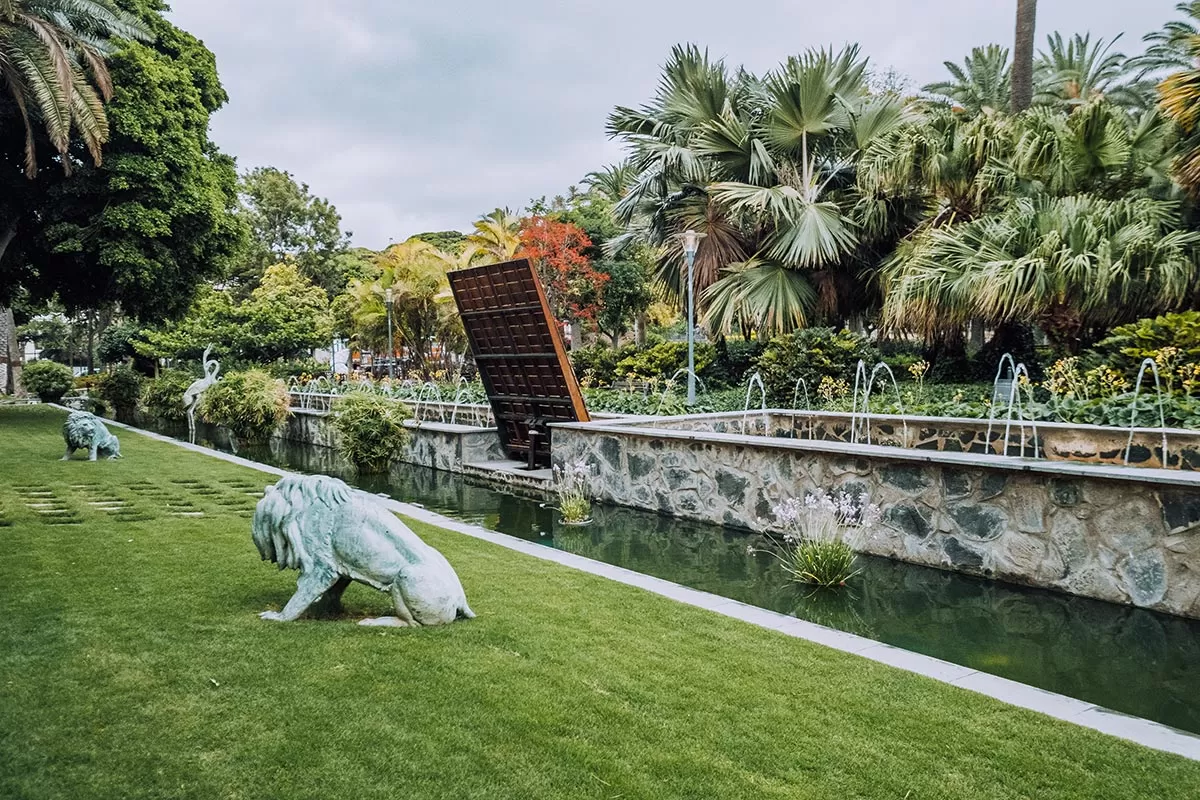 The Michelin-starred Poemas restaurant and rooftop Ali’s bar are reasons enough to recommend Santa Catalina hotel. But there are persuasive reasons to treat yourself to a room here.
The Michelin-starred Poemas restaurant and rooftop Ali’s bar are reasons enough to recommend Santa Catalina hotel. But there are persuasive reasons to treat yourself to a room here.
The hotel is ideally situated near my favorite beach, Las Canteras, and close to Las Palmas Marina and the island’s main airport. Exquisitely renovated, the terrace and balcony rooms overlook lush gardens. While a pool and spa lure guests to happily lose themselves without leaving the establishment.
One thing I can confidently say — wherever you stay in Gran Canaria, the bars and restaurants of Santa Catalina are irresistible.
Info for Santa Catalina hotel:
- Check availability and book your stay here
- C. León Y Castillo 227 35005 Las Palmas de Gran Canaria Spain
- Tel: +34 9 28 24 30 40
- Opening hours vary from bar to restaurant. Check online for times here
5. Head to pretty Puerto de las Nieves and bathe in idyllic natural swimming pools
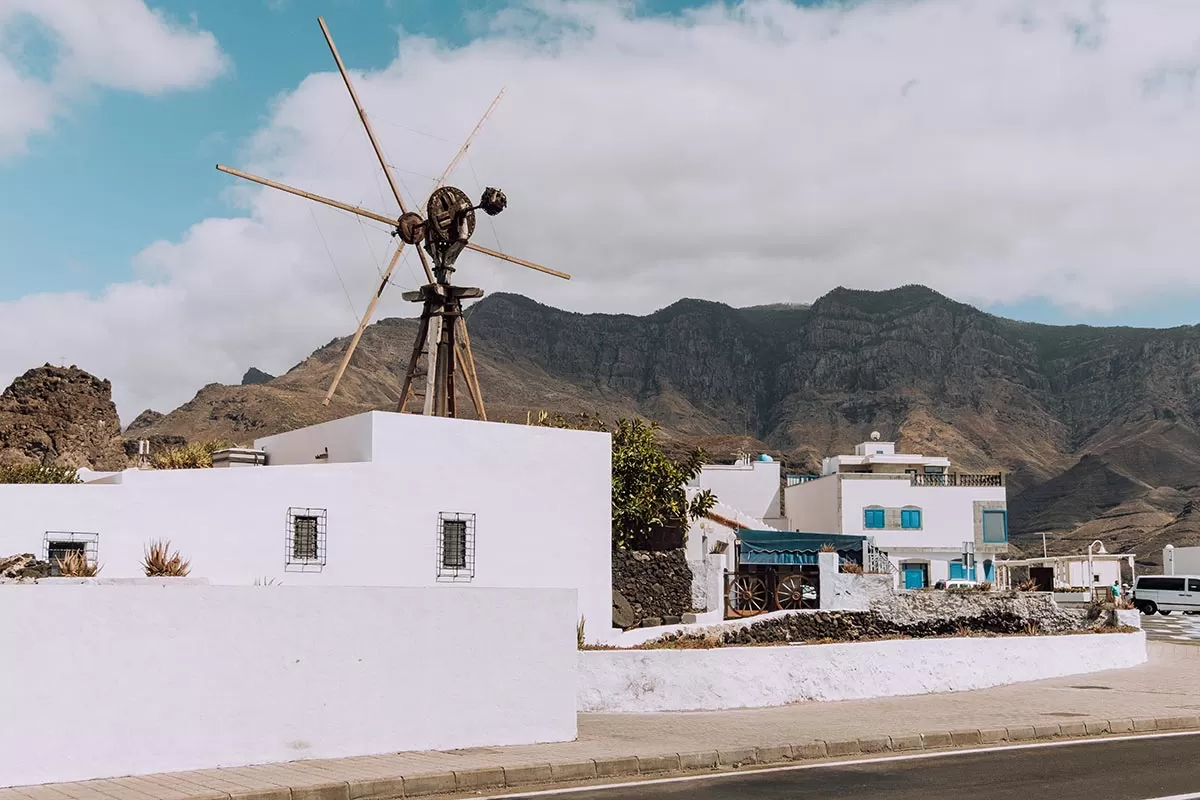
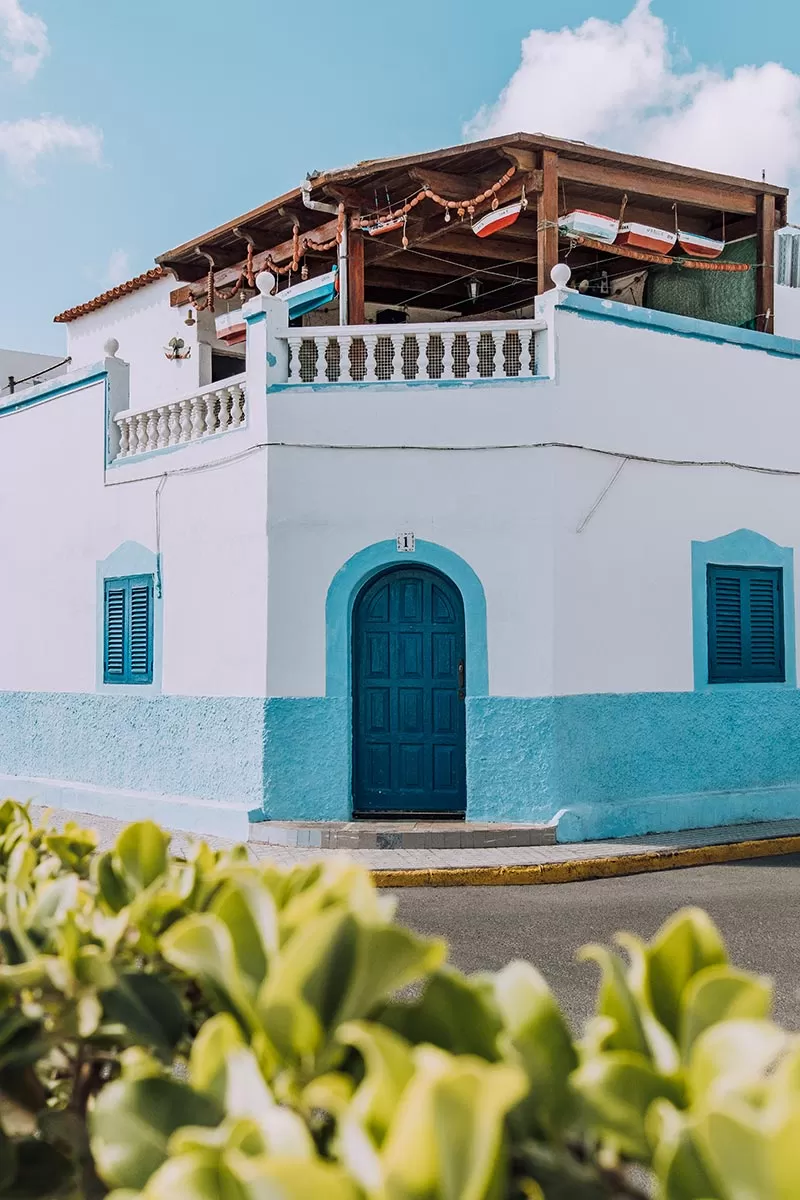
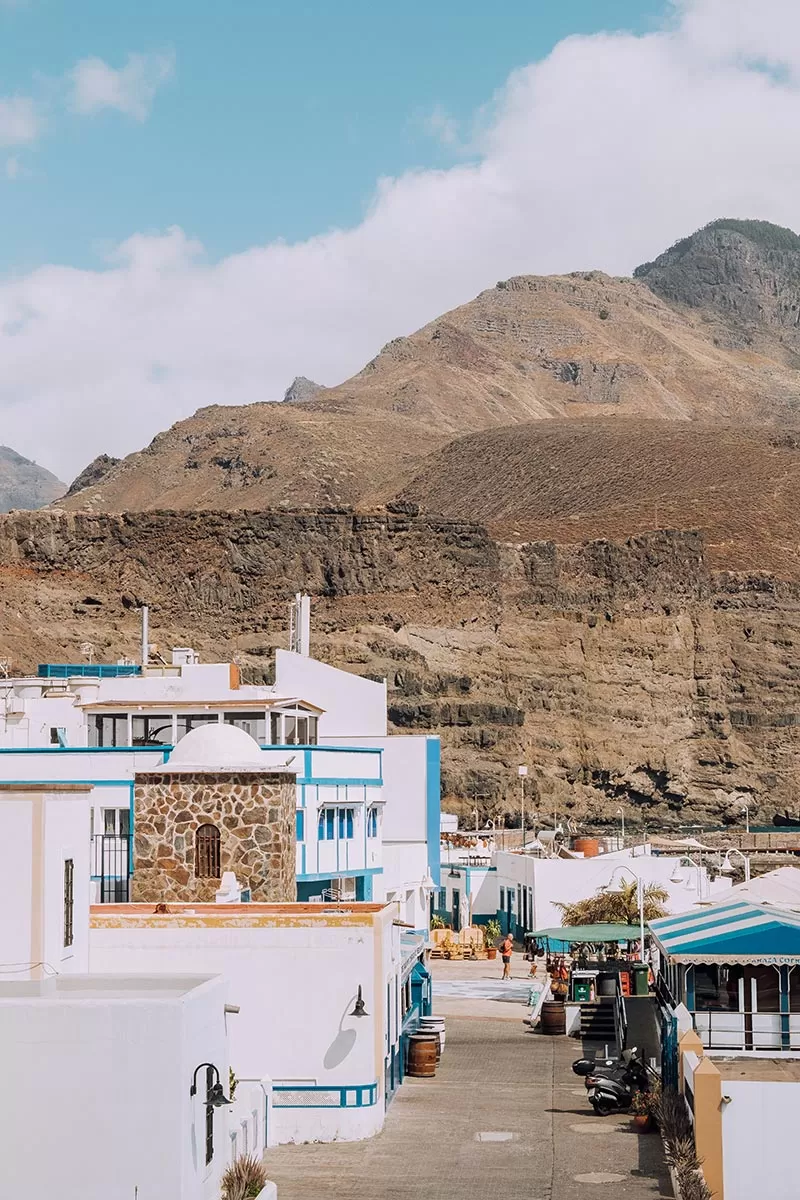
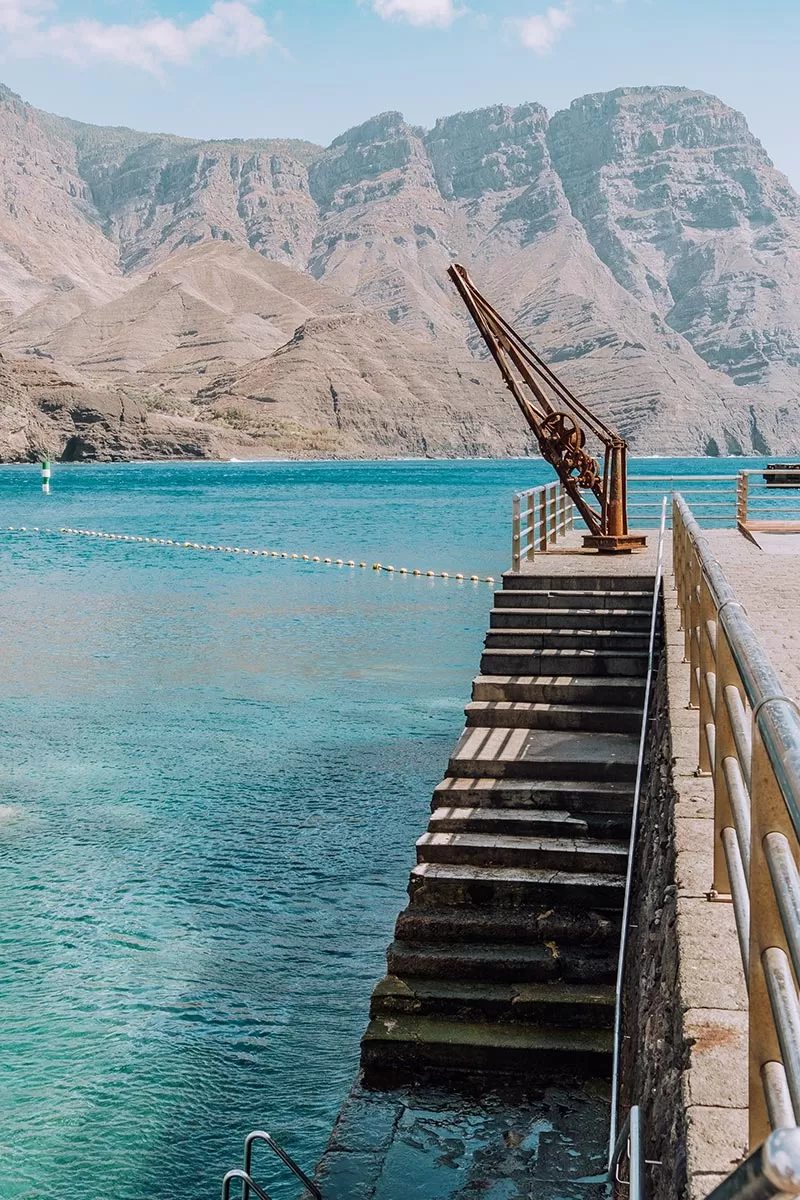 At the northwest tip of Gran Canaria, about 21 miles (33.5 km) from Las Palmas, is the charming fishing village, Puerto de las Nieves. The village centers around its titular port and is attached to the sleepy town, Agaete. Both places are a world away from bustling Las Palmas. Savvy travelers head here to swim in the stunning natural pools at Agaete Piscina Natural.
At the northwest tip of Gran Canaria, about 21 miles (33.5 km) from Las Palmas, is the charming fishing village, Puerto de las Nieves. The village centers around its titular port and is attached to the sleepy town, Agaete. Both places are a world away from bustling Las Palmas. Savvy travelers head here to swim in the stunning natural pools at Agaete Piscina Natural.
The crystal clear pools of Agaete are formed from volcanic rock and sheltered from the tides. You may even find them quiet, although probably not during the height of summer. A dip in the inviting pools is essential, so bring your bathing gear to enjoy one of the most underrated things to do in Gran Canaria.
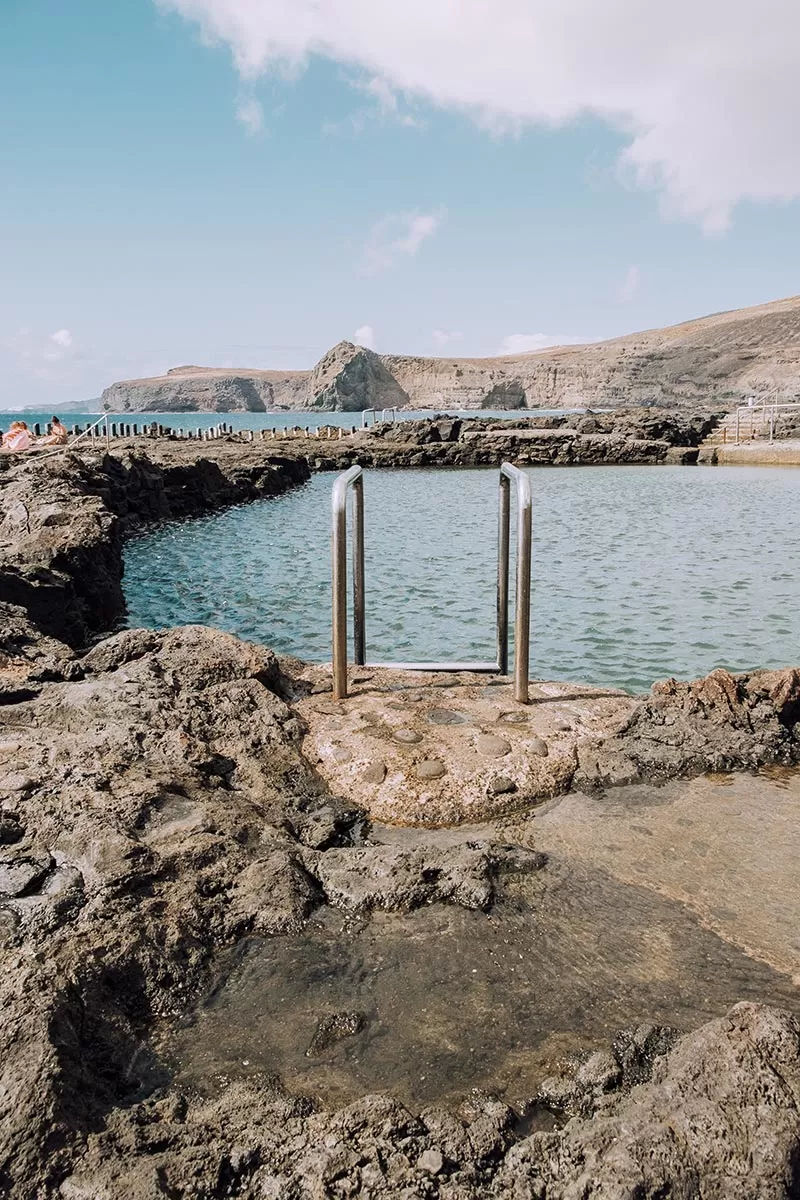
Go to the Natural swimming pools in Puerto de las Nieves
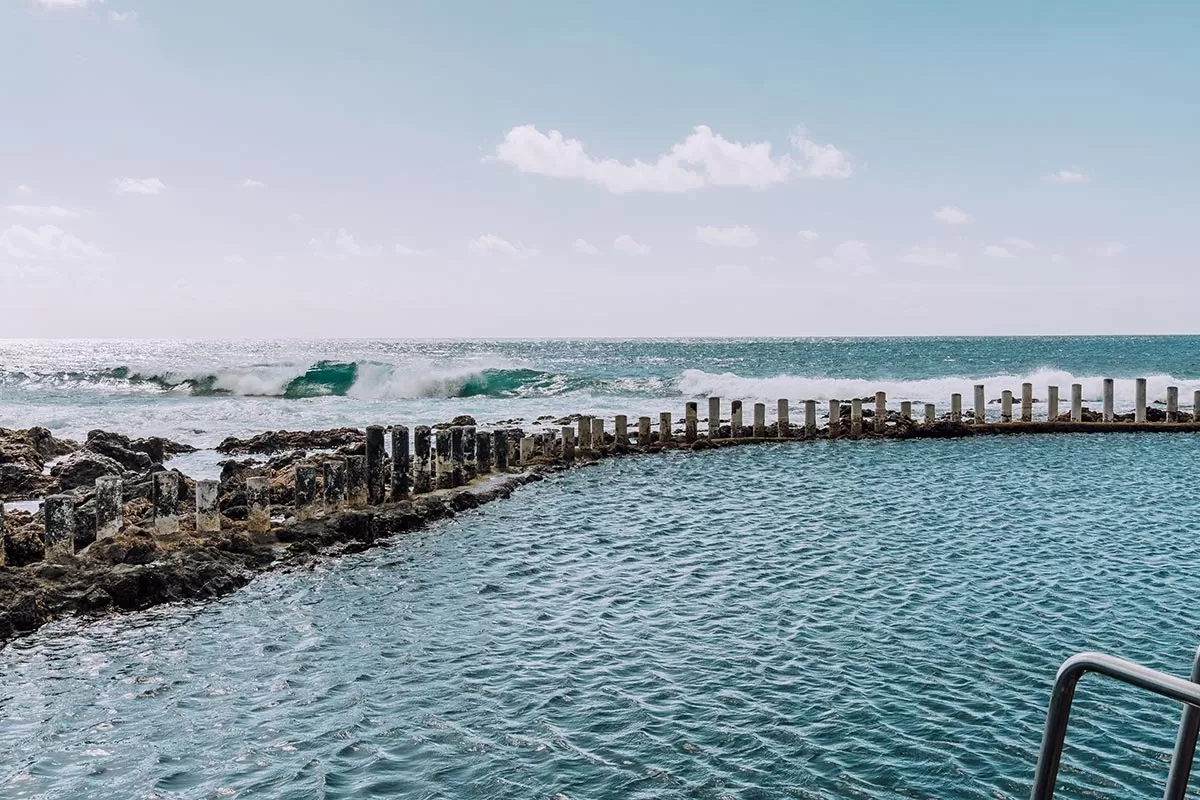
Fully invigorated after your splash in the waters of Agaete, head a short distance to Paseo de Los Poetas to sample fresh seafood. With the daily catch unloaded just a few feet away, the restaurants of Paseo de Los Poetas are ambrosia for lovers of seafood. Foodies will want to try the local specialty caldo de pescado, a thick and rich seafood soup.
A brisk stroll down the whitewashed Paseo de Los Poetas is a welcome post-dinner diversion. Dotted down the calm and narrow avenue are bars, restaurants, and the occasional shop. Along the way, you snatch views over the small and rocky, volcanic Agaete beach and the craggy hills that rise over the village.
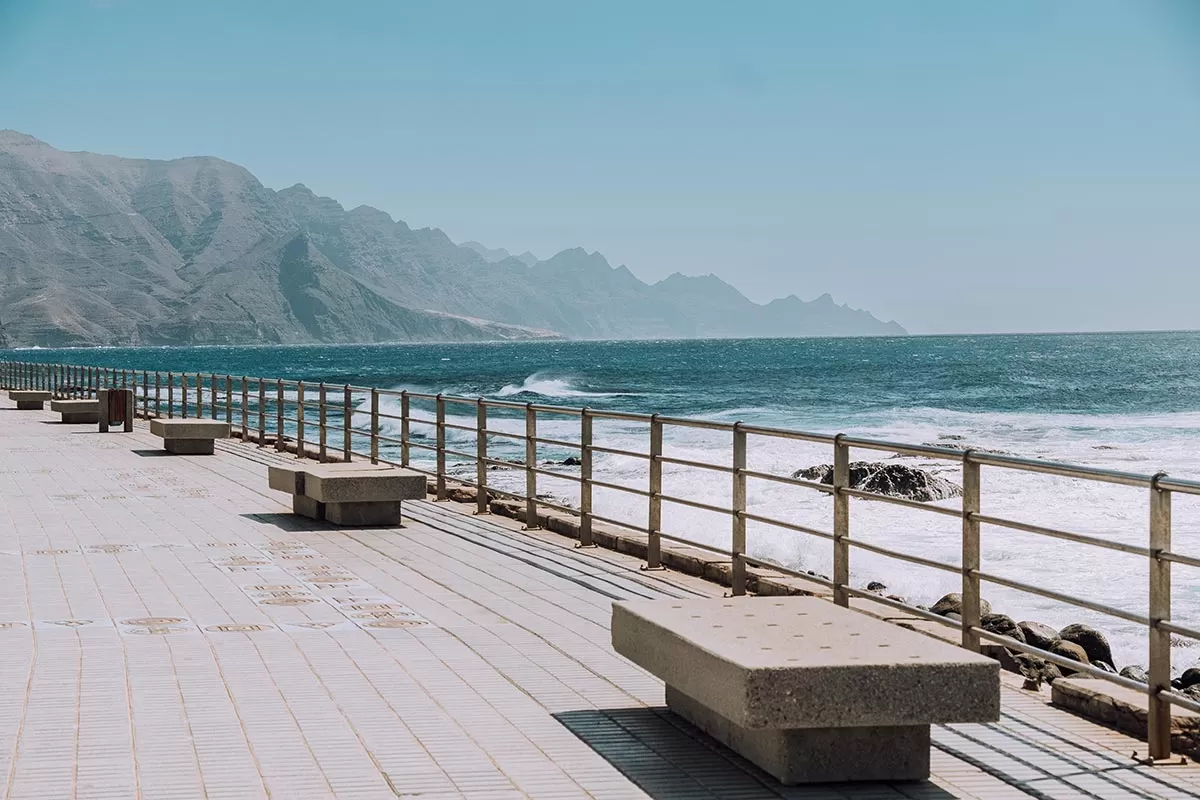
Walk along Paseo de Los Poetas
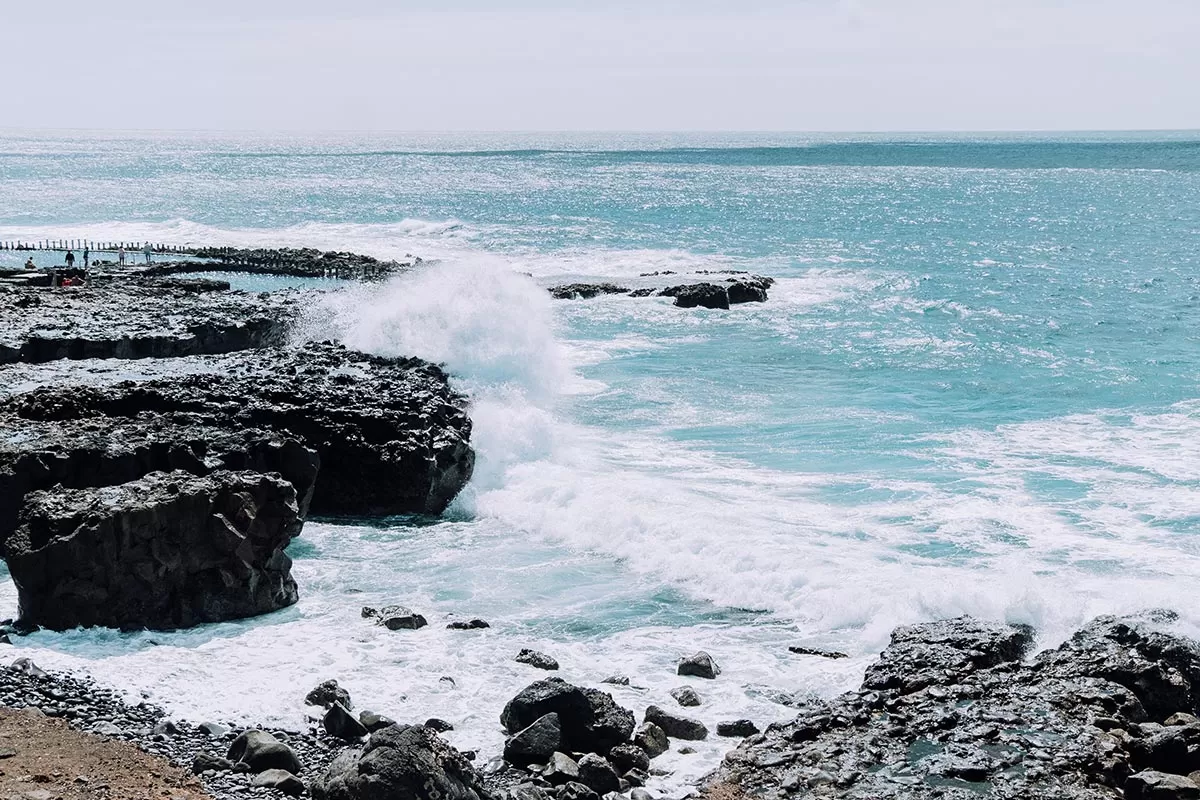
Natural swimming pools at Puerto de las Nieves
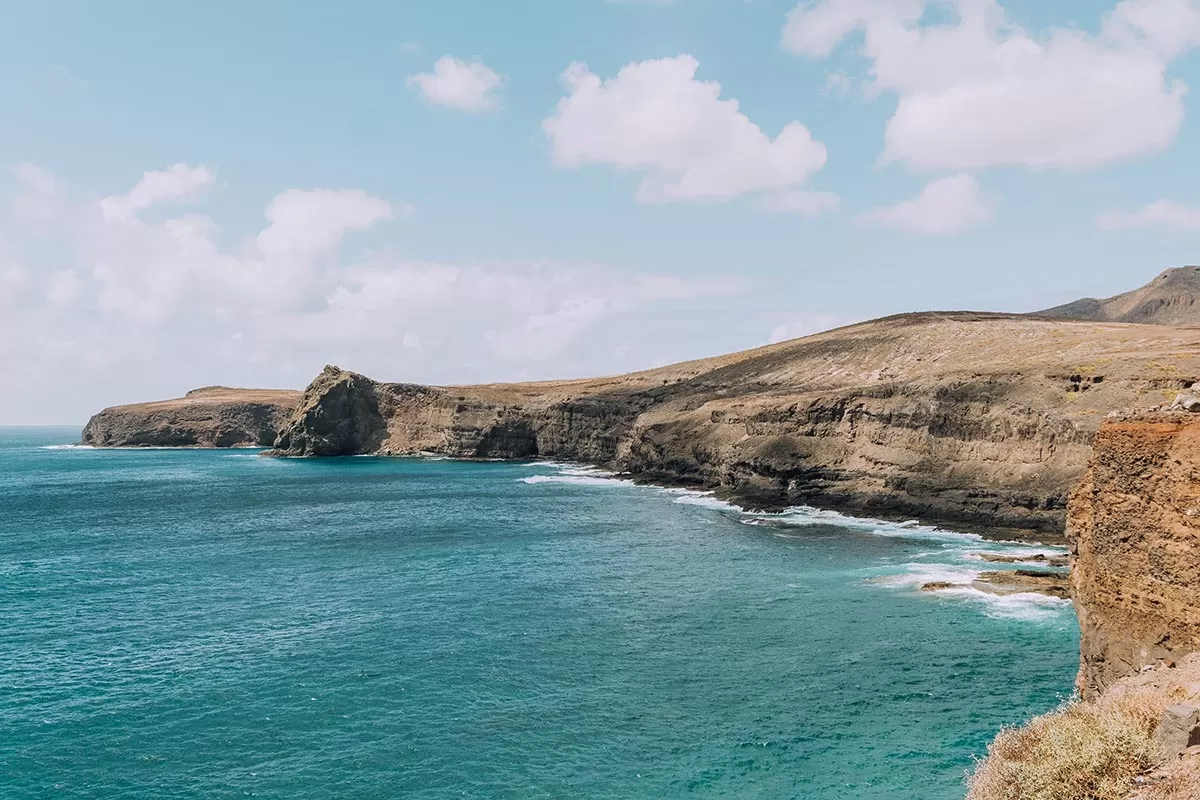 Look out for the diminutive Ermita de las Nieves church. It’s small but hides a celebrated 16th Century triptych by the Flemish artist Joos van Cleve. Every 4th of August, a copy of the work depicting the Virgin Mother and Jesus makes a public appearance at the annual Fiesta de la Rama, Festival of the Branch.
Look out for the diminutive Ermita de las Nieves church. It’s small but hides a celebrated 16th Century triptych by the Flemish artist Joos van Cleve. Every 4th of August, a copy of the work depicting the Virgin Mother and Jesus makes a public appearance at the annual Fiesta de la Rama, Festival of the Branch.
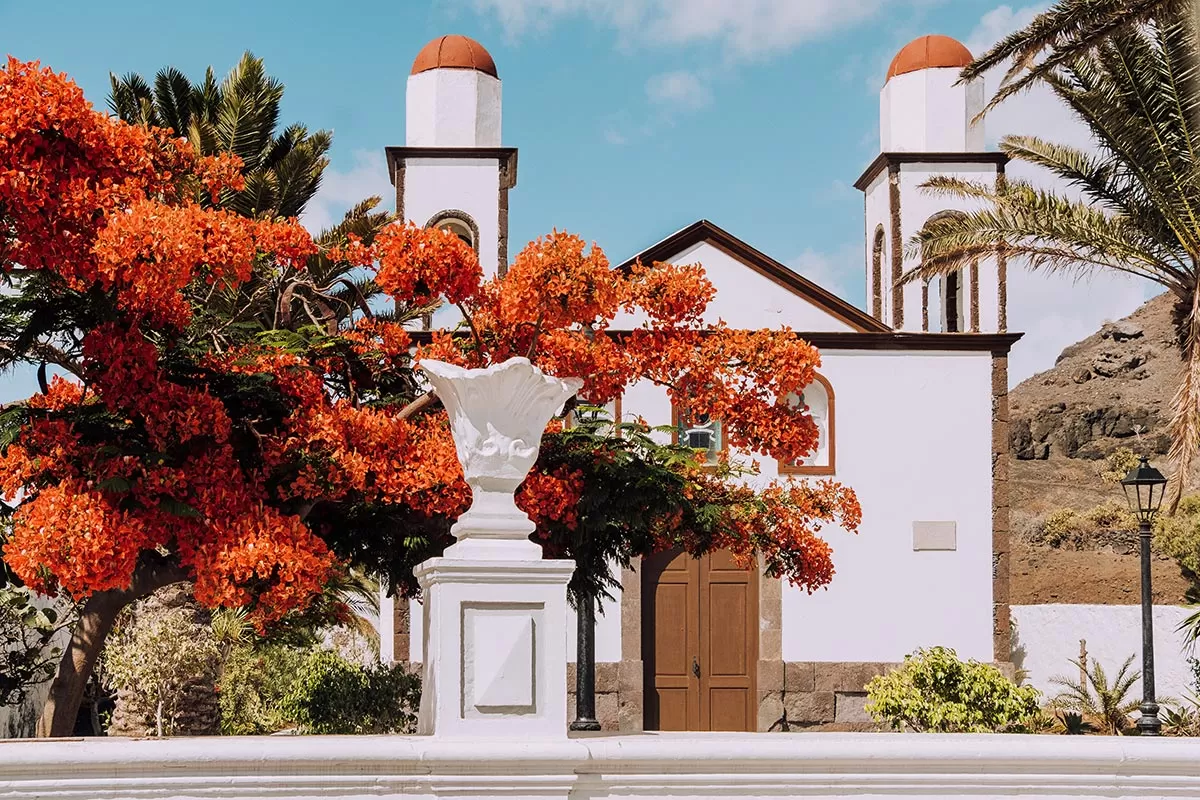
Ermita de las Nieves church
The fiesta is one of those unmissable things to do in Gran Canaria. The streets of Agaete fill up with dancing festival goers brandishing branches. It’s a prayer ritual for rain that dates back centuries and a stirring spectacle if you are lucky enough to be around.
There used to be another big draw in Puerto de las Nieves, the striking Dedo de Dios, ‘Finger of God.’ Sadly, the natural monolith that once rose from the sea like an impertinent finger pointing at God was severely damaged during the Tropical Storm Delta of 2005. The loss of the entire ‘finger’ has reduced the totemic landmark to a poignant reminder of nature’s power.
One more reason you might want to visit Puerto de Las Nieves is to reach Tenerife, the largest of the Canary Islands. Catamarans glide across the sea to Santa Cruz de Tenerife five times daily. The journey takes just 80 minutes, so a day trip to the vibrant port city is worth considering. Plan your trip here.
6. Visit 1,300-year-old burial mounds in the dramatic Agaete Valley

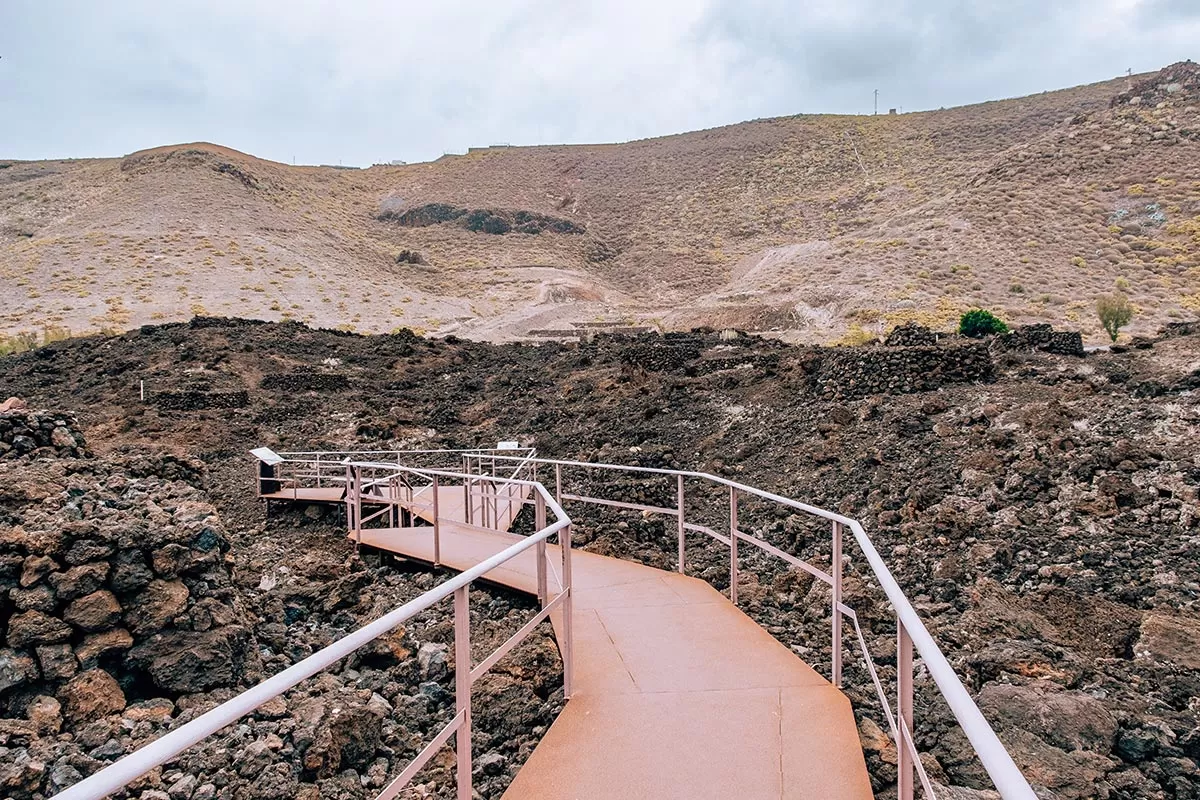
 Just outside Agaete is a fascinating site of archeological interest, set in a striking volcanic valley. The Parque Arqueológico Maipés de Agaete is home to around 700 burial mounds holding the remains of ancient Canarians.
Just outside Agaete is a fascinating site of archeological interest, set in a striking volcanic valley. The Parque Arqueológico Maipés de Agaete is home to around 700 burial mounds holding the remains of ancient Canarians.
The necropolis dates back 1,300 years. Constructed from volcanic rocks, some tombs reach 10 feet (3 m) and stretch 26 feet (8 m) in diameter. They are an arresting sight in an area of stark beauty. The first settlers likely arrived in Gran Canaria around 500 BC, and the tombs are a conspicuous reminder of life before the conquistadors arrived.
Each tomb contains the remains of an islander placed in a stone coffin-shaped to their dimensions. Colored stones were placed on the conical structures, although they no longer remain. The burial mounds are spread over 240 acres (1 sq km). Discreetly positioned walkways and spare but informative multilingual signage provide context as you walk the barren landscape.

 It does not take long to see everything, and few visitors make the short trip from Agaete. But for off-the-beaten-path things to do in Gran Canaria, this singular experience merits pulling yourself away from the natural pools and restaurants of Agaete.
It does not take long to see everything, and few visitors make the short trip from Agaete. But for off-the-beaten-path things to do in Gran Canaria, this singular experience merits pulling yourself away from the natural pools and restaurants of Agaete.
It’s a walkable distance, just 1.5 miles (2.5 km) walk from Puerto de las Nieves through the narrow streets of Agaete. En route, you can stop at the lush tropical gardens of Huerto de Las Flores for a moment of shaded respite from the sun.
There is a visitor center with toilets at Maipes de Agaete, but nothing else in this exposed spot, so come prepared if you plan to spend time here. Those who do are rewarded with stunning views of the Agaete Valley.
The valley is arid yet filled with pockets of lush vegetation that hide coffee plantations and orange orchards. Nearby is the picturesque Tamadaba Natural Park. Existing in the shadows of history, little has changed at Maipés de Agaete since the tombs were built. It is an otherworldly experience that leaves an indelible impression.
Info for Maipés de Agaete:
- Entry €3 (free for under 10s)
- Tuesday to Sunday (April – September) – 10 am to 6 pm
- Tuesday to Sunday (October – March) – 10 am to 5 pm
- C./ Chapín s/n, 35480, 35480, Agaete, Las Palmas
- For more details, visit the official website.
Info for Huerto de Las Flores – Jardín Botánico de Agaete:
- Entry €3 (free for under 10s)
- Tuesday to Saturday – 11 am to 5 pm
- 12 C. Huertas, 35480 Agaete, Las Palmas
- For more details,visit the official website.
7. Taste rare European coffee and sample award-winning wines at Finca La Laja & Los Berrazales Bodega
An arid landscape shaped by the scars of pyroclastic flows might be your first impression of the Agaete Valley. Yet it is also a fertile landscape where avocados, oranges, grapes, and even coffee plantations flourish. Nowhere illustrates this better than Finca La Laja and the Bodega Los Berrazales.
This pretty farm and winery have supplied Gran Canaria with oranges, wine, and coffee for 200 years. Remarkably, the Agaete valley is the only source of European coffee, although even this venerable finca only produces 1,500 kg annually.
Aside from the peculiarity of tasting a European coffee, the headline reason for heading to this spot deep in the valley is the expertly led wine and coffee tastings.
You don’t have to be an oenophile to appreciate the five different wines produced by Los Berrazales Bodega. Designated drivers may look on ruefully as passionate viticulturists explain how their prized wines are made before leading you through the essential wine tasting. Of course, drivers can console themselves by filling the trunk of their car with wine, coffee, and other goodies from the onsite shop. Or take a taxi from Agaete, so nobody misses out.
A similar experience awaits in the finca, although drivers can join the fun this time as coffee is on the menu. Inexpensive guided tours include tastings and delectable food samples, including local cakes, cheese, and chorizo. While there are numerous gastronomic things to do in Gran Canaria, a tour of Finca La Laja and the Bodega Los Berrazales is an exceptional experience and fantastic value. I can’t recommend it enough.
Foodies who want to savor more flavors of the Agaete Valley will appreciate Casa Romántica, a restaurant just 5-minutes away serving up locally sourced ingredients and Canarian specialities. This beautiful house was built in 1976 and designed by a Swiss woman in the Agaete valley. From the outside, you wouldn’t know that a colourful orchard of tropical fruits awaits in the garden. They also grow their own coffee beans too. If you’re short on time, stop by for a wine and cheesing tasting.
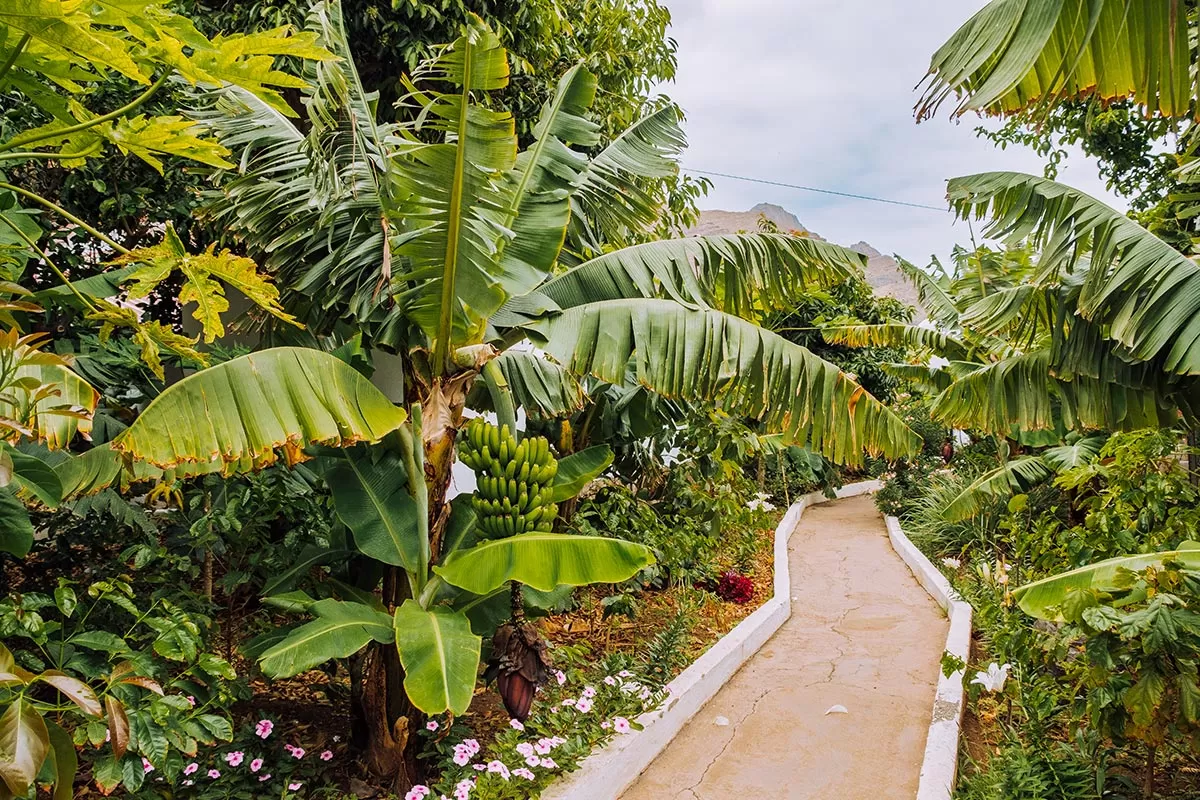
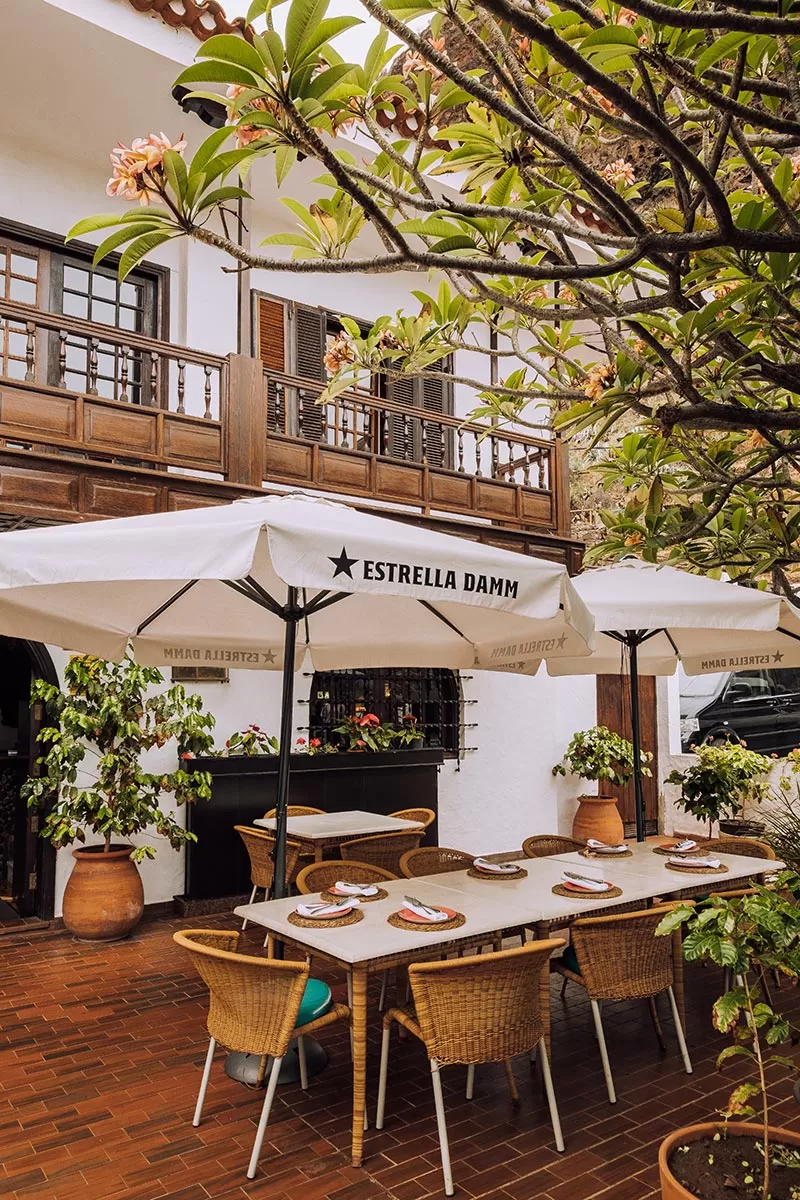
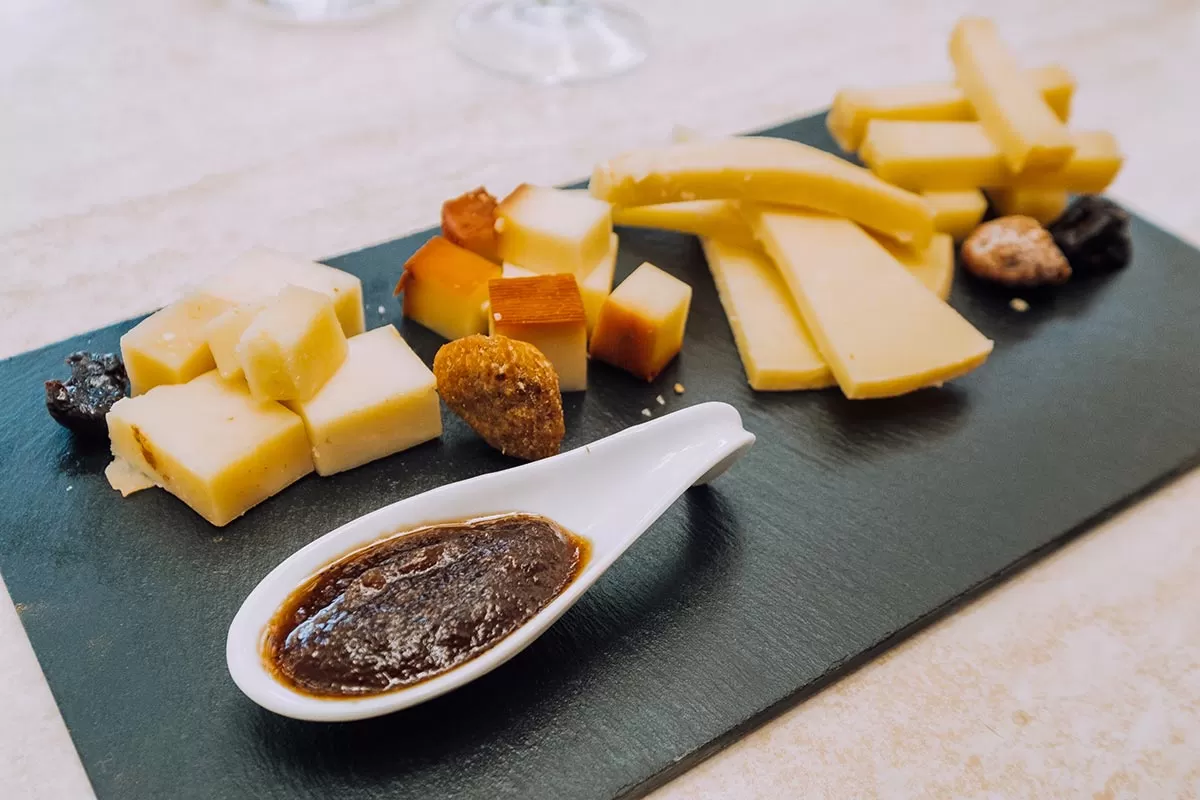
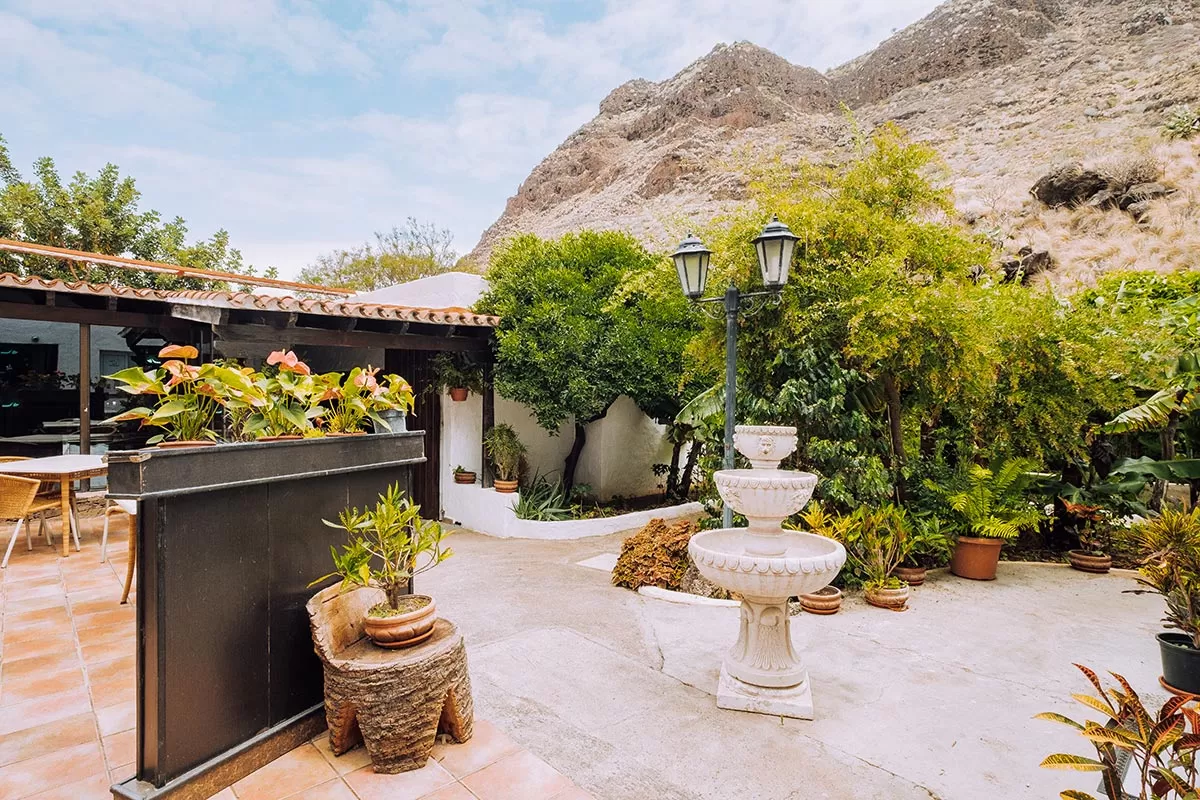
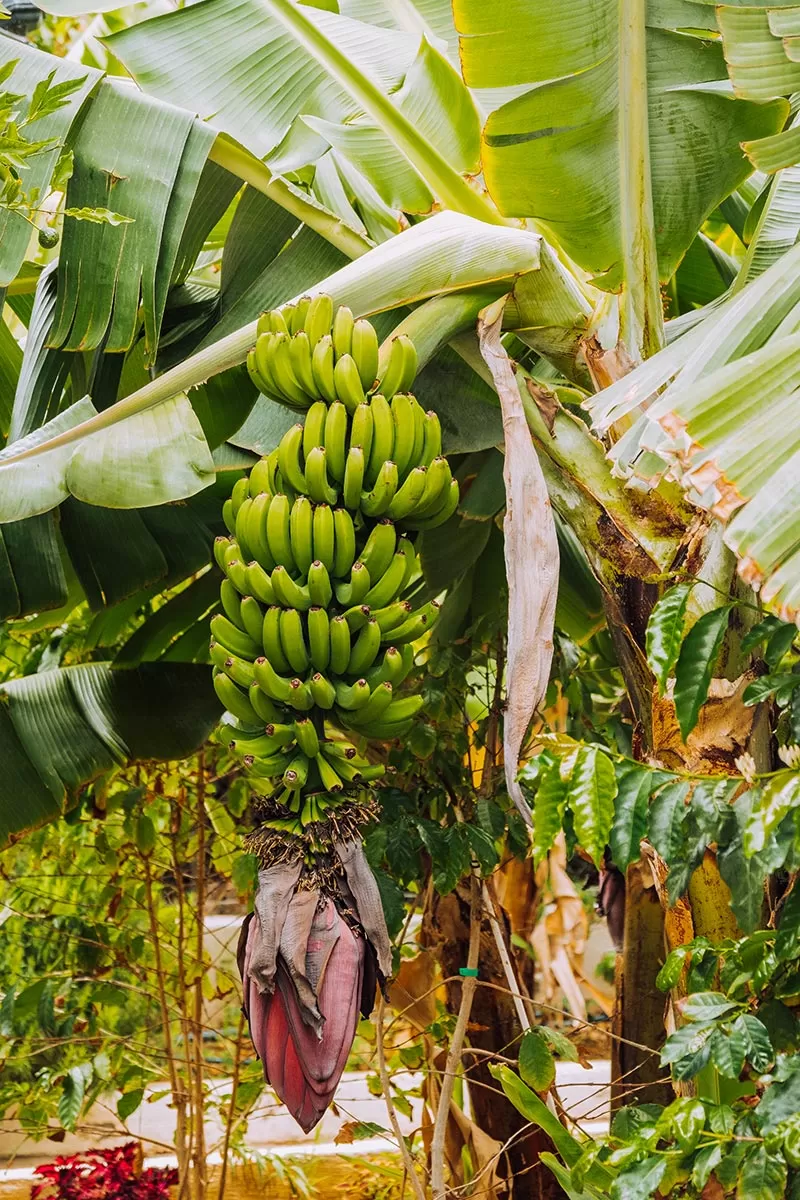
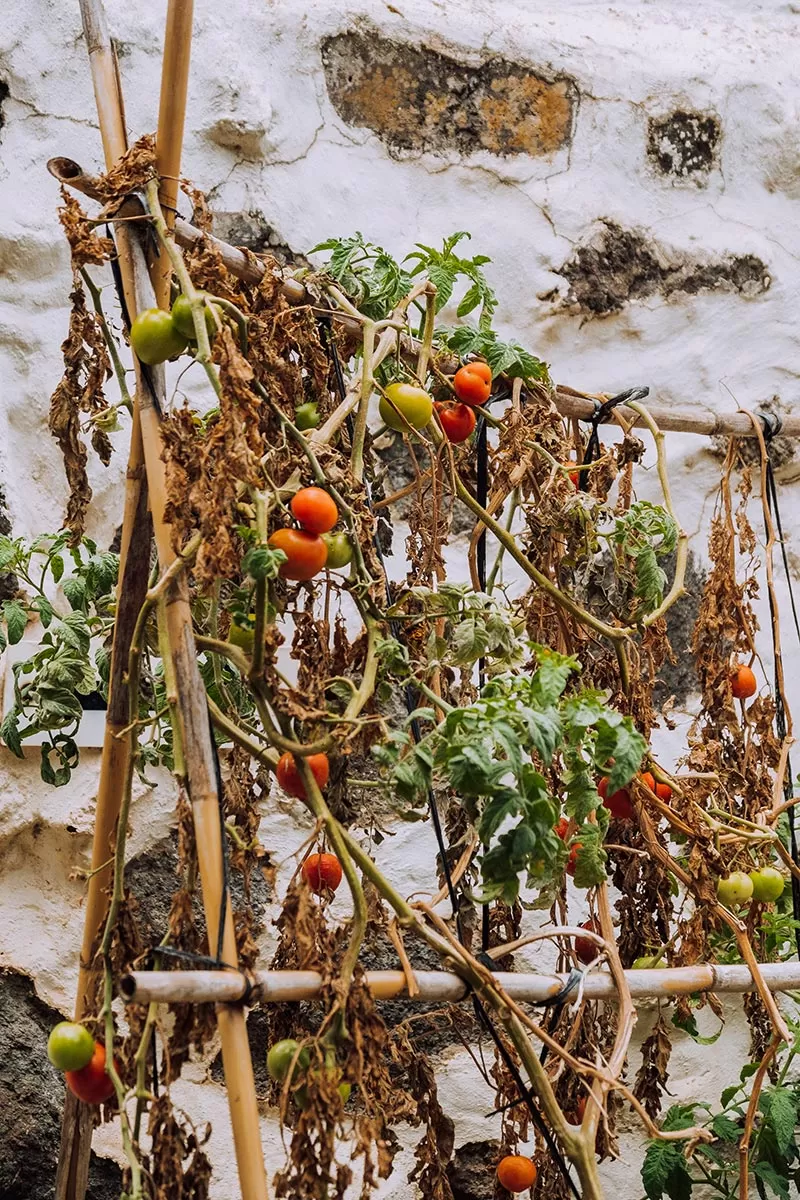
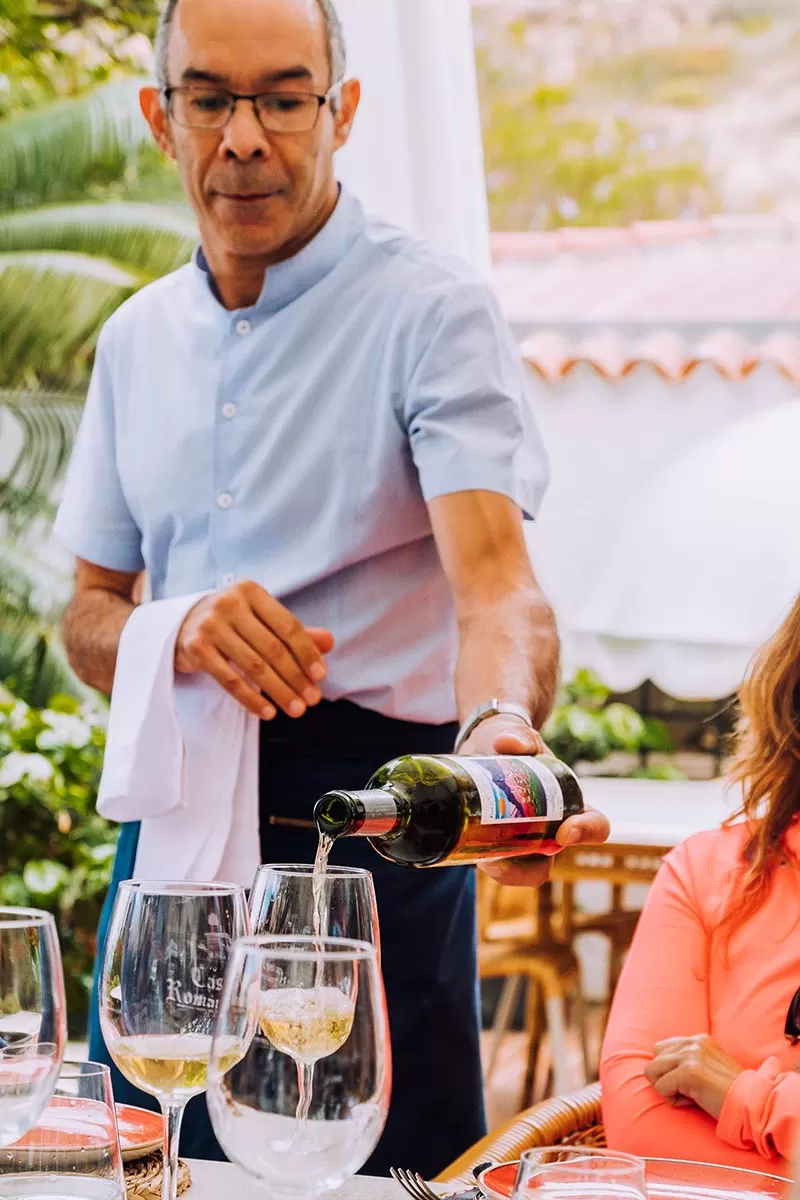
Info for Finca La Laja & Los Berrazales Bodega:
- English & Spanish language guided tours €10 (adults) / €5 (children)
- Open 7 days per week, 10 am to 5 pm (closed Christmas, New Year, January 6)
- Calle de los Romeros, s/n, 35480 Agaete, Las Palmas
- +34 628 92 25 88
- For more details, visit the official website.
8. Head into the central highlands to the quaint village of Tejeda, discovering natural wonders along the way
South of Las Palmas and Agaete rises the central massif of Gran Canaria. The highlands are home to the highest point on the island, and this vast swathe of natural beauty is designated a UNESCO biosphere reserve. The place to aim for is Tejeda, a small picturesque village famed for its almond plantations. Tejeda sits in the Tejeda municipality and is a popular waypoint en route to the Roque Nublo. We’ll take a look at that emblematic landmark in my next entry.
Back in Tejeda, a member of Pueblos más bonitos de España (most beautiful towns in Spain), there are great places to eat and a handful of hotels. It is a peaceful town with a long and rich heritage.
Tejeda was first settled in the third century AD and has been a bread basket for Canarians ever since. Tejeda’s most cherished crop is almonds, which feature in the sweets and desserts the area is renowned for. Indulgences like marzipan and bienmesabe – a moreish confection of honey, egg yolk, and almonds — are of the highest quality in Tejeda.
That’s not all. Tejeda is also a place to sink your teeth into artisanal Canarian cheeses and a local favorite papas arrugada, aka wrinkled potatoes. With a strong folk music tradition, you may also be lucky enough to catch one of the many festivals that light up the pristine white streets of Tejeda.
Although you can walk around the village in 20-30 minutes, there are a surprising number of diversions to satisfy culture-seekers. Look out for the Church of Nuestra Señora del Socorro, a little whitewashed gem with a bright and attractive interior.
This quaint village even manages to squeeze in a couple of museums: the museum of medicinal plants and the Abraham Cardenes Sculpture Museum, which showcases the works of a Tejeda-born celebrity.
Before leaving Tejeda, stock up on sugary regional delicacies at Dulceria Nublo, a candy store and bakery filled with seductive goodies.
Due to the region’s extraordinary natural beauty and important archeological heritage, the town of 1,921 inhabitants is used to welcoming travelers. Easy access to hiking trails makes Tejeda a good base if you crave adventurous things to do in Gran Canaria within the volcanic highlands.
9. See the striking natural formations of Roque Nublo and Roque Bentayga
Charming Tejeda is not the only target for visitors to the highlands of Gran Canaria. Roque Nublo and Roque Bentayga are just a few miles outside Tejeda. Striking natural landmarks, they merit a short detour. The undoubted star is Roque Nublo, aka The Rock in the Clouds. The 220 ft (67 m) tall volcanic rock is found 5,948 ft (1,813 m) above sea level, the third highest point in Gran Canaria. Surrounded by pine forests and gaping ravines, this soaring rock is believed to be an ancient place of worship. You can see how the rock rises against the skyline in this video.
Less impressive but still worth fitting into your tour above the clouds is Roque Bentayga. The solitary rock rises like a rogue menhir in a barren landscape. An ancient settlement of cave dwellings is nearby, and there is evidence the rock was a site of worship for the Guanche people who once lived around Tejeda.
Despite attracting few visitors, there is a small and informative museum at Roque Bentayga. Free to visit, it provides insight into the rock’s importance as an almogarén del Bentayga, a sanctuary for early Canarians. Both Roque Nublo and Roque Bentayga have parking, making them easily accessible things to do in Gran Canaria.
10. Savor the unrivalled views of Gran Canaria at Pico de los Pozos de las Nieves viewpoint
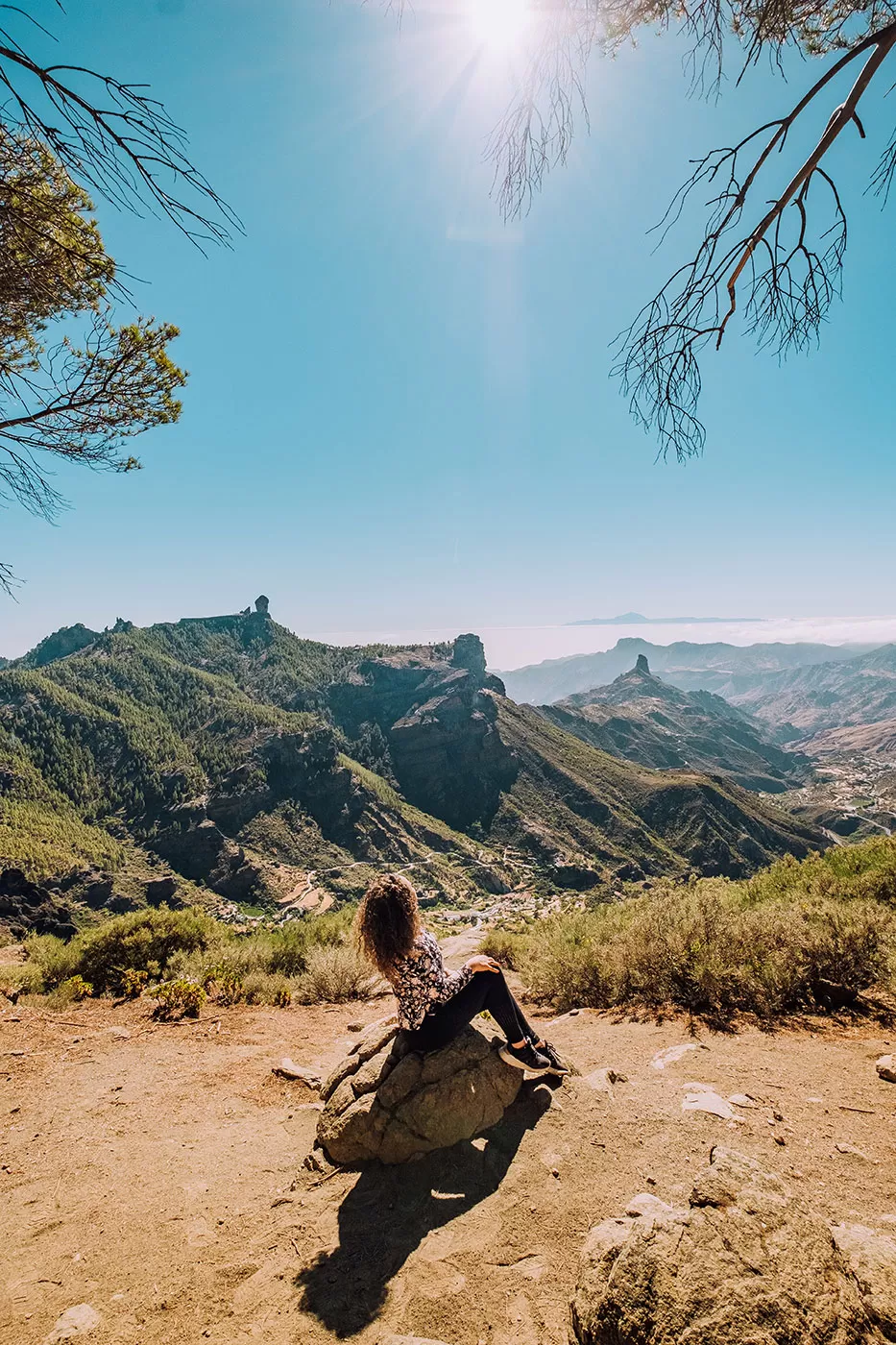
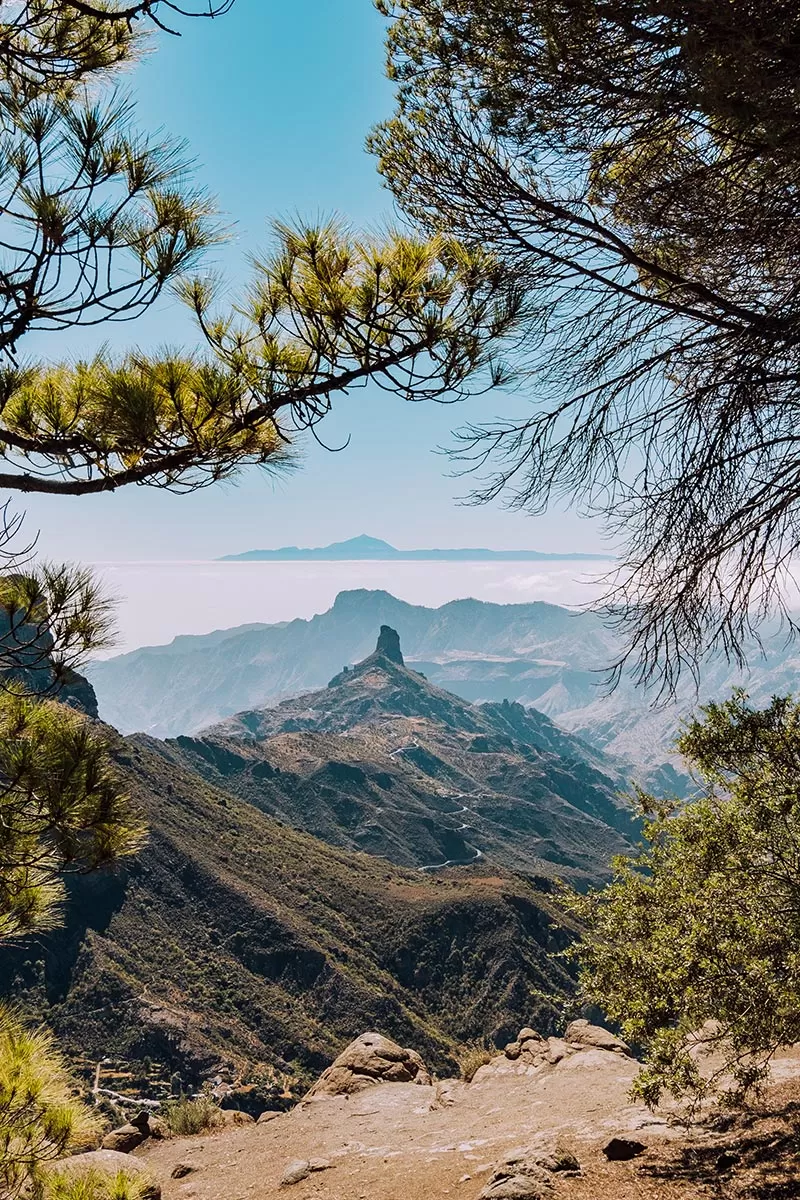
If you felt on top of the world at the famous rocks near Tejeda, you can still go higher. Island views don’t come any higher than Pico de las Nieves, once considered the tallest peak in Gran Canaria.
You might have noticed the hesitancy in calling Pico de las Nieves the highest point on the island. At 6,394 ft (1,949 m), the mountain was long considered the highest point on the island. Yet the neighboring Morro de la Agujereada has nicked the crown, after being measured 23 ft (7 m) taller. Regardless of which peak deserves the title, you’re in for some spectacular views.
Pico de las Nieves, “Peak of the Snows,” once supplied the island with ice stored in pits across the mountain. It is far from the tropical island below.
Head to the Pico de los Pozos viewpoint to savor the finest views. With an observation platform and multiple hiking trails, Pico de los Pozos offers jaw-dropping vistas over the ancient, volcanic landscape.
On a clear day, the island unfolds before your eyes. Silhouetted against the skyline is Roque Nublo. In the evenings, the sun sets above the clouds. A truly remarkable destination your camera will appreciate.
How to get to Pico de los Pozos de las Nieves viewpoint: 8.9 miles (14.3 km) from Tejeda via the GC-150, then GC-130, onto GC-134.
11. Take a well-earned break at Parador de Cruz de Tejeda for lunch with views
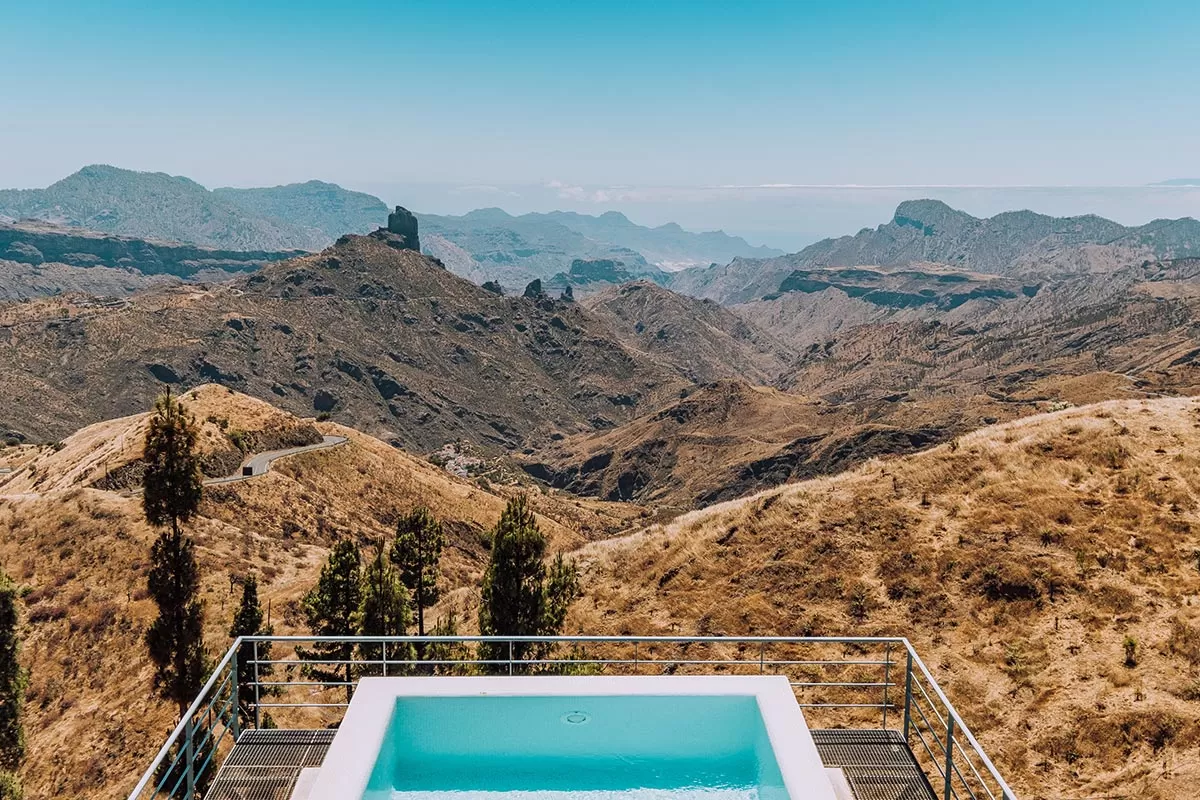
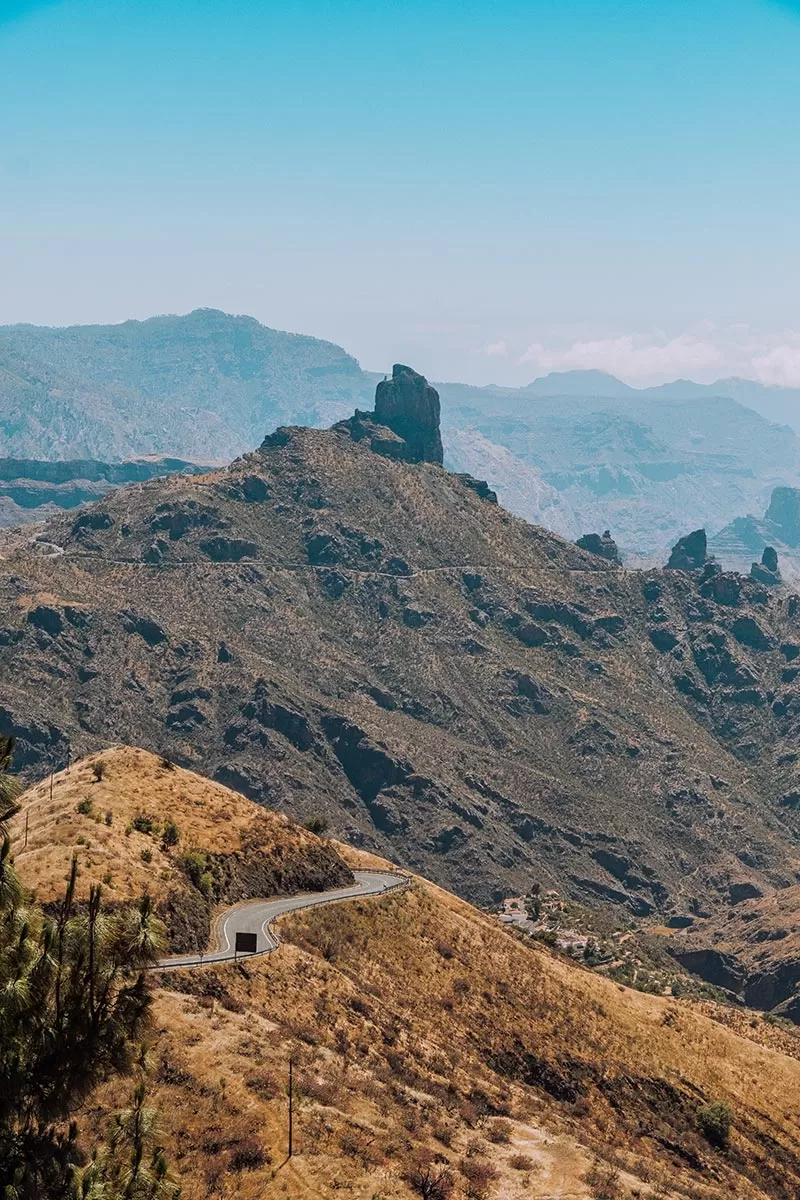
View of Roque Nublo from Parador de Cruz de Tejeda
Before we leave cute Tejeda, there is a restaurant that exemplifies why this part of Gran Canaria is so magical. If you haven’t overindulged on bienmesabe — usually unavoidable once you’ve taken your first bite — then head to Parador de Cruz de Tejeda for lunch with views.And what views! This hotel perches above a precipice and enjoys panoramic views over the craggy central highlands of Gran Canaria. 4,921 ft (1,500 m) above sea level, the infinite vistas are unrivaled.
Popular with hikers, this hotel has a fantastic restaurant open to hungry wayfarers. The menu includes all the regional favorites: conejo al salmorejo (rabbit in garlic, pepper, and paprika marinade), arrugadas con mojos (the beloved wrinkled potatoes with dipping sauces), and, of course, bienmesabe.
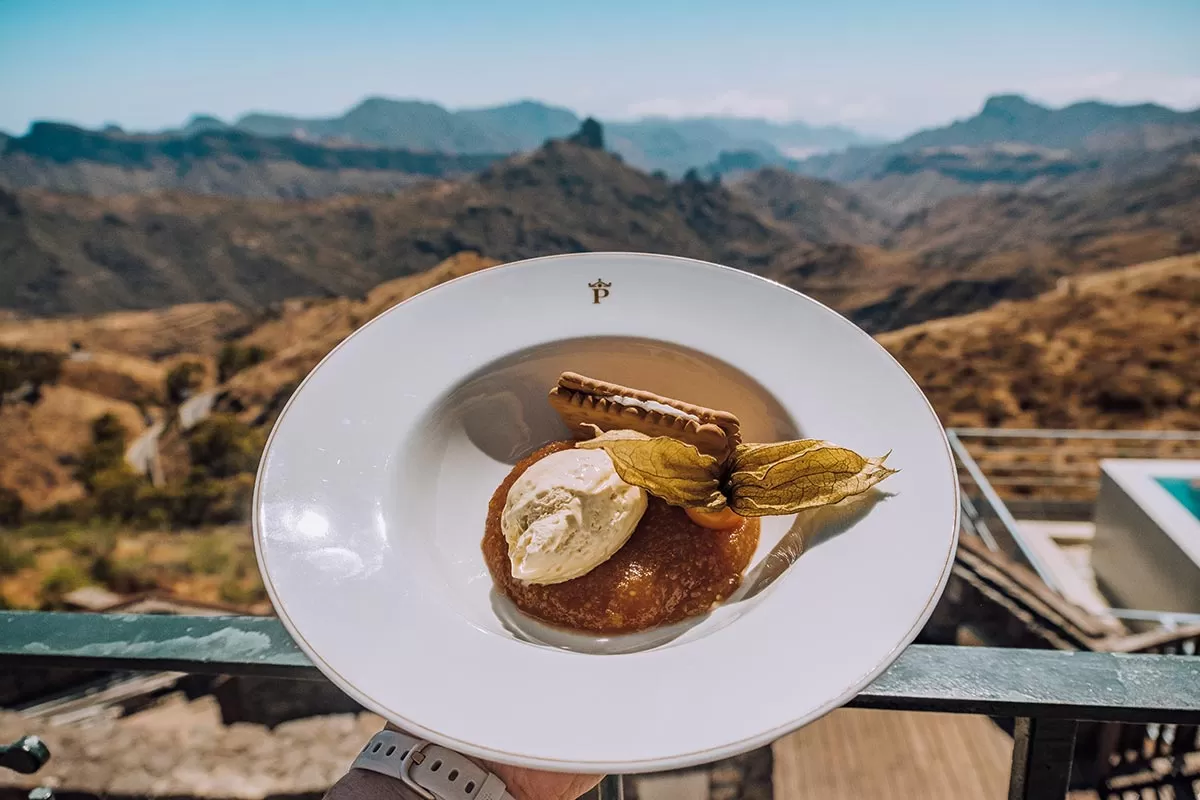
‘Bienmesabe’ dessert at Parador de Cruz de Tejeda
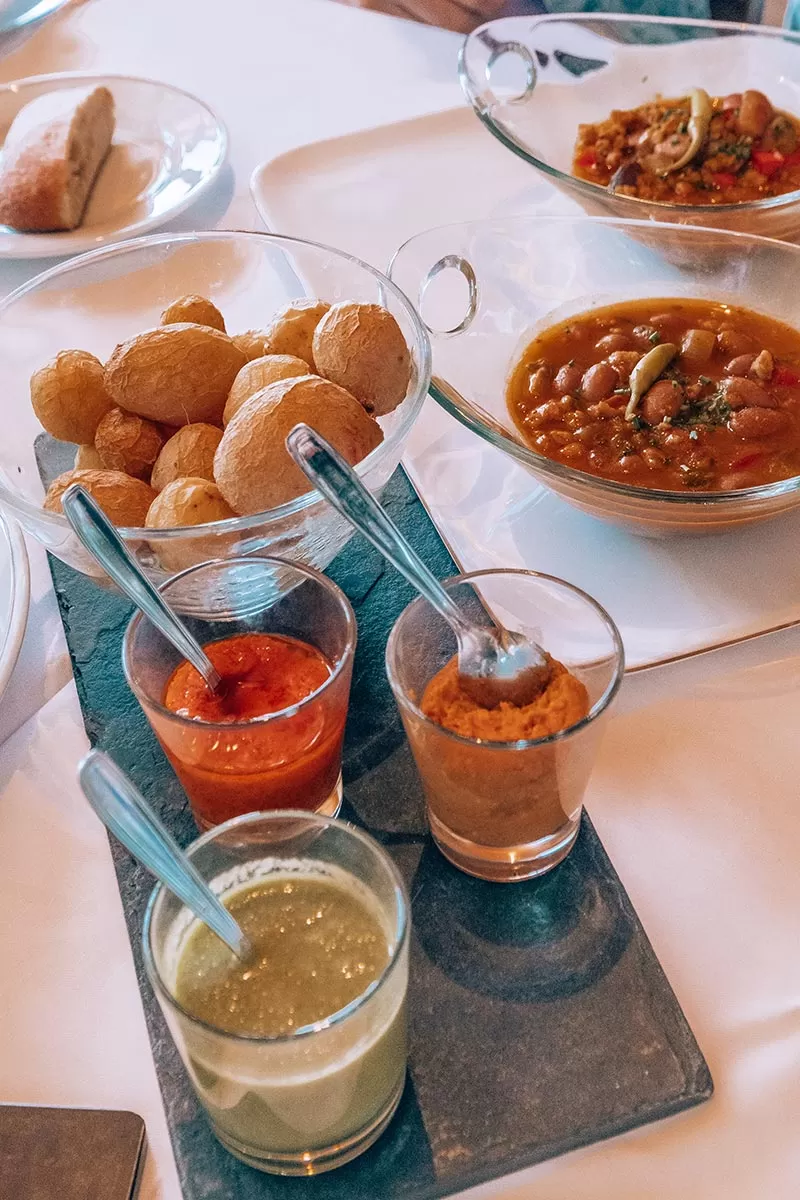
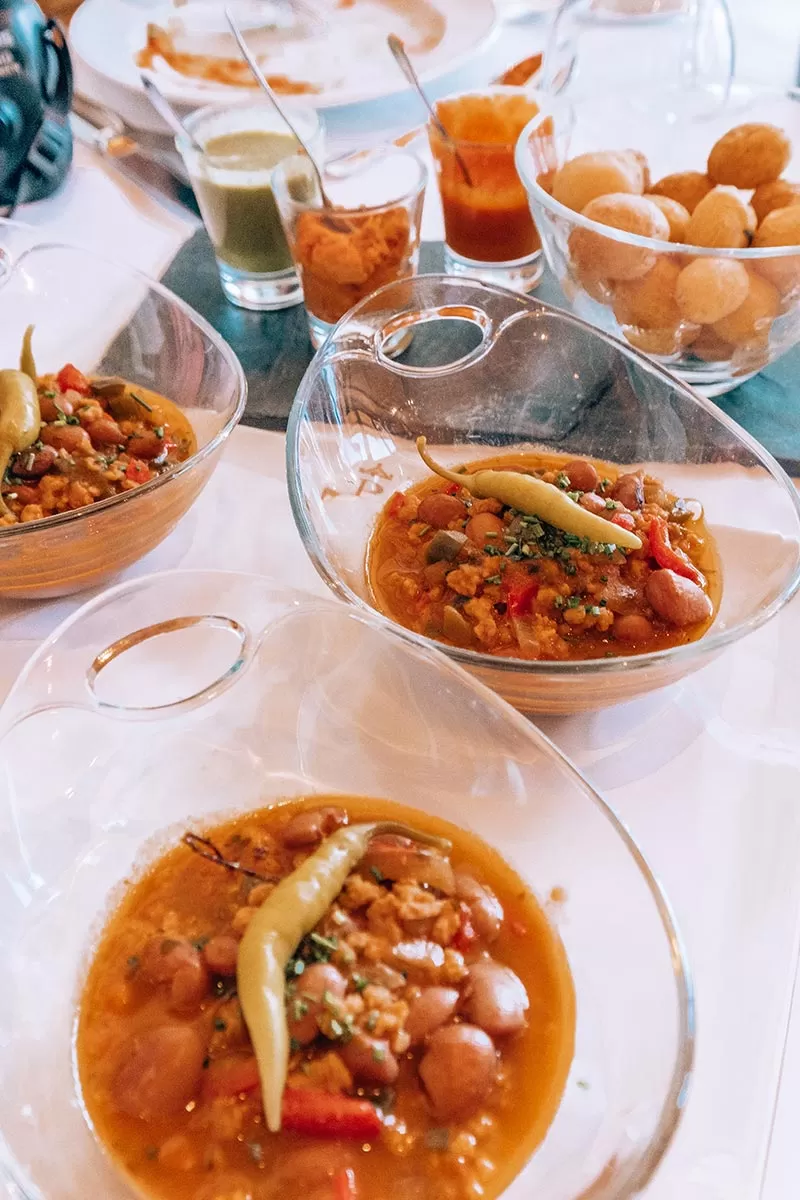
The menu in the formal restaurant will hit the right notes for ravenous travelers. But if you’re just here for the views, there is an informal self-service terrace café, El Mirador.
If you’re tempted to stay in the 4-star hotel, a pool overlooking the mountains and a modern spa helps weary hikers unwind from their highland escapades.
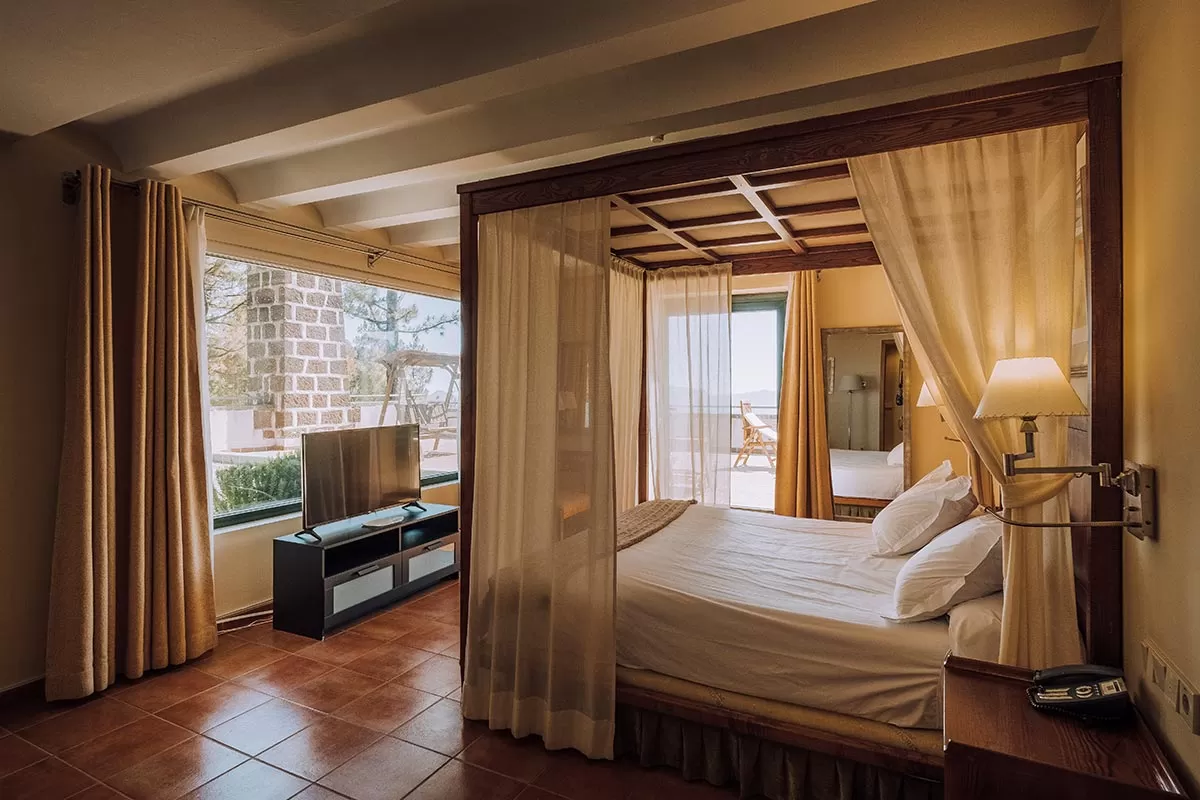
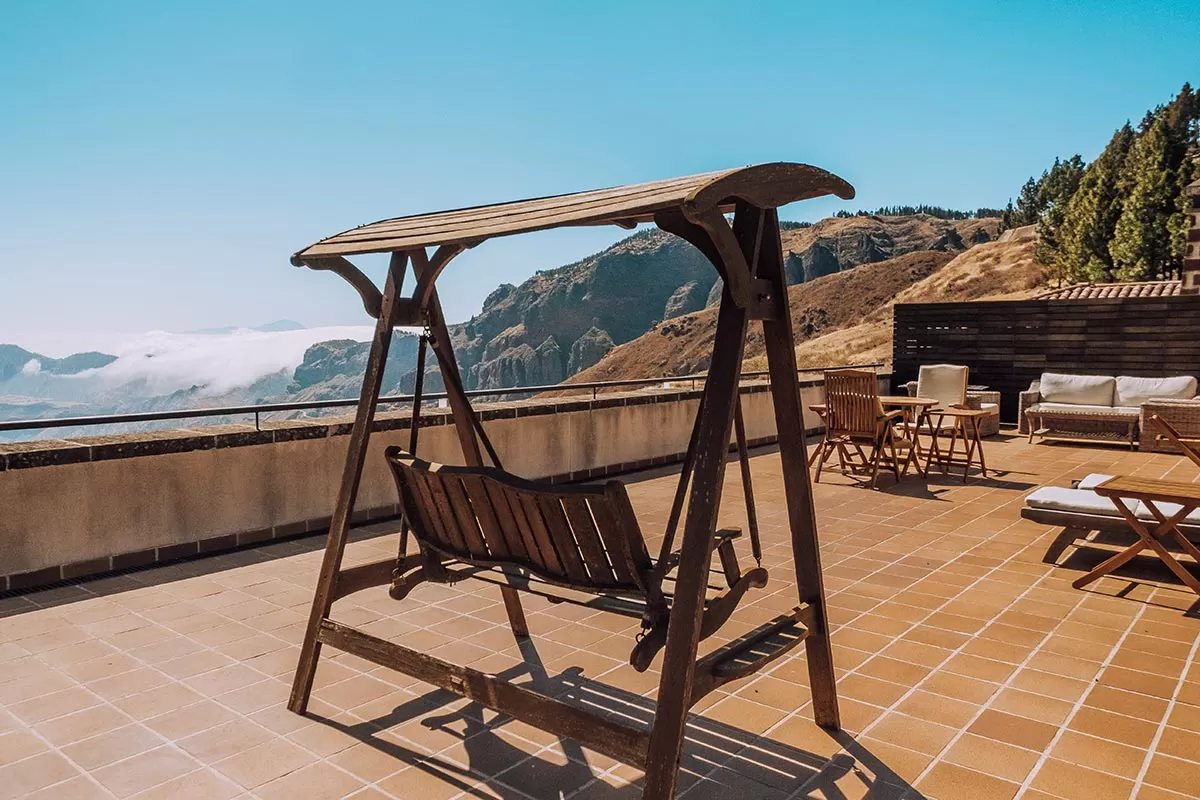
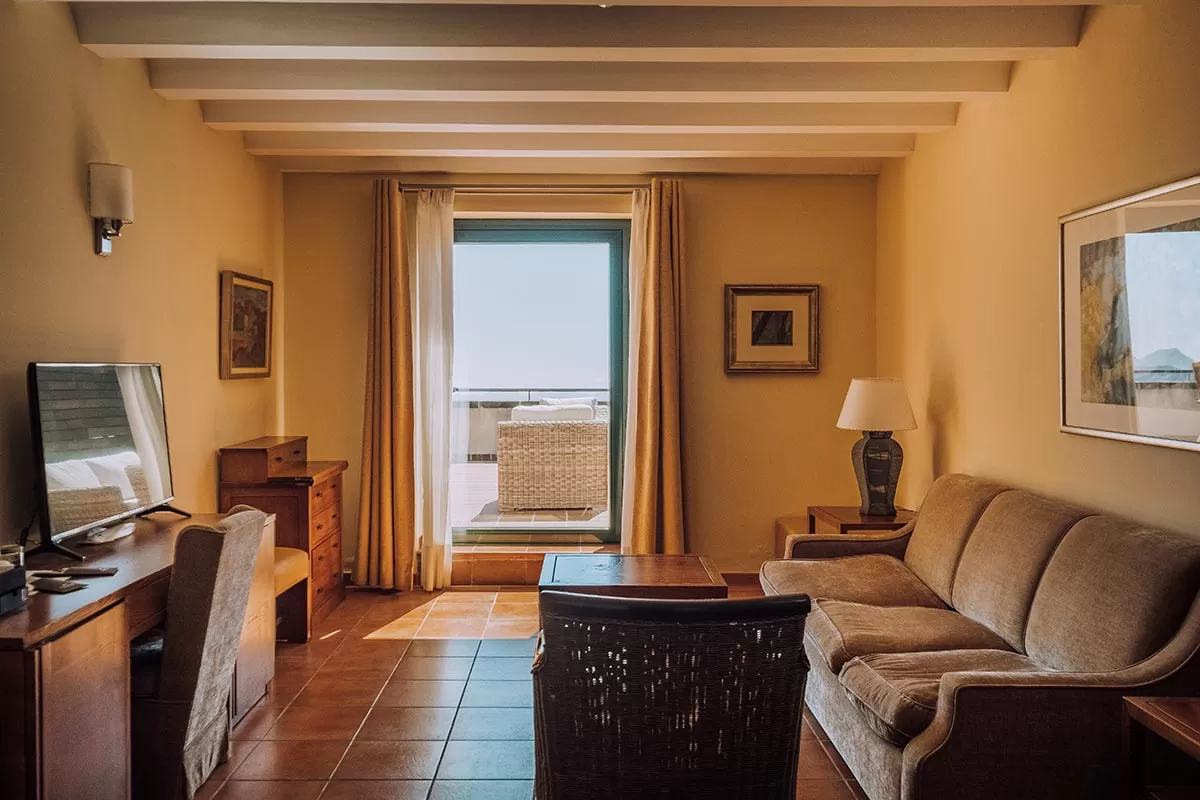
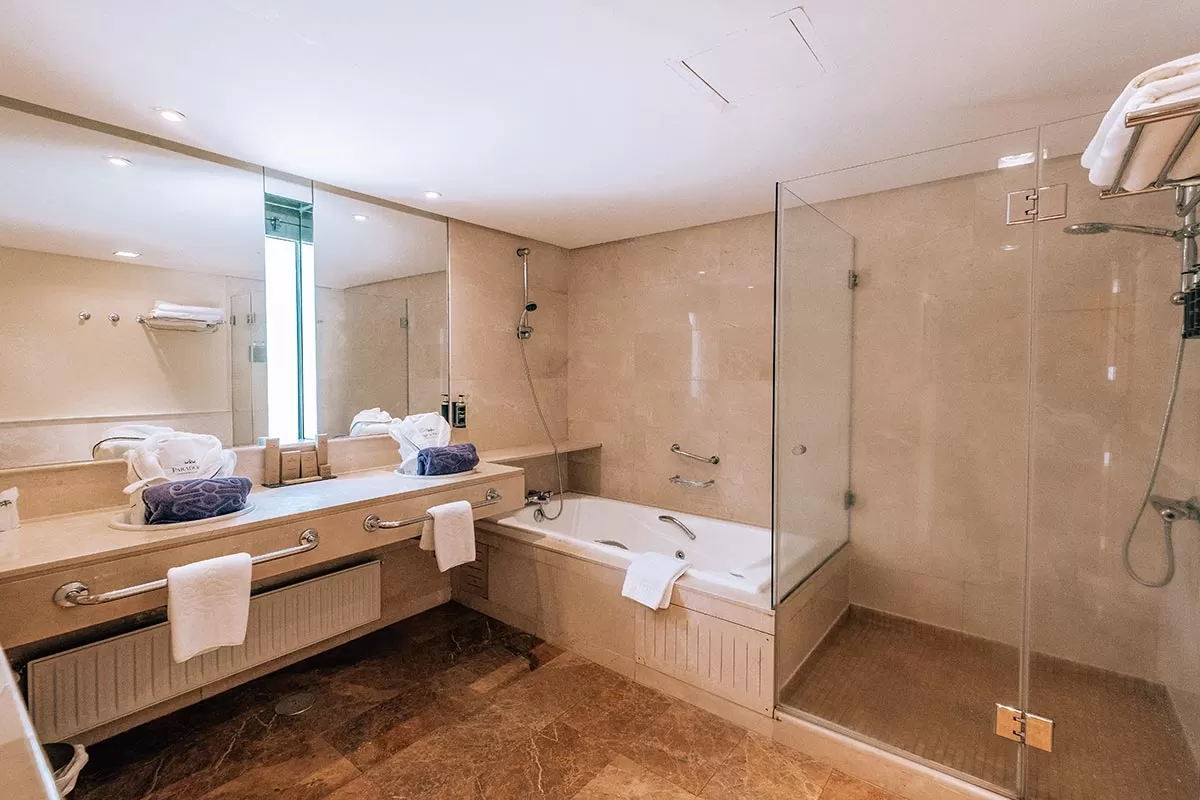 At just 5.5 miles (9 km) outside Tejeda, this under-the-radar gem checks all the boxes for people who have fallen for the charms of Tejeda. Inspiring views and good food in a comfortable setting. Of all the amazing things to do in Gran Canaria, this might be the hardest to wrench yourself away from.
At just 5.5 miles (9 km) outside Tejeda, this under-the-radar gem checks all the boxes for people who have fallen for the charms of Tejeda. Inspiring views and good food in a comfortable setting. Of all the amazing things to do in Gran Canaria, this might be the hardest to wrench yourself away from.
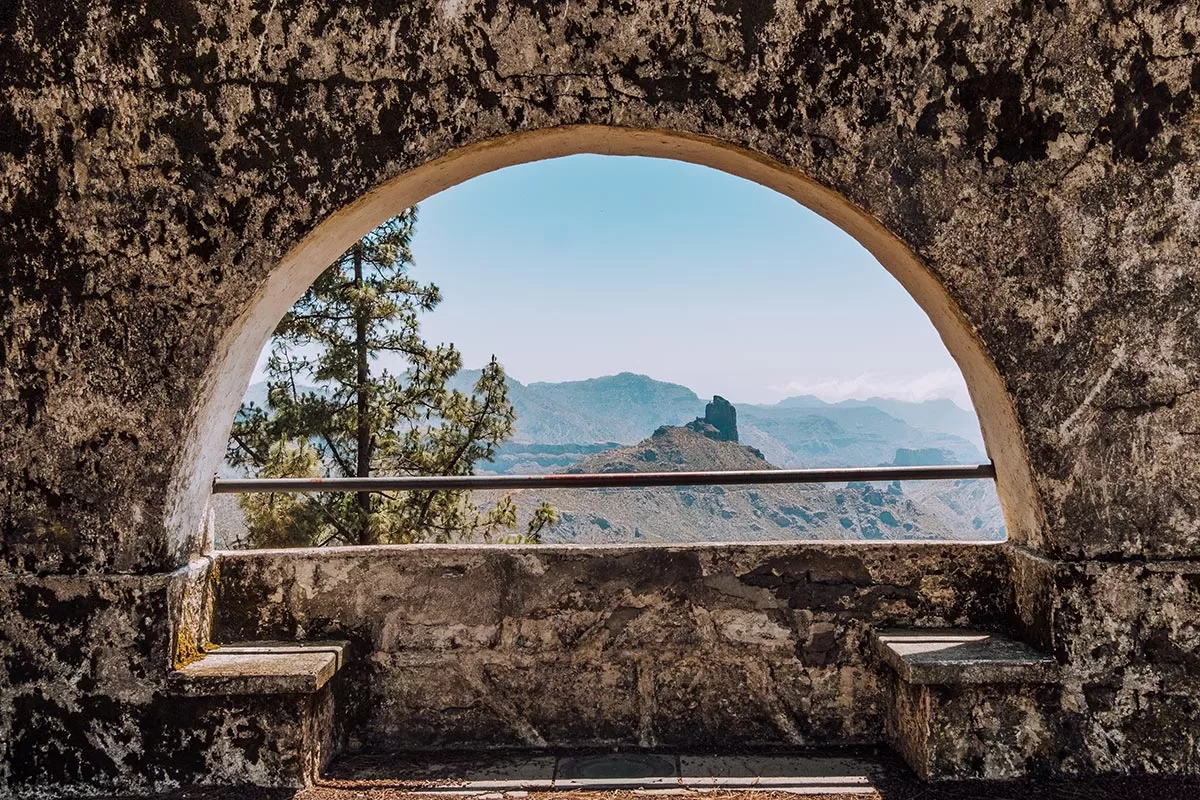
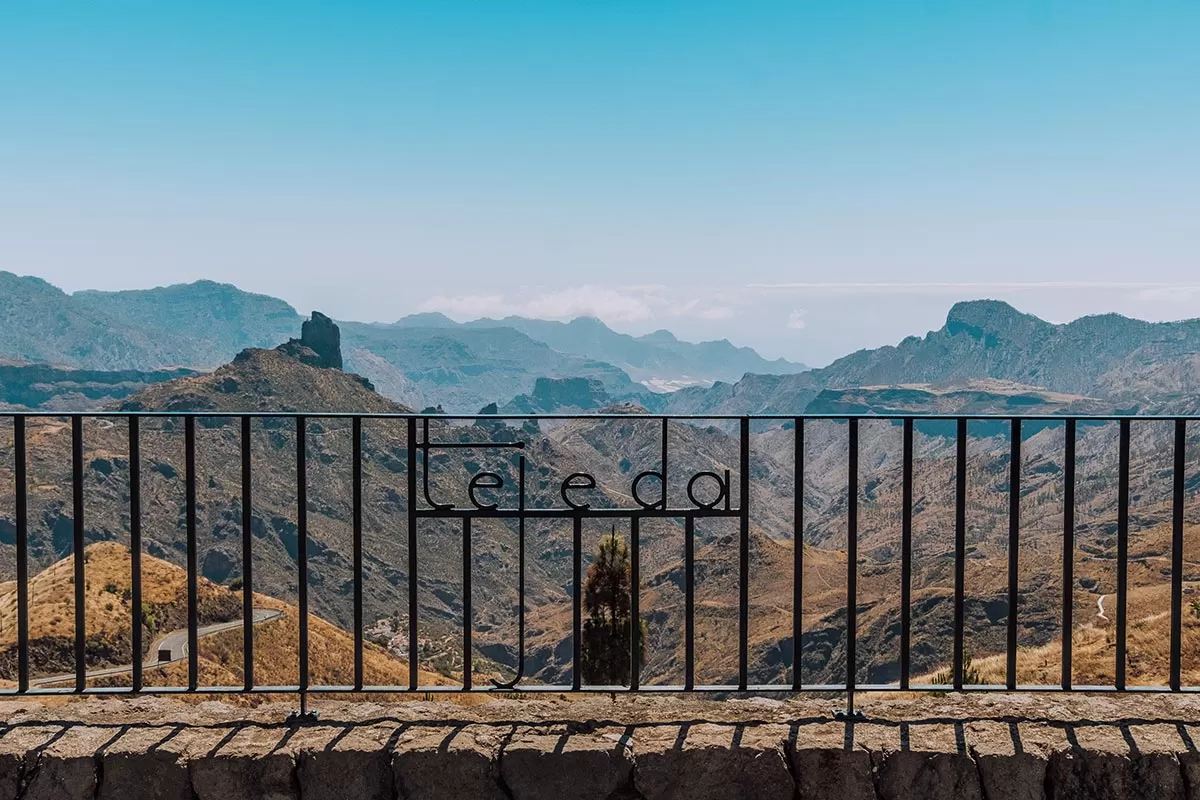 Info for Parador de Cruz de Tejeda:
Info for Parador de Cruz de Tejeda:
- Lunch: 1.30 pm – 3.30 pm
- Dinner: 7.30 pm – 9.30 pm
- Prices start from €12 – €22 for mains. See the full menu here
- Cruz de Tejeda s/n, 35328 Tejeda, Las Palmas
- Tel: +34 928 012 500
- Check availability and book your stay here
12. Swap volcanic landscapes for desert scenery at the sensational Maspalomas Dunes
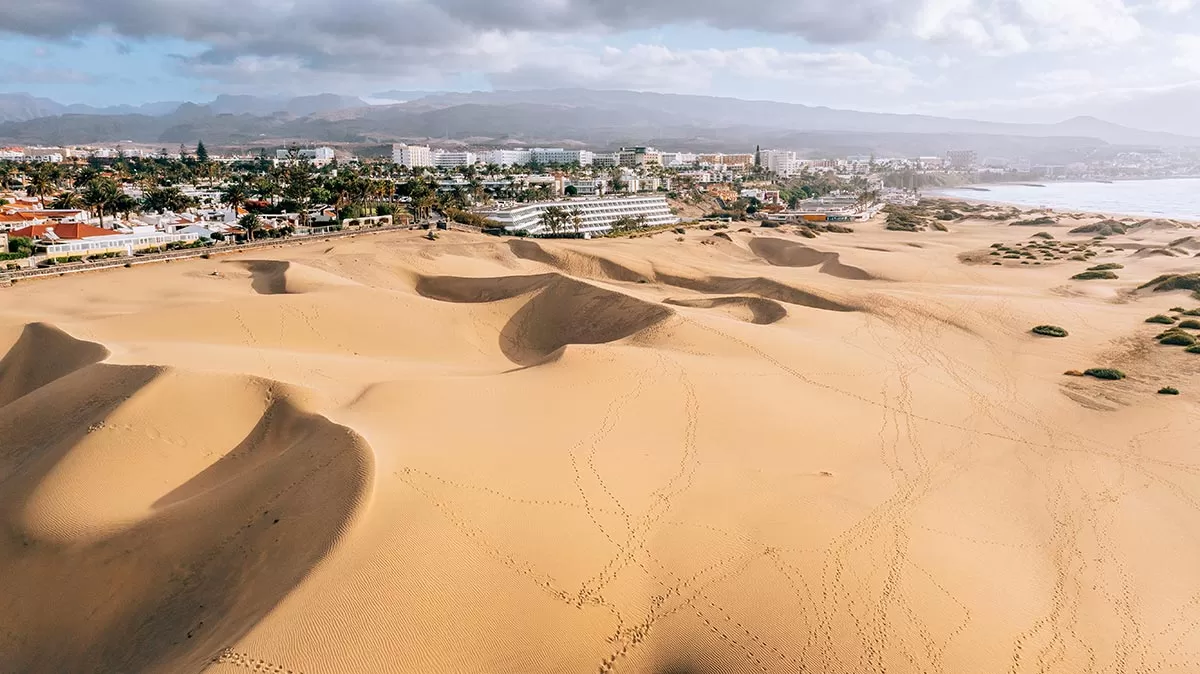 We’ve headed across the north and through the central massif to discover the best things to do in Gran Canaria. Now we head south to what is possibly the most impressive natural wonder of the island.
We’ve headed across the north and through the central massif to discover the best things to do in Gran Canaria. Now we head south to what is possibly the most impressive natural wonder of the island.
The Dunas de Maspalomas is a stark contrast to the rugged volcanic landscapes of the north. Looking like a lost corner of the Sahara, the immense dunes spread over 400 hectares.
Bounded by the pristine waters of the Atlantic and the protected lagoon at La Charca de Maspalomas, the ever-shifting dunes were once a contender in the televised competition to decide the 12 Treasures of Spain. It’s easy to see why. Sitting on a marine shelf formed during the ice age, the tides and winds have shaped the fine, golden sands into a magical landscape.
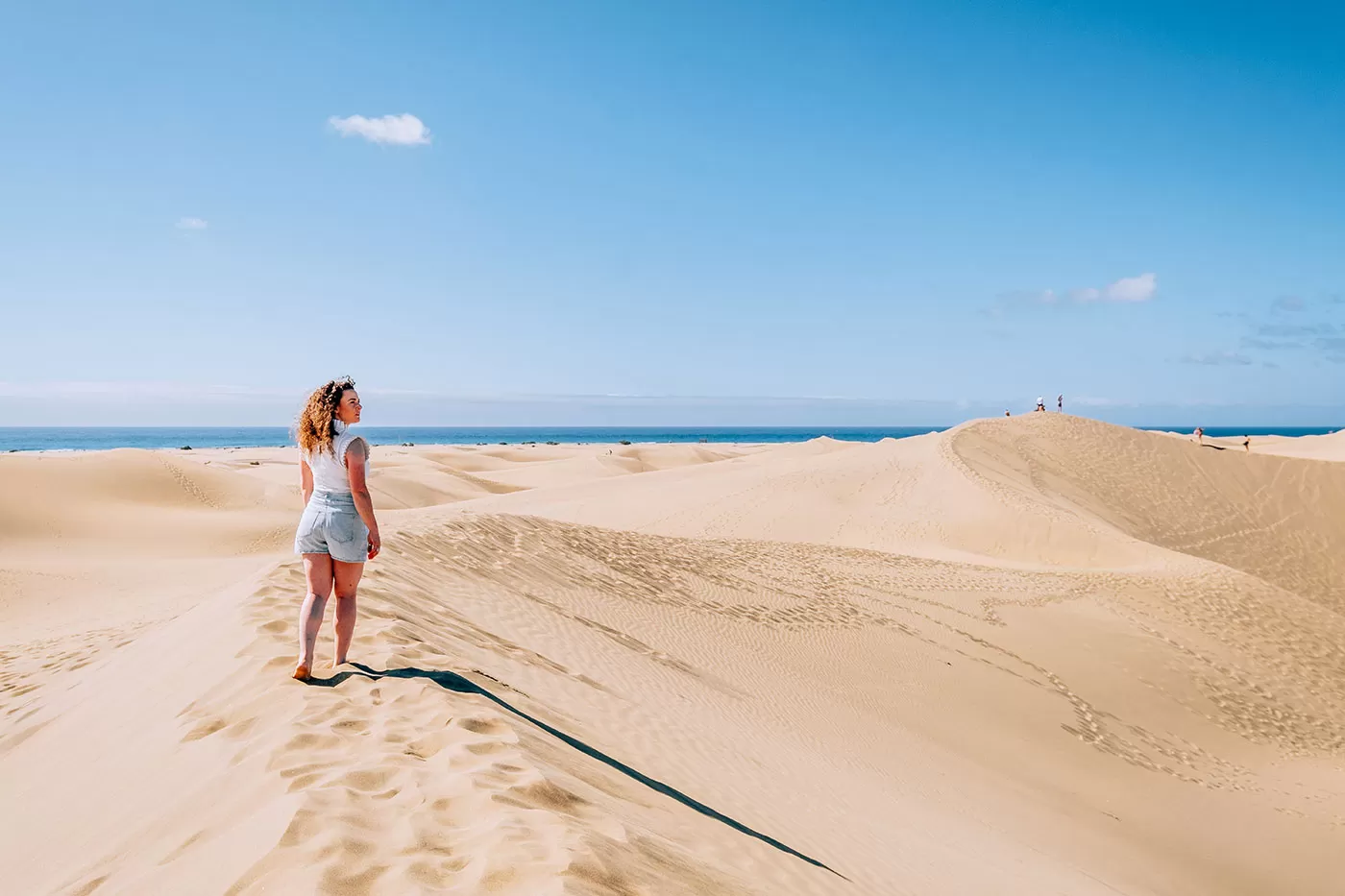 Sometimes reaching 32 feet (10 m) in height, the dunes are no longer an open playground. As one of the top things to do in Gran Canaria, steps have been taken to protect the delicate ecosystem. Designated paths let you explore without destabilizing the dunes. Considering how many resorts cluster around this itinerary-topping destination, it is a sensible precaution. Having said all that, you will still see people walking over the dunes as the signs are barely visible, especially if you reach them from the beach and not the main viewpoint located here. A more eco-friendly and exhilarating way to experience the dunes is to go skydiving over the Maspalomas Dunes. Whether it’s your first jump or 100th, you’ll be with a professional instructor who will accompany you. All fitness levels are welcome.
Sometimes reaching 32 feet (10 m) in height, the dunes are no longer an open playground. As one of the top things to do in Gran Canaria, steps have been taken to protect the delicate ecosystem. Designated paths let you explore without destabilizing the dunes. Considering how many resorts cluster around this itinerary-topping destination, it is a sensible precaution. Having said all that, you will still see people walking over the dunes as the signs are barely visible, especially if you reach them from the beach and not the main viewpoint located here. A more eco-friendly and exhilarating way to experience the dunes is to go skydiving over the Maspalomas Dunes. Whether it’s your first jump or 100th, you’ll be with a professional instructor who will accompany you. All fitness levels are welcome.
Note: Upon my return, I discovered that access to the dunes will become more limited and will include more designated paths to further protect the area.
As you might hope for an area shaped by golden sands, the beaches on the southern tip of Gran Canaria are first-class. They underline why this side of the island is especially popular with beach-going tourists.
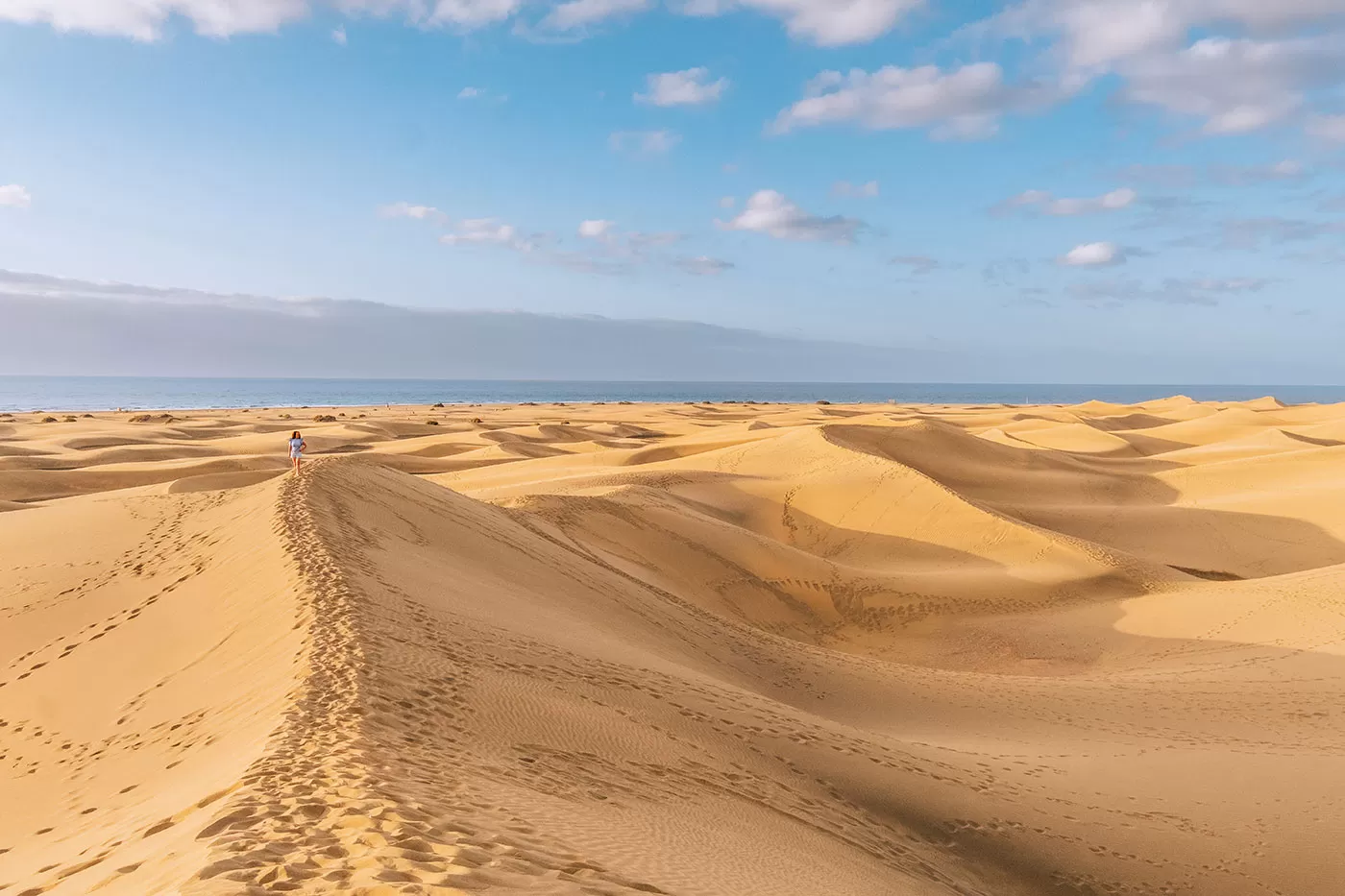 The standout beach is Playa de Maspalomas, backed by dunes and renowned for glorious sunsets that draw crowds in the evenings. You can also view the towering Maspalomas Lighthouse. The Maspalomas Dunes are no secret. But to miss them would be to miss the best of Gran Canaria. ‘Must-see’ can be overused when writing travel guides, but in this instance, it fits.
The standout beach is Playa de Maspalomas, backed by dunes and renowned for glorious sunsets that draw crowds in the evenings. You can also view the towering Maspalomas Lighthouse. The Maspalomas Dunes are no secret. But to miss them would be to miss the best of Gran Canaria. ‘Must-see’ can be overused when writing travel guides, but in this instance, it fits.
13. Watch the sunset under Maspalomas Lighthouse
Soaring above the dunes at the southernmost tip of Gran Canaria is the Faro de Maspalomas. An arresting landmark, Maspalomas Lighthouse has been a focal point for travelers (and sailors, naturally) since it was built in 1890.
The 184 ft (56 m) tower was the work of Juan León y Castillo, a local engineer responsible for several public projects on the island. A noteworthy figure in the history of Gran Canaria, a museum celebrates his contributions in his hometown of Telde.
The lighthouse tower is inaccessible. However, you can visit the annex below, which hosts cultural events and exhibitions. But even if the most panoramic views are off-limits, there’s no shortage of sea views along the adjacent promenade.
Overlooking two beaches, including the magical Playa de Maspalomas, the walkways around the lighthouse are refreshingly breezy and made for leisurely sun filled strolls. Dotted along the promenade and neighboring streets are relaxed cafés and some decent restaurants.
A short stroll from the lighthouse is Boulevard El Faro, a leafy shopping mall with plenty of decent dining options. For something a bit special, head to El Caldero on the Boulevard El Faro. Opposite a small and secluded beach, it is a popular spot to enjoy quality Valencian food along this idyllic stretch of the Maspalomas coast.
14. Let your hair down at the lively resort beach, Playa del Inglés
The dunes of Maspalomas are home to another golden attraction, the lively Playa del Inglés. Especially popular with families and fun-seekers, the nearly 2 miles (3 km) long sands are a dream for beach lovers, with something for every interest. There are sections for families and beach sports, and watersport enthusiasts are spoilt for choice. A discrete corner is even set aside for naturists.
Playa del Inglés embraces its role as a resort beach. The name suggests English tourists flock here, which is not inaccurate. Although legend claims that the beach was first settled by a Frenchman who was, inexplicably, mistaken for an Englishman.
Whatever the origin story, since the 1960s and the growth of mass tourism, Playa del Inglés has firmly established itself as, perhaps, the leading resort town in Gran Canaria.
Playa del Inglés teems with restaurants, bars, and nightclubs. Immense hotel complexes cluster around the beach, while satellite towns — Agustin and Sonnenland — have sprung up to meet demand.
Much of the nightlife centers on the Yumbo Centrum, a shopping mall filled with numerous diversions for shoppers and revelers. Known for its LGBTQIA+ friendly nightlife, it’s a magnet for clubbers. During the day, the 200+ shops and restaurants are a colorful diversion from the beach.
Close to many highlights on the southern tip, Playa del Inglés is a handy base for explorers. There are more subdued destinations on the island. But if you’re looking for beach-centric things to do in Gran Canaria, few destinations offer as much variety.
15. Get close to the animals at Palmitos Park
A short drive from Playa del Inglés is Palmitos Park. The island’s biggest zoo is one of the top things to do in Gran Canaria for families.The zoo label is a little misleading. The park started as a bird sanctuary, and you won’t find any big beasts here. Yet there have been numerous zoological additions since opening in 1978.
The park now boasts botanical gardens, an aquarium, and a burgeoning number of reptiles and mammals. The star attraction is a dolphinarium that puts on shows and lets visitors interact with the dolphins for an additional fee.
The park is relatively small, so some visitors will grumble about the prices. But that overlooks the surprising variety in this verdant park high in the palm-tree-filled hills of the Palmitos ravine.
Supporting the headlining dolphins are crowd pleasers like Komodo Dragons (the first bred in European captivity), caimans, meerkats, gibbons, and a colorful tropical aquarium.
Perhaps the most colorful moments are delivered by the original residents of the sanctuary, the tropical birds. Toucans, flamingoes, and a kaleidoscopic array of tropical birds thrive and mesmerize visitors in the Palmitos aviary.
With twice-daily shows that showcase dolphins and birds of prey (included in the entry fees), there is more to this park than meets the eye. The diversity of animals is not world-beating. Yet, the pretty setting and a delightful botanical garden filled with orchids and butterflies make Palmitos Park an intriguing diversion for adults and kids. If only for a few hours.
Info for Palmitos Park:
- Entry €33 (over 11 years) / €24 (5-10 years) / €12 (3-4 years) For more details, visit the official website.
- Additional charges for “The Encounter” (pool edge) and “The Experience” (in pool) experience with the dolphins. Only sold in the park, so best to reserve upon entry due to limited availability.
- Open 7 days per week, 10 am to 6 pm (last entry at 5 pm.)
- Barranco de los Palmitos, s/n, 35109 Maspalomas, Las Palmas.
- Tel: +34 928 79 70 70
16. Hang out with Dolphins in their natural habitat
If you prefer to see dolphins in their natural habitat, numerous cruises will get you close to them. If you are lucky, you may see whales and other marine creatures, including turtles and flying fish.
Catamarans, small yachts, and glass-bottomed boats offer an overwhelming variety of options: from two-hour cruises to longer day trips complete with dinner and a cooling drip in the ocean. Whichever company you go with, a dolphin-spotting trip is one of the most uplifting things to do in Gran Canaria.
The two leading locations to find a cruise are Puerto Rico de Gran Canaria and Puerto de Mogan.A safe bet for any dolphin watchers is the cruises offered by The Spirit of the Sea, a glass-bottomed catamaran and one of the big names in dolphin-watching cruises.
Departing from Puerto Rico de Gran Canaria, The Spirit of the Sea is less intimate than other, more expensive cruises. But on the two-hour trip, you’re assured of seeing the magical mammals living their best life, both above and underwater.
Info for The Spirit of the Sea:
- 2-hour cruise – from €38
- Check availability and book your trip hereor here
- Puerto Base, 35130 Puerto Rico de Gran Canaria, Las Palmas.
- Tel: +34 928 562 229
17. Treat yourself to sunsets and cocktails at the laidback Perchel Beach Club
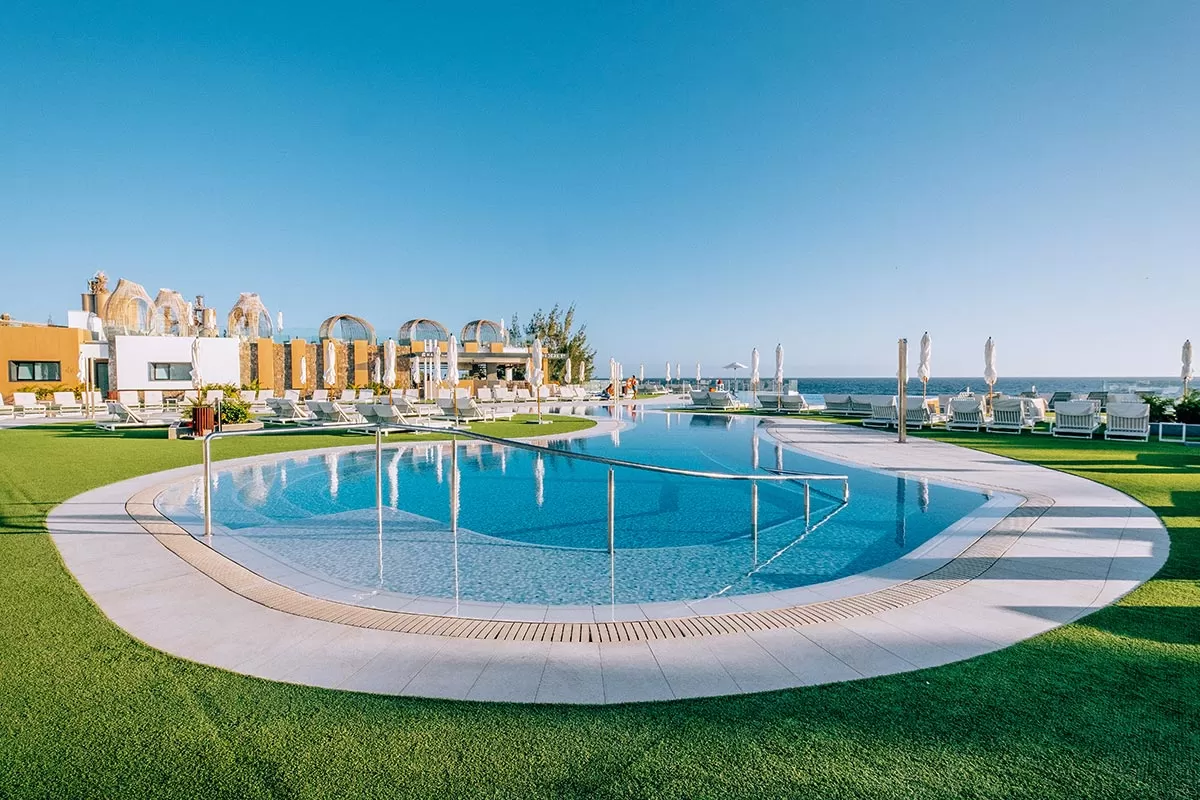
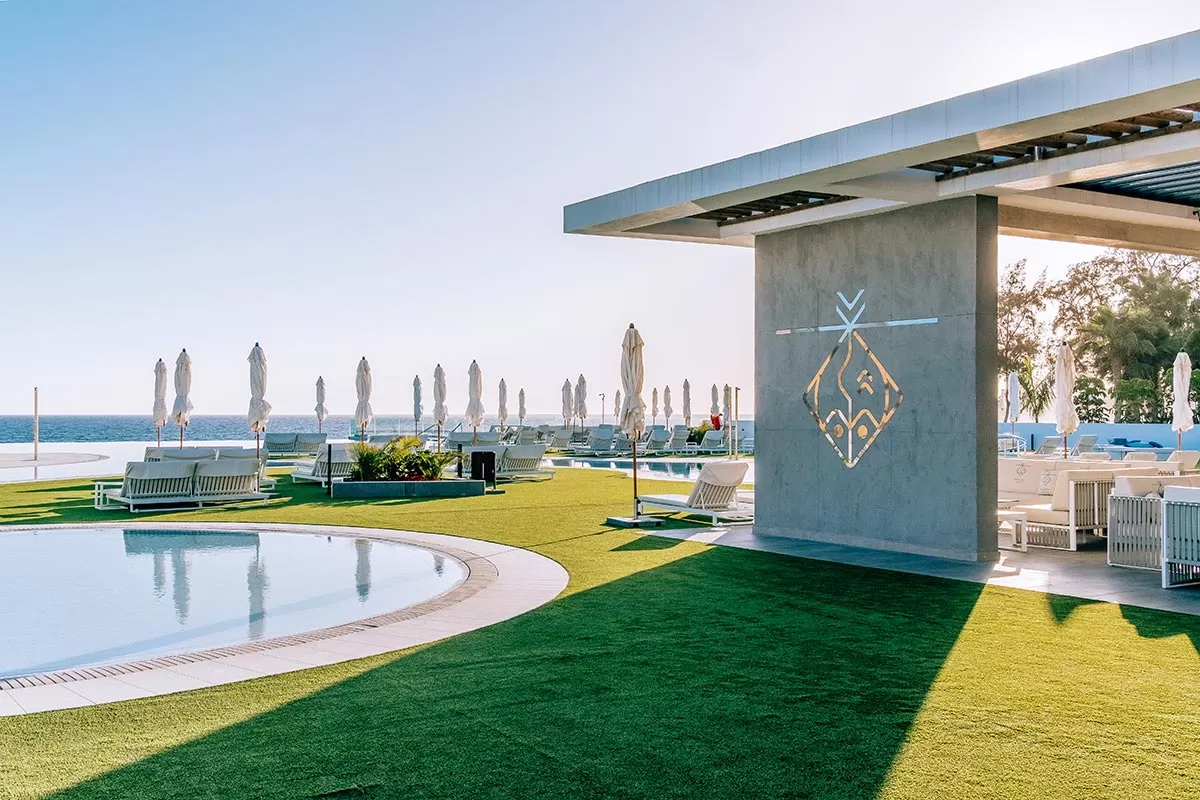
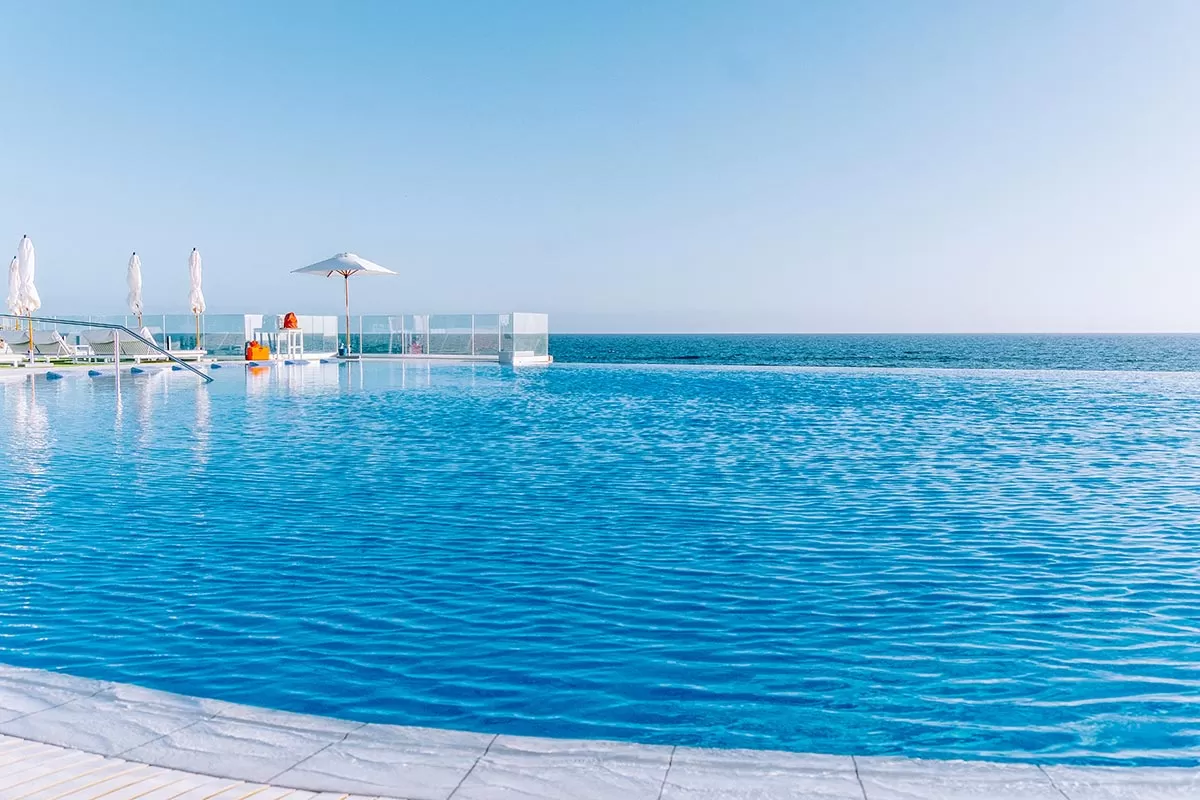 If you’ve had enough of sandy beaches and crave fresh water swimming, calming shade, and tempting cocktails, the Perchel Beach Club is a worthy detour. This unsung jewel on the southern end of Gran Canaria is just 10 miles (16 km) from the Maspalomas Dunes. It is a stylish and idyllic escape from the crowded beaches, with two restaurants and an emphasis on simply chilling out.
If you’ve had enough of sandy beaches and crave fresh water swimming, calming shade, and tempting cocktails, the Perchel Beach Club is a worthy detour. This unsung jewel on the southern end of Gran Canaria is just 10 miles (16 km) from the Maspalomas Dunes. It is a stylish and idyllic escape from the crowded beaches, with two restaurants and an emphasis on simply chilling out.
The centrepiece is an infinity pool that ’empties’ into the Atlantic. There is also a splash park for kids and spacious ‘cocoons’ for small and large groups. Add unspoiled horizon views across the Atlantic and a killer sushi bar to the mix, and this is one of those easygoing things to do in Gran Canaria. The sushi menu keeps things simple, with a small selection of super-fresh maki rolls, nigiri, and tempura. A selection of gyoza is offered as appetizers, including one made from melt-in-your-mouth Iberian pork.
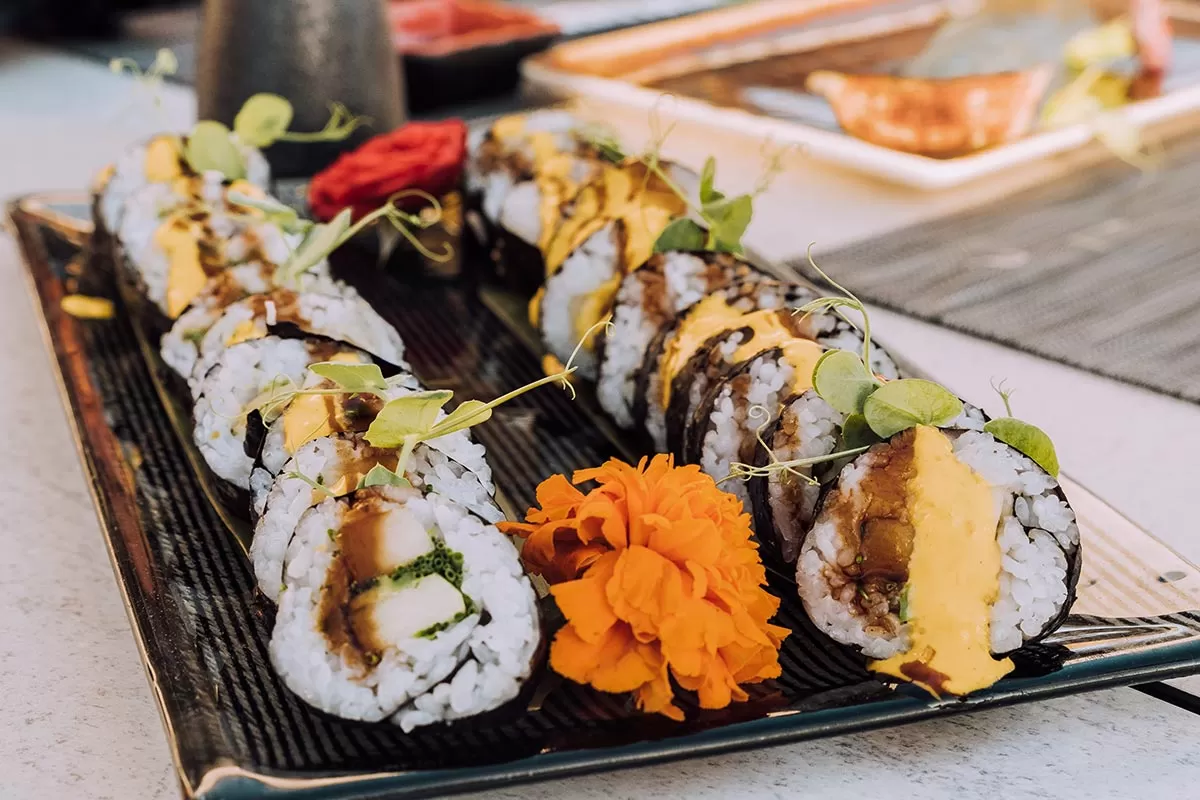
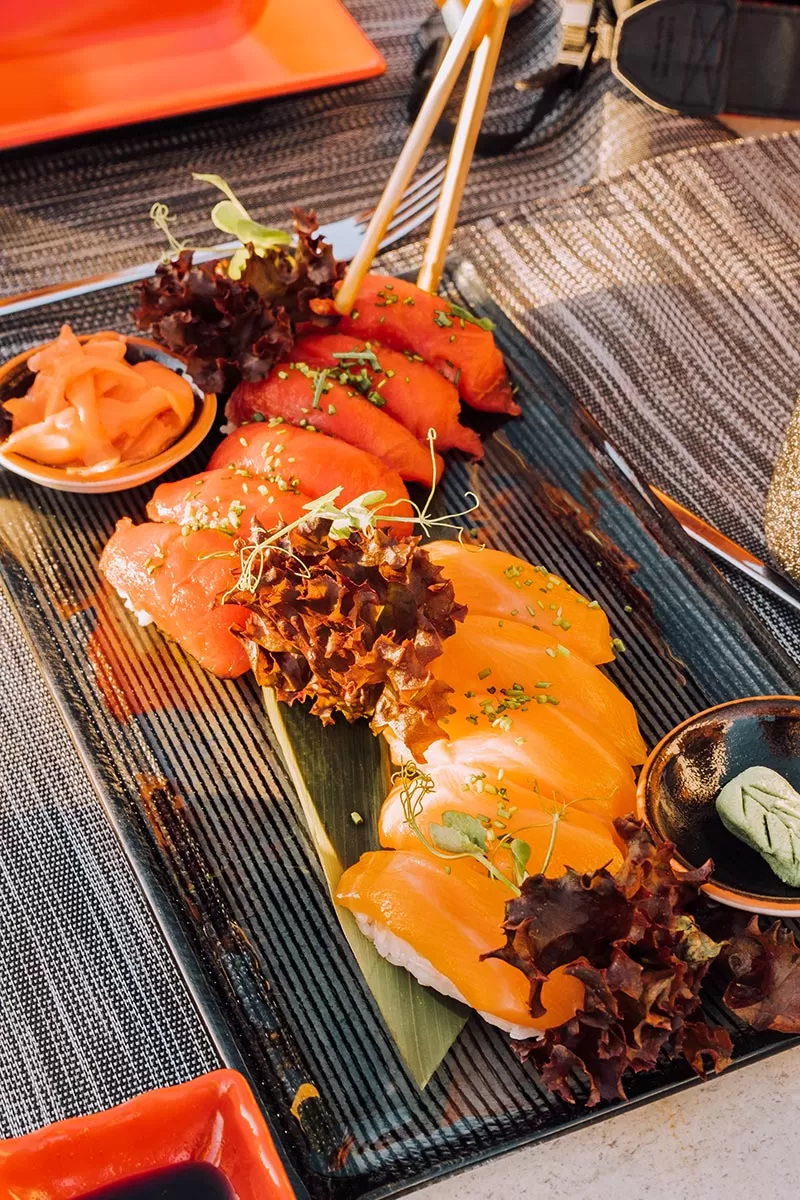
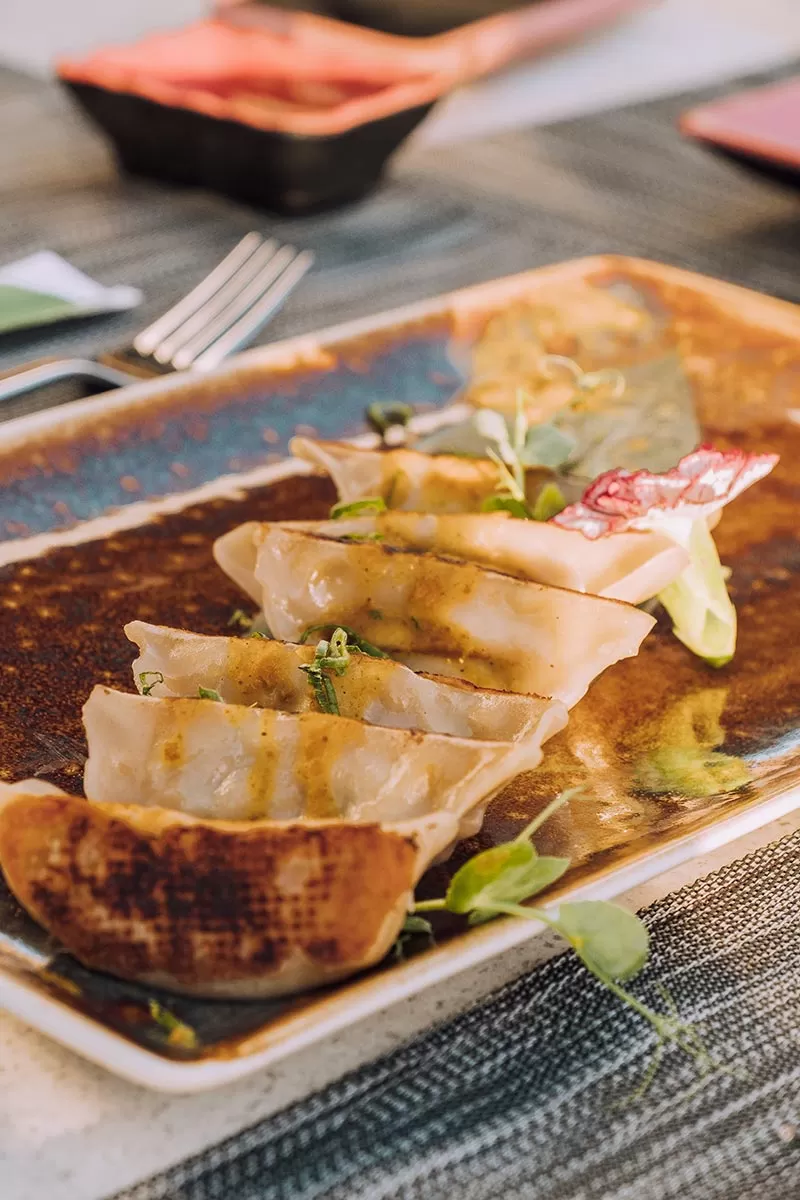 If sushi doesn’t do it for you, the more traditional Spanish dishes at La Arrocería might fire your appetite. Expect classic rice and meat dishes and a tempting array of seafood specials. Sometimes an afterthought in the Canaries, several options are suitable for vegetarians.
If sushi doesn’t do it for you, the more traditional Spanish dishes at La Arrocería might fire your appetite. Expect classic rice and meat dishes and a tempting array of seafood specials. Sometimes an afterthought in the Canaries, several options are suitable for vegetarians.
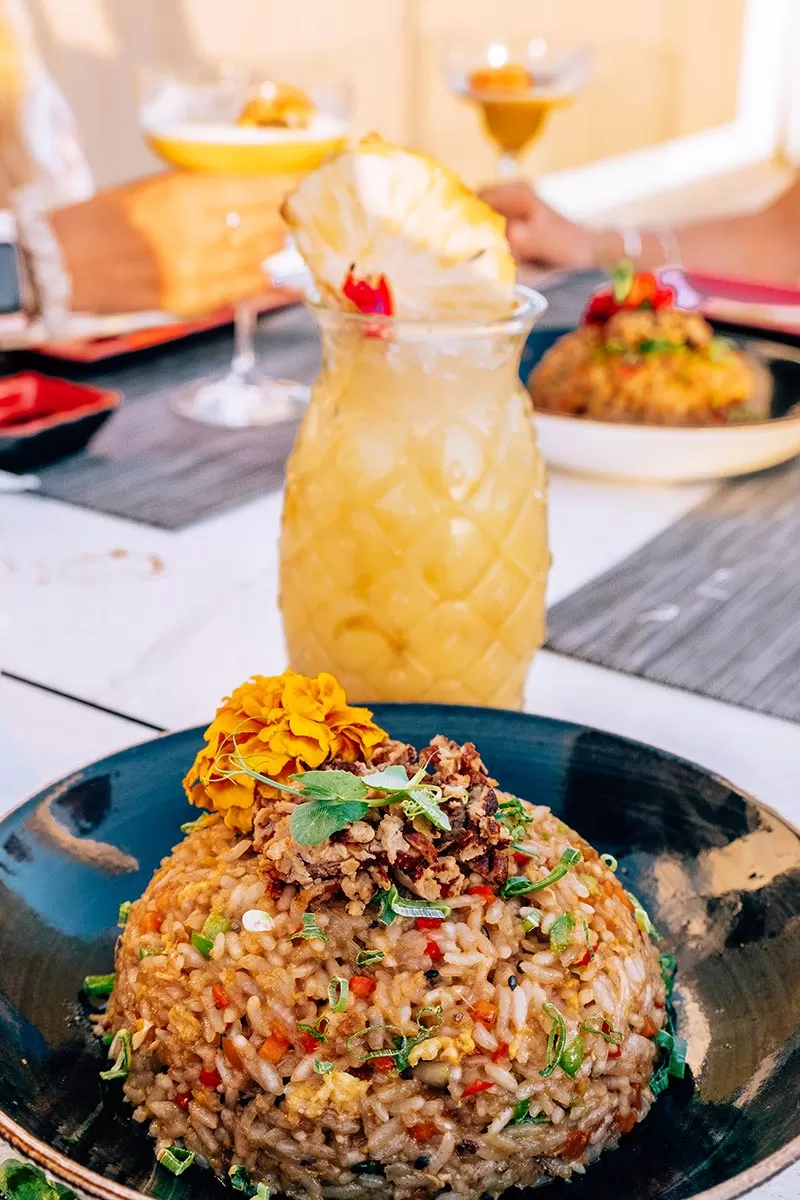
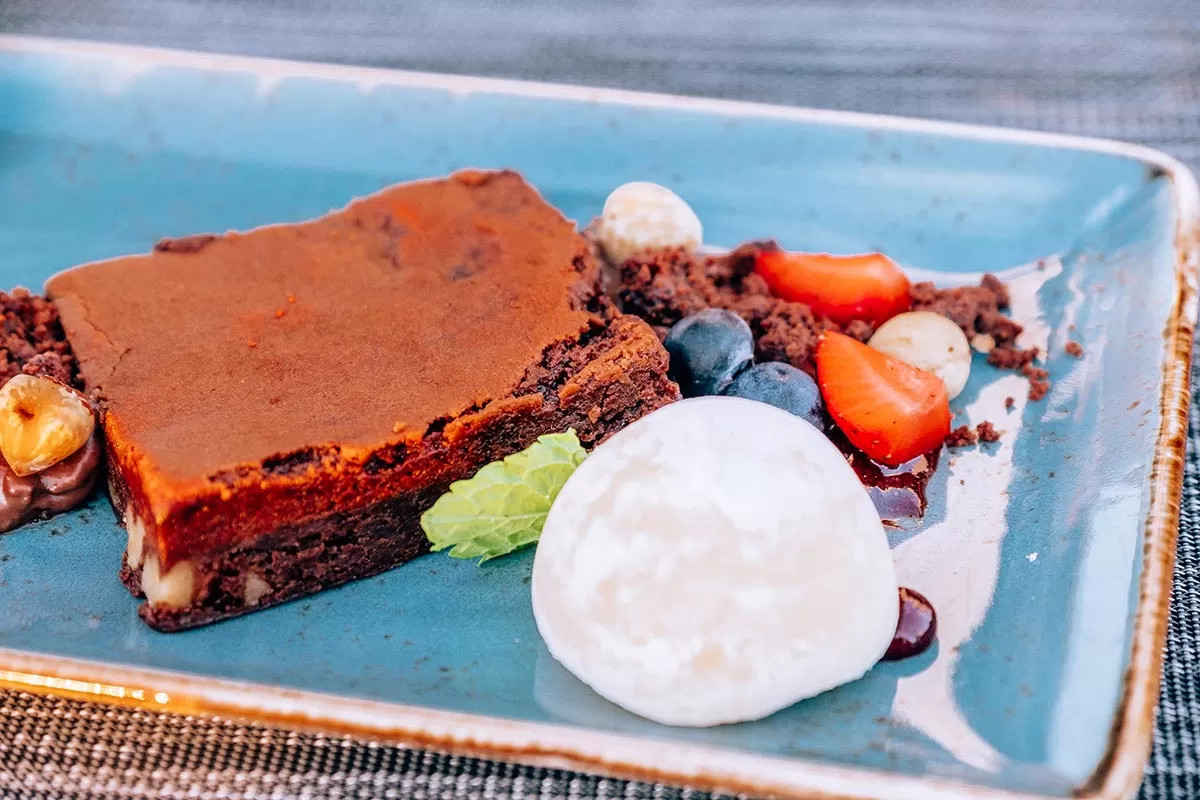
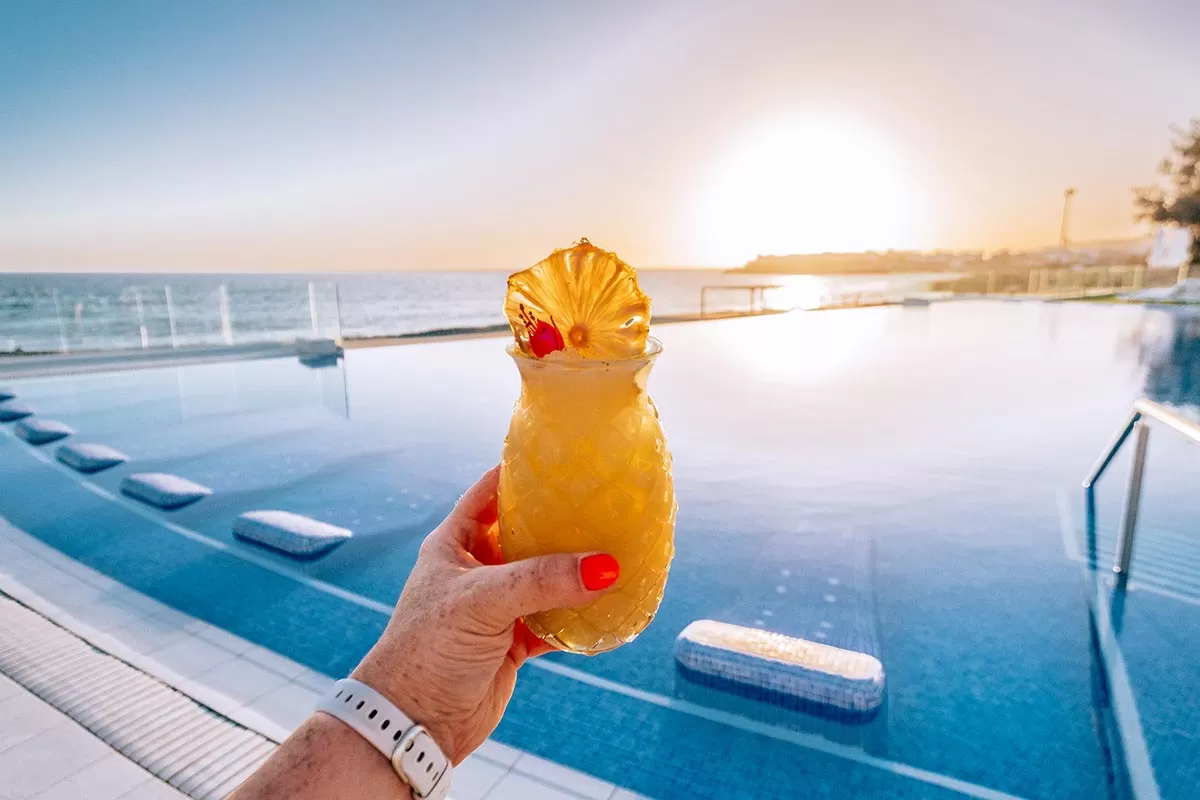
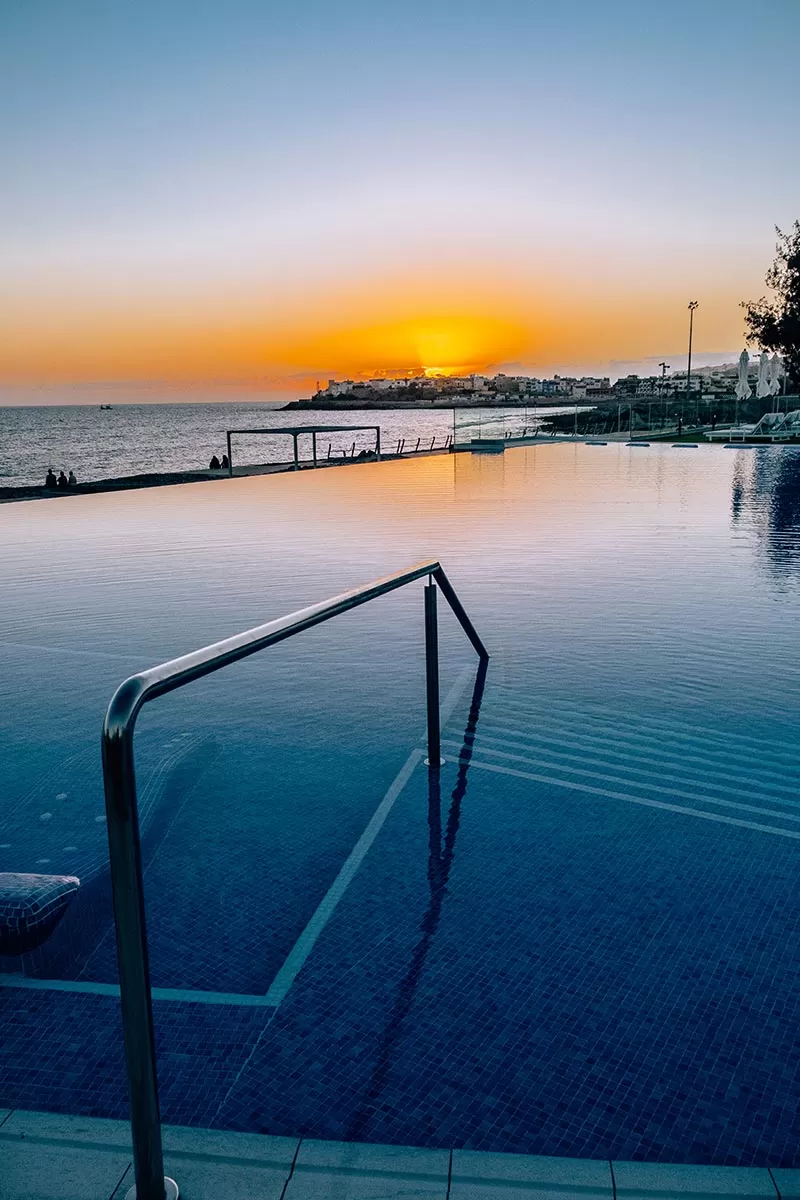 An extensive drinks menu and a host of inventive and potent cocktails (Canarias Iced Tea with blueberry Juice, anybody?) are the perfect accompaniment to watching the sunset from your lounger. When it is time to recharge your batteries after your island escapades, the classy Perchel Club delivers in spades.
An extensive drinks menu and a host of inventive and potent cocktails (Canarias Iced Tea with blueberry Juice, anybody?) are the perfect accompaniment to watching the sunset from your lounger. When it is time to recharge your batteries after your island escapades, the classy Perchel Club delivers in spades.
Info for the Perchel Club:
- €30 for single sunbeds, rising through different options to the Grand Cocoon for 14 people at €250.
- Cocktails – €12
- Sushi dishes €6-25
- (Closed Wednesdays & Thursdays)
- La Arrocería mains from €9
- (Closed Mondays & Tuesdays)
- Summer: 11 am to 9 pm
- Winter: 11 am to 7 pm
- Charrán St., El Pajar, 35128, Santa Agueda – San Bartolomé de Tirajana
- Tel: +34 686 775 385
- Check availability and book your full day pass with lunch here
18. Shop for regional delicacies Sunday market in Teror, a wonderfully preserved old town
We now head through the central highlands to delightful Teror. At first glance, a town called Teror might not sound like an enticing prospect. But Teror is one of the architectural highlights on the islands, known for its colorful market and rich heritage.
Teror is rightly known as the island’s ‘green town’ due to its position at the heart of natural parks and nature reserves. It is also a historic site for pilgrims, who visit the iconic Basílica de Nuestra Señora del Pino. The venerable church overlooks the scenic Plaza Nuestra Señora del Pino, a delightful spot to appreciate the charming church.
Leading to the town square is the well-preserved Calle Real de la Plaza. The multi-hued facades of the houses serenely lining the street are exceptionally beautiful. The intricate facades and distinctive wooden balconies are so well-maintained that it’s hard to believe they are centuries old.
Along the fabled street are many cool shops and places to find quality mementos.
If hunger calls, check out Mi Balconcito (Plaza Ntra. Sra. del Pino, 8, 35330 Teror) on the plaza. This unpretentious tapas bar is inexpensive and offers a delectable selection of small plates and craft beers. Their pleasant streetside seating is perfect for people watching and soaking up the charms of Teror.
Teror is also renowned for its feted Sunday market. If you can make it, you’re in for a treat. Several, probably.The Mercadillo de Teror floods around the plaza and the hallowed basilica. It is one of the best places on the island to enjoy regional, artisanal products.
Amongst the tantalizingly ripe produce and sweet baked treats, you will find chorizos de Teror (a meaty spread), cheeses from local farms, and morcilla dulce, a sweet black pudding made with almonds. Yet another delight for gourmands and experience seekers.
If you have time to spare in Teror, there are a couple of delightful green spaces. Just outside Teror is the Parque Rural de Doramas, a picturesque nature reserve shaped by ravines and laurel forests. Then there are the scenic gardens at Finca de Osorio. Both parks are pleasant places to stretch your legs before jumping in your car to complete your journey to the very last entry on this list of things to do in Gran Canaria.
Info for Teror:
- Market – Sundays, 8 am to 2 pm
- Parque Rural de Doramas – Camino Lomo las Vacas, 10, 35421, Las Palmas
- Finca de Osorio – Gran Canaria 402, Km 5, 35339 Teror, Las Palmas
19. Be dazzled by the gleaming altar in the Basilica of Our Lady of the Pine
The Basilica of Our Lady of the Pine in Teror deserves its own entry in this list of things to do in Gran Canaria.
The church honors Virgen del Pino (Virgin of the Pine), the patron saint of Gran Canaria. Legend tells that an image of the Virgin Mary appeared in a pine tree outside the basilica in 1492. Since then, Teror has held a unique place in the island’s culture.
Completed in 1760, the ornate basilica is one of the oldest and most recognizable churches in Gran Canaria. The neoclassical exterior supports a striking clock tower, a bell tower, and 10 distinctive gargoyles whose gaping mouths help drain the roof.
The facade is handsome, but the dazzling gilt interior is exceptional. An intricately decorated central altar depicts the Virgin Mary and Jesus.
The early 16th-century sculpture is believed to be one of the oldest in Gran Canaria. It has been attributed to Jorge Fernandez, a gothic sculptor who created some of Spain’s greatest gothic works. Included in his repertoire are the dome and altar in the Seville Cathedral.
The altarpiece is the focus of the annual Fiesta de la Virgen del Pino (Feast of Our Lady of the Pines) on the 8th of September, one of the biggest festivals on the island.
The altar is all the more striking as it sits under a bright dome designed to showcase the intricate sculpture in the best possible light. Several other altarpieces adorn the walls to create one of the most lavish church interiors on the island.
The church is free to enter and opens daily, from 8.30 am to 2 pm and 4-7.30 pm (except Mondays, when it is closed during the morning.)
As you would hope, this church sits on a shady square where time stands still. The Plaza Nuestra Señora del Pino is especially attractive. With an enormous tree providing shade, it is a delightful spot to admire the attractive exterior.
For more details, visit the official website.
20. Gaze at the soaring spires of Saint John the Baptist Church (Parroquia de San Juan Bautista de Arucas)
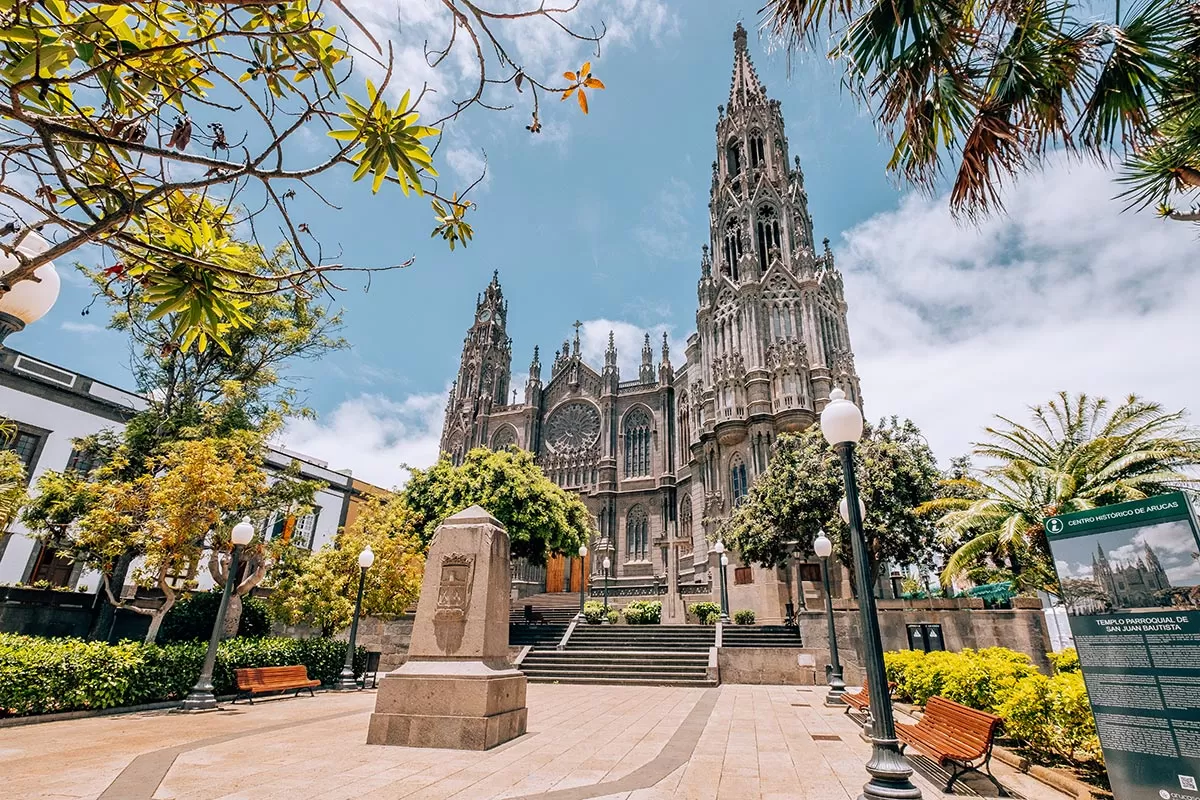
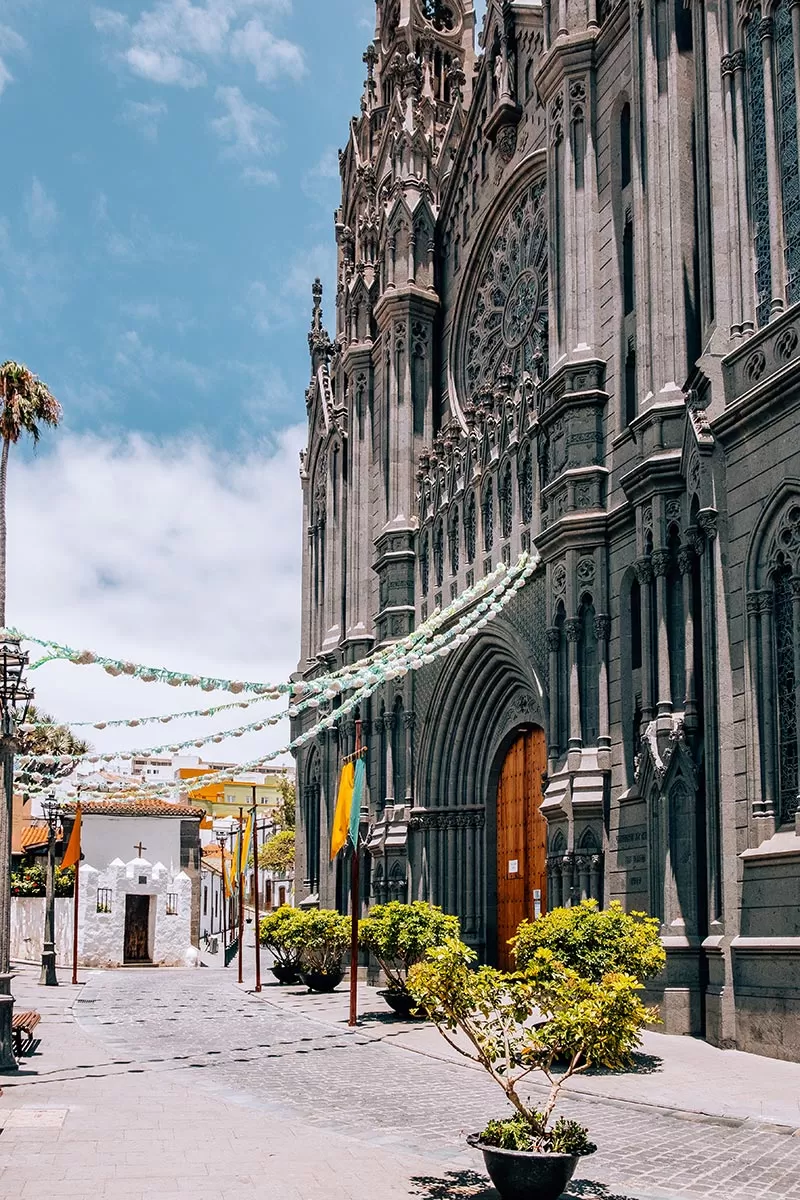 There are several compelling reasons to visit Arucas. The “Cathedral of Arucas”, aka Parroquia de San Juan Bautista de Arucas is one of them.The gothic Saint John the Baptist Church looks entirely out of place on the island. It looks like no other church in Gran Canaria.
There are several compelling reasons to visit Arucas. The “Cathedral of Arucas”, aka Parroquia de San Juan Bautista de Arucas is one of them.The gothic Saint John the Baptist Church looks entirely out of place on the island. It looks like no other church in Gran Canaria.
It was an audacious decision to replace the ageing parish church that had stood there since 1515 with such a unique design. No whitewashed walls and delicate bell towers. Instead, three imposing towers soar to the sky. A gothic rose window and intricate façade evoke images of ageing European cathedrals.
The striking design was possible because the church is one of the newest on the island. It was built between 1909 and 1977. That might seem like a long time, but the church is entirely constructed by hand, in the stonemason tradition. Don’t worry, the doors were opened to worshippers in 1917.
As is customary in Gran Canaria, the church overlooks a pretty square. Plaza San Juan is small but picture-postcard perfect. The buildings overlooking the plaza are wonderfully maintained examples of Canarian buildings, from homes to religious annexes.
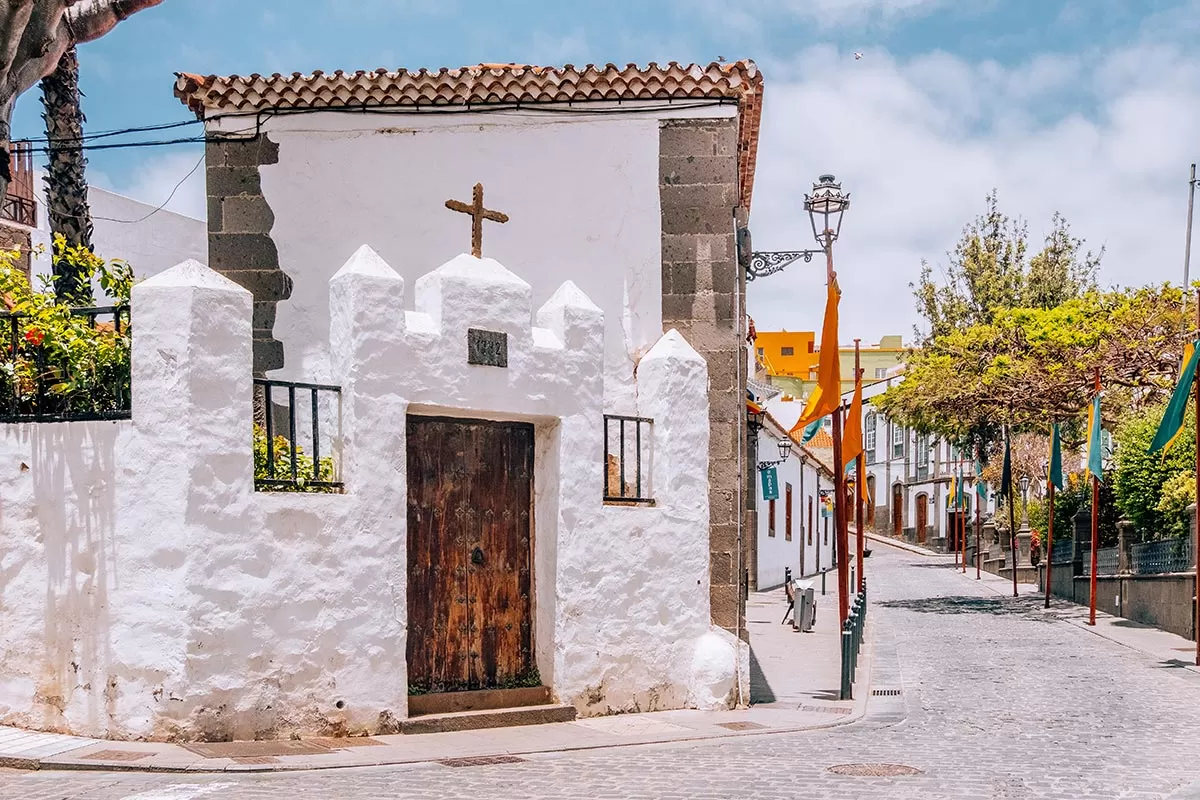
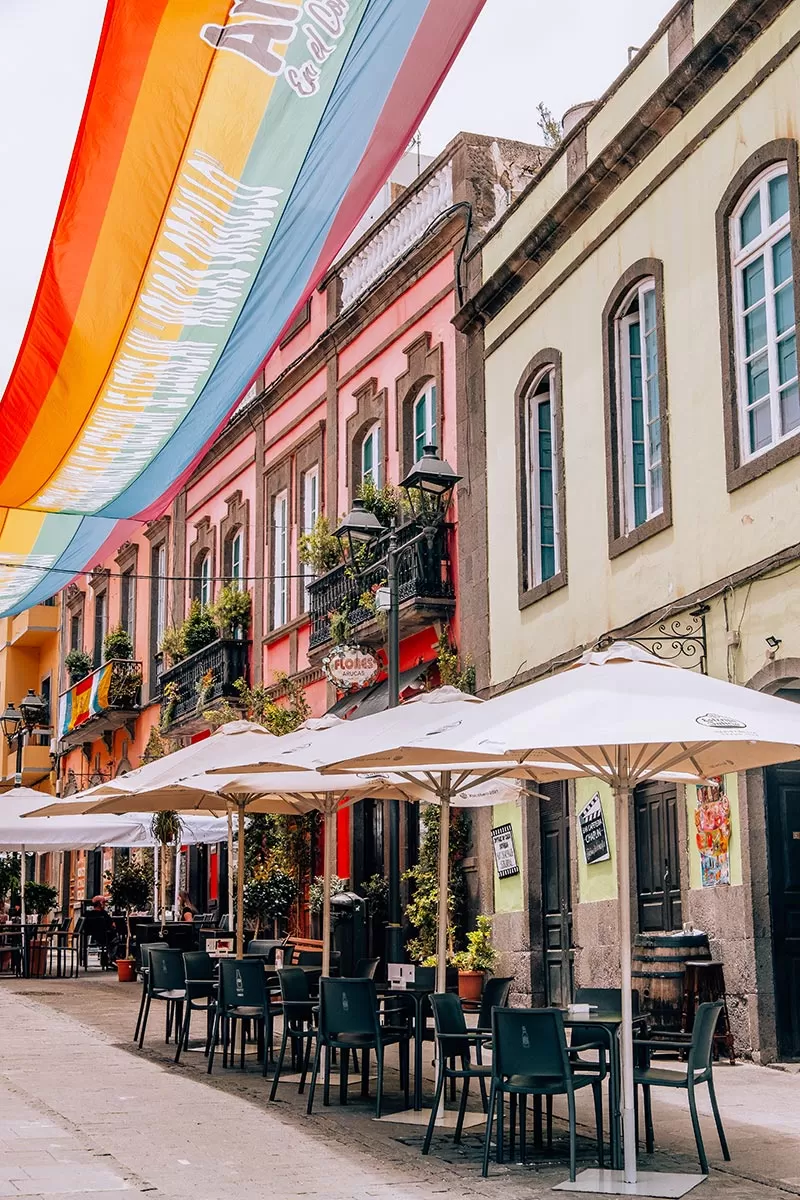
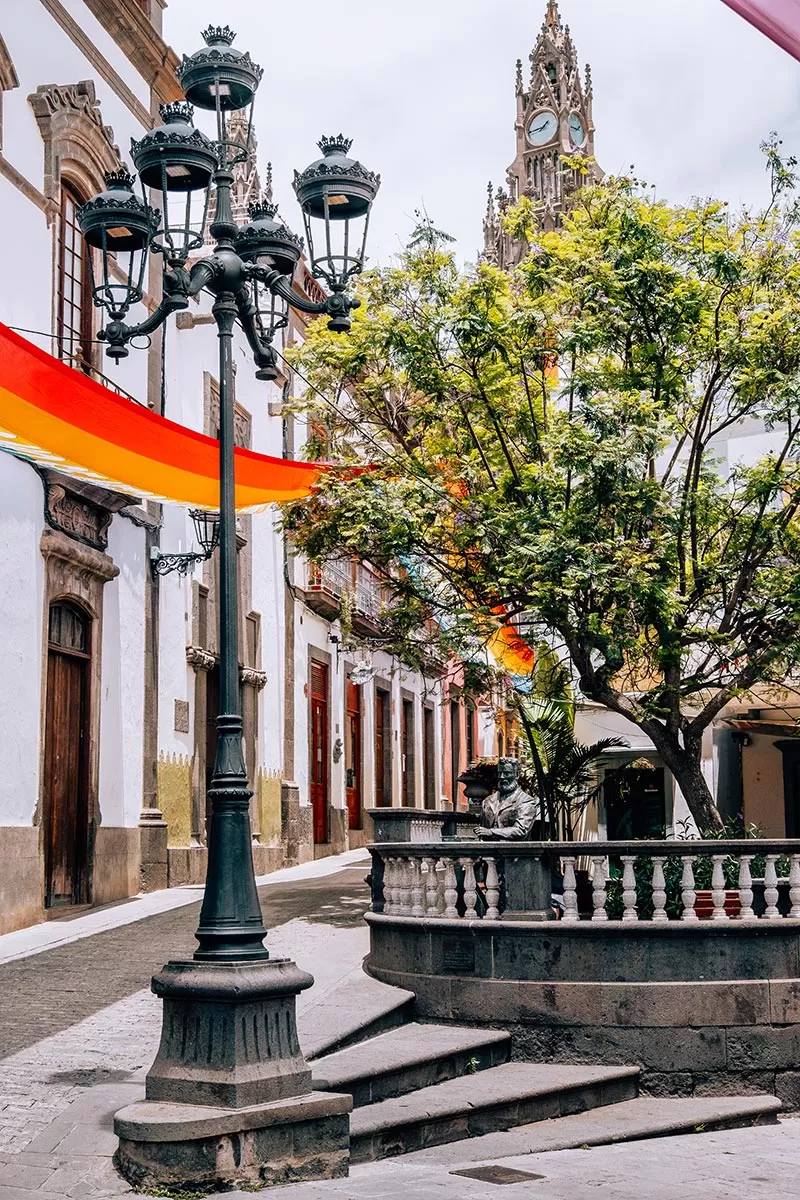
Unlike the imposing ‘cathedral,’ the buildings on the plaza represent various periods from the 17th century to the present day. The spotless and colorful buildings are exceedingly photogenic. If you find yourself in the mood for a show, the whimsically titled New Old Theater is nearby. The venue opened in 1906 and was then in 2013, hence the name.
It can get passé visiting churches anywhere in Europe, even in this far-flung spot off the coast of Africa. But the Saint John the Baptist Church is one of the more extraordinary landmarks on the island. It’s a heady appetizer before hitting one of the most intoxicating things to do in Gran Canaria, sampling the wares at the Arehucas Rum Distillery.
Info for Saint John the Baptist Church:
- Free Entry.
- Open daily – 9.30 am to 12.30 pm, and 4.30 pm to 7 pm.
- For more details, visit the official website.
21. Sample Canarians’ favourite tipple at the celebrated Arehucas Rum Distillery
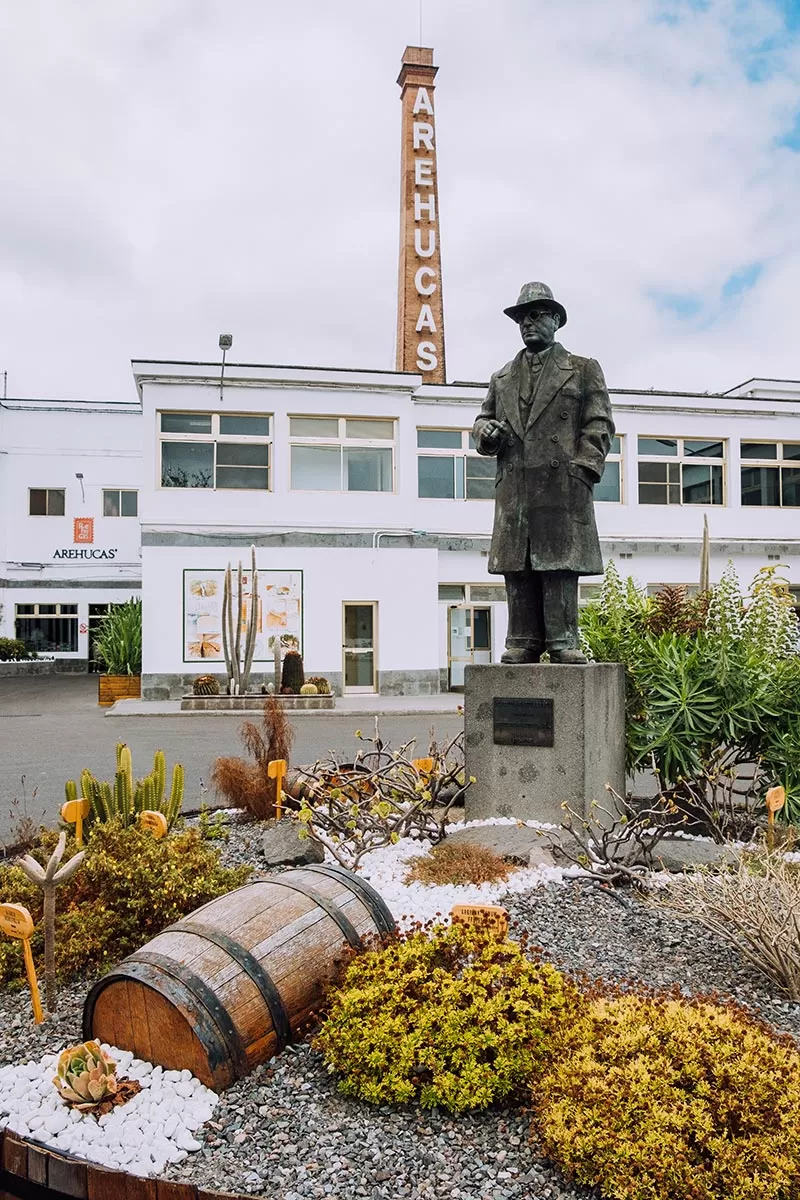
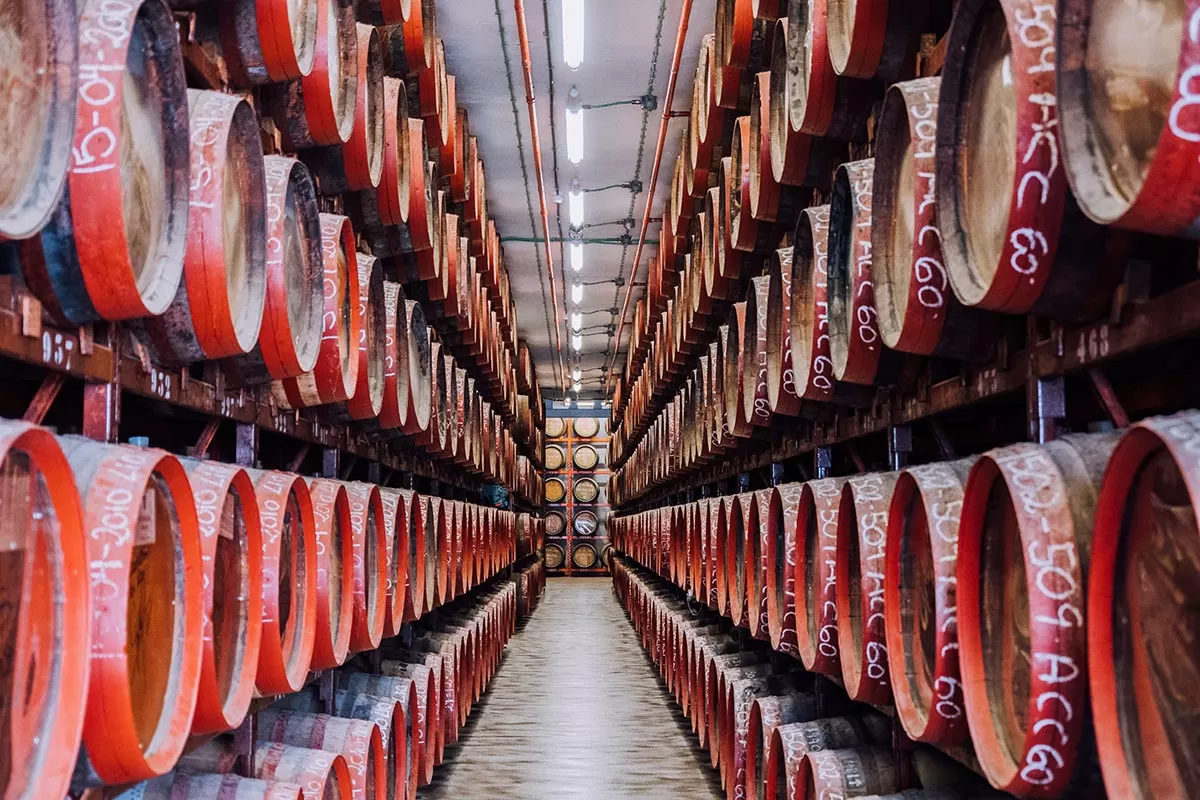 Pirates and sea traders have called in at the Canaries for centuries, so it is little surprise that Canarians have a soft spot for rum. To learn more about the drink, head to the Destilerías Arehucas, the finest rum distillery in the Canaries. The distillery has been in action since 1884. Originally known as La Fábrica, the rum from Arucas quickly gained a reputation across Europe.
Pirates and sea traders have called in at the Canaries for centuries, so it is little surprise that Canarians have a soft spot for rum. To learn more about the drink, head to the Destilerías Arehucas, the finest rum distillery in the Canaries. The distillery has been in action since 1884. Originally known as La Fábrica, the rum from Arucas quickly gained a reputation across Europe.
Their aged rums continue to wow fans of the drink today, which is why the distillery welcomes 95,000 annual visitors into their cavernous cellars. Informed tour guides walk you through the method for distilling rum from sugar cane. It pays to check before arriving as capacity is limited.
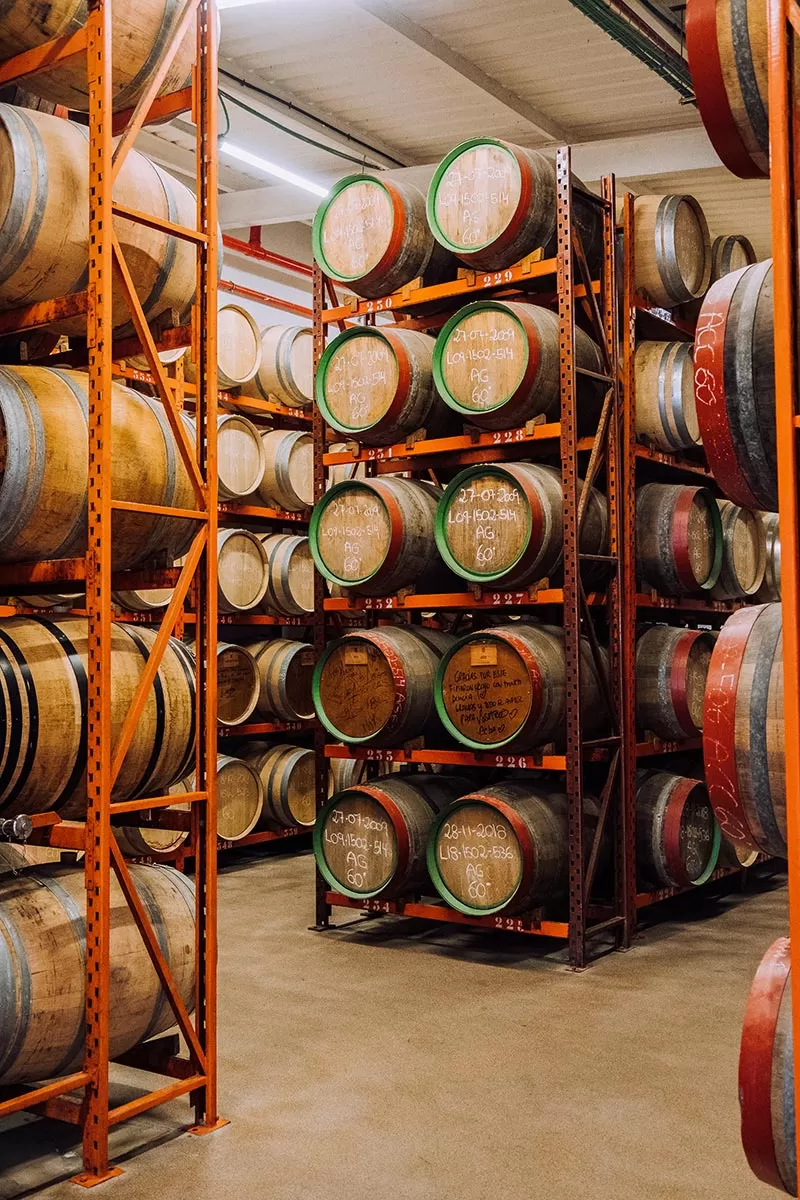
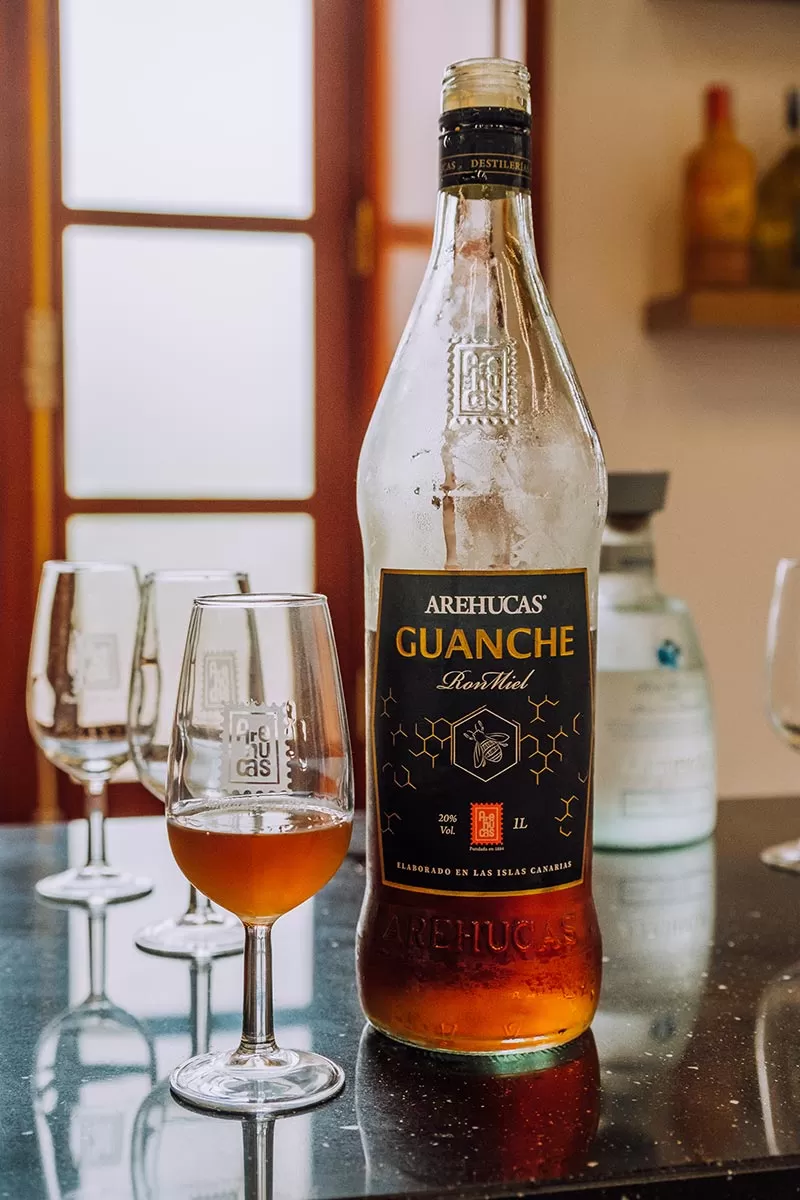 There is no pressure to buy in the shop. But with Ron Miel Guanche (the island’s beloved honey rum) and the exclusive Captain Kidd — aged 30 years — available, it is hard to resist. If you can’t bring back the bottles, don’t worry. You can sample all the rums for a small fee, including the lauded Captain Kidd, which costs as much as all the other rums put together!
There is no pressure to buy in the shop. But with Ron Miel Guanche (the island’s beloved honey rum) and the exclusive Captain Kidd — aged 30 years — available, it is hard to resist. If you can’t bring back the bottles, don’t worry. You can sample all the rums for a small fee, including the lauded Captain Kidd, which costs as much as all the other rums put together!
Once you’ve groggily pulled yourself away from the sampling station, you might want to line your stomach at De Enyesque Arucas. This well-regarded tapas restaurant is just a 10-minute walk from the distillery through the commercial center of Arucas.
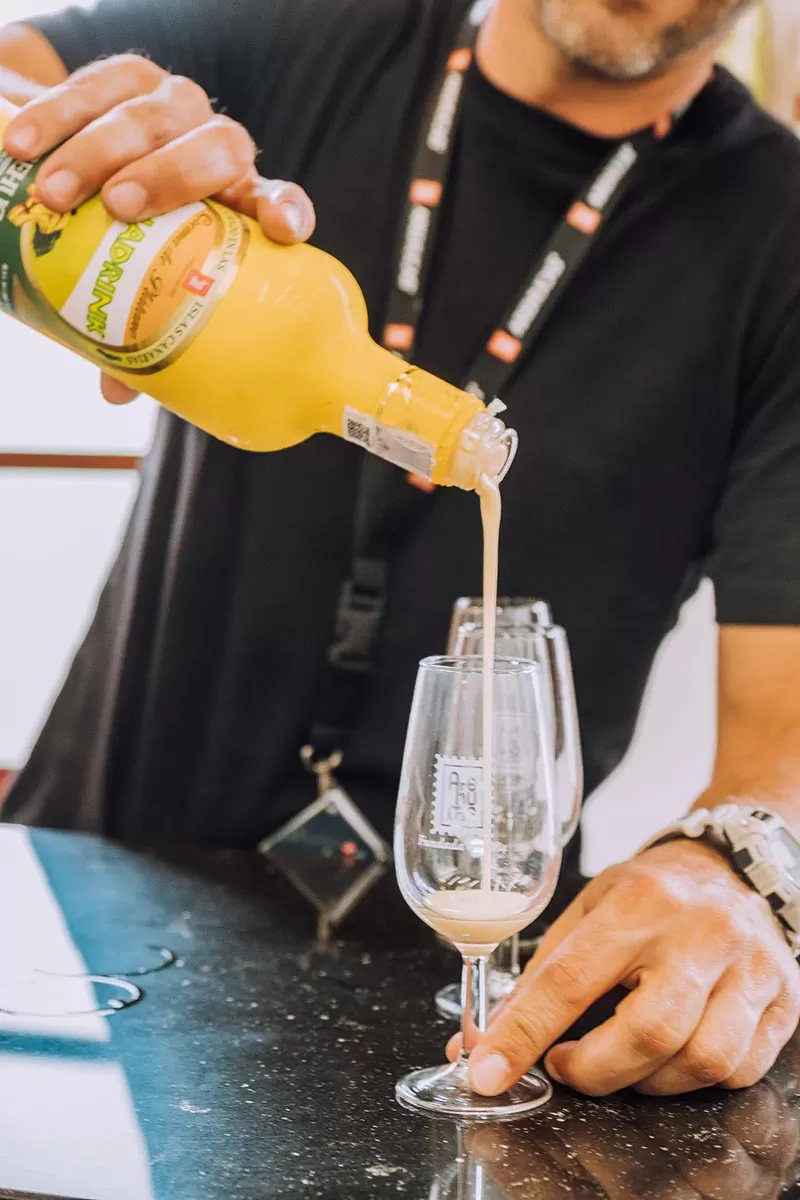
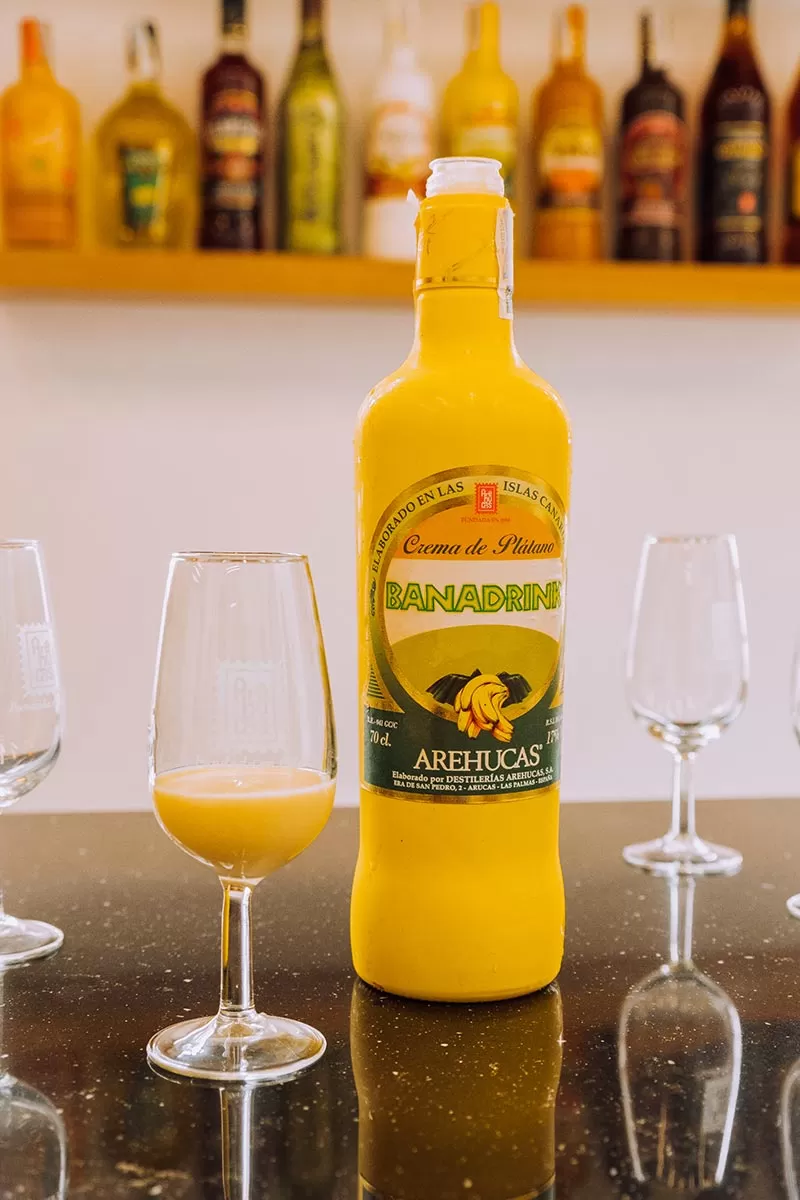 The small plates are typical Canarian fare and a satisfying conclusion to your day of gastronomic discovery. Designated drivers will want to look away now, but the informal restaurant has more rum on the menu. Buen provecho!
The small plates are typical Canarian fare and a satisfying conclusion to your day of gastronomic discovery. Designated drivers will want to look away now, but the informal restaurant has more rum on the menu. Buen provecho!
Before you leave town, there is one more sight that merits a few minutes of your time. The captivating botanical gardens of Jardines de la Marquesa, Gardens of the Marchioness, are a hidden gem.
The small, landscaped green space was built in 1880 for a marchioness who had acquired an interest in collecting plants. Today, the garden is home to over 500 plant species. The lush oasis is a calming diversion before returning back to the bright lights of Las Palmas.
Info for Arehucas Rum Distillery:
- Entry €6.00 (free for children, although not necessarily suitable)
- Monday to Friday – 9 am to 2 pm
- Closed weekends and public holidays (check the website for the complete list)
- 2 Calle Era de San Pedro, 35400 Arucas, Las Palmas
- Tel: +34 928 624 900
- Check availability and book your guided tour here
22. Go bananas at the La ReKompensa plantation
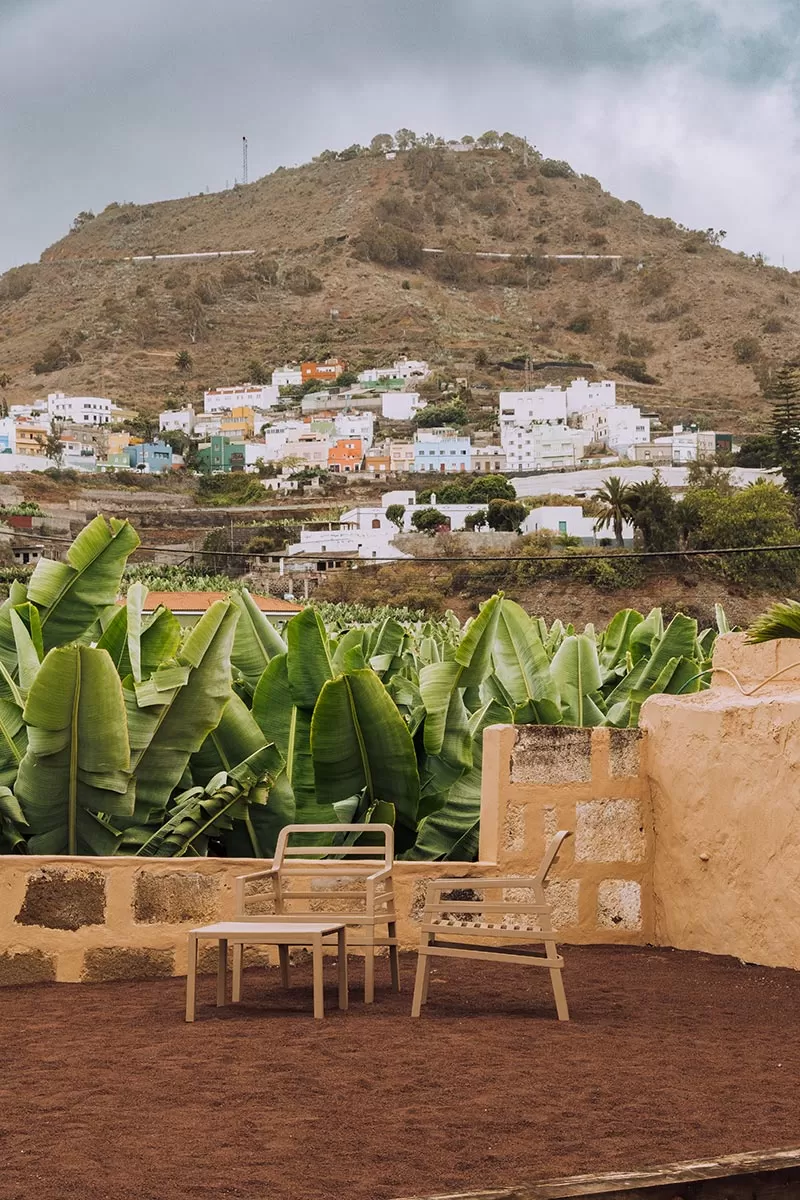
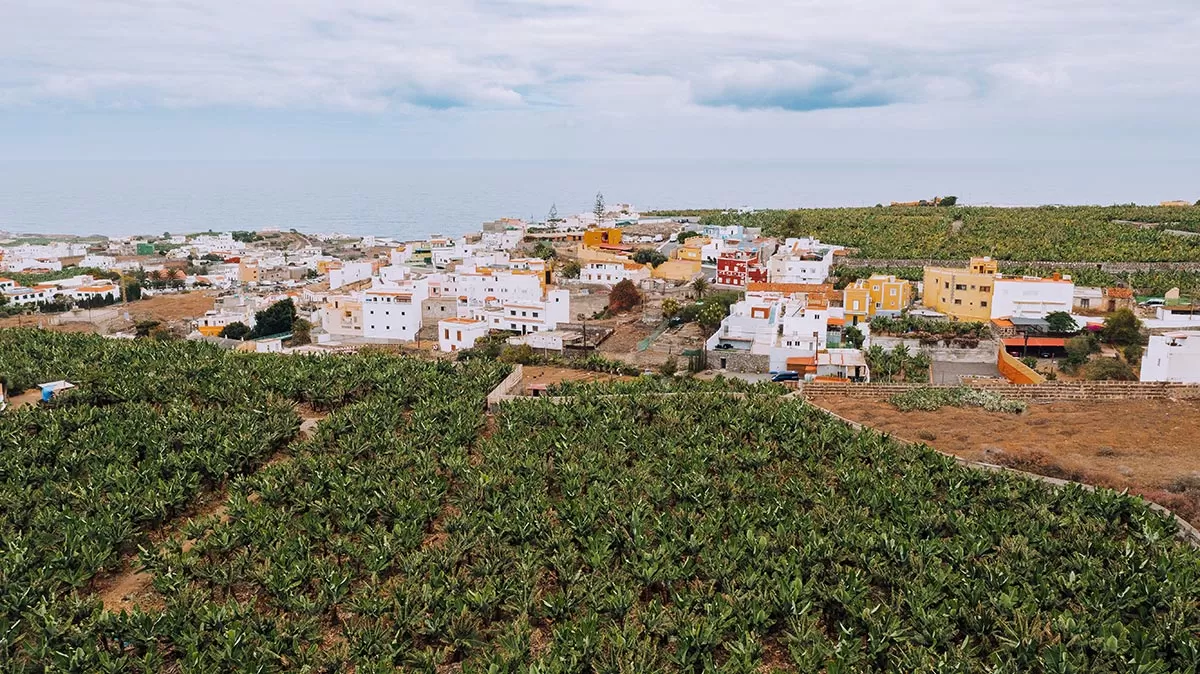
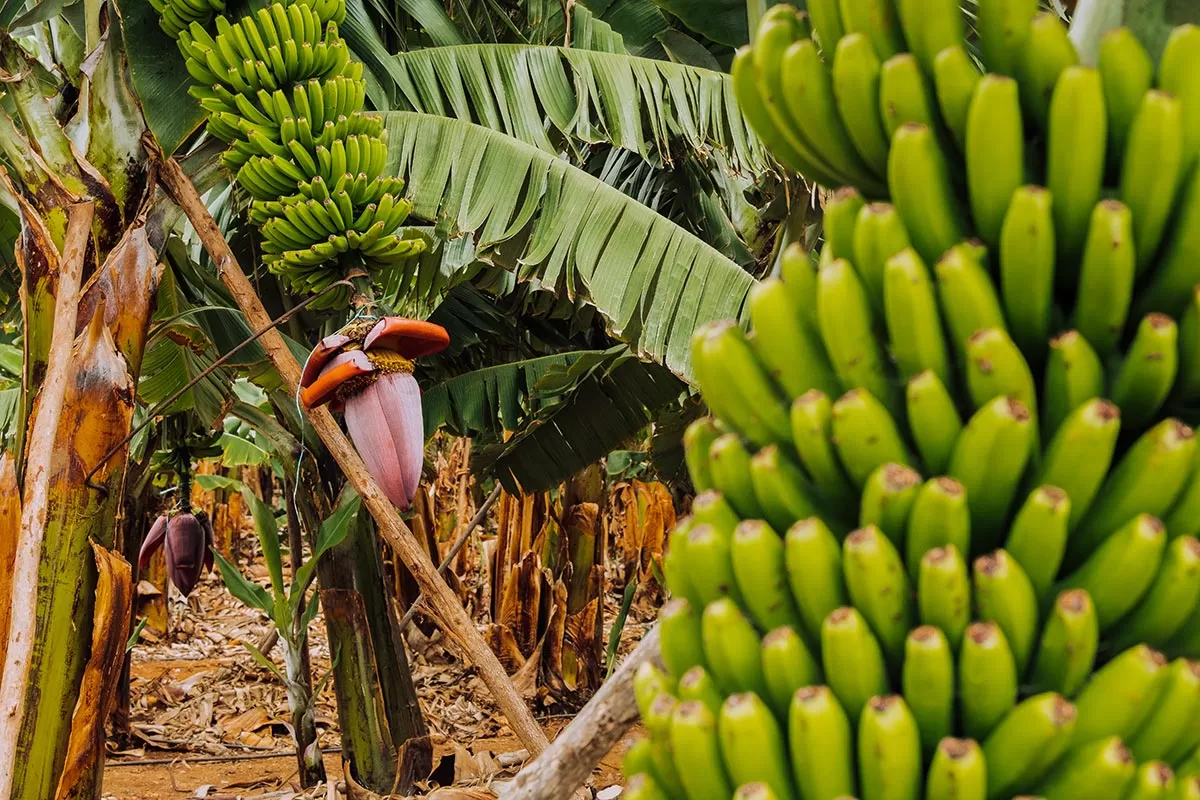 For more tropical vibes, head to the banana plantation at Hacienda La ReKompensa, just a short drive from the rum distillery in Arucas. La ReKompensa is home to a gorgeous Canarian hacienda and facilities that can be hired for weddings and upscale events. Curious visitors are invited to visit the flourishing plantation and taste the freshest of fresh bananas. It’s not your typical European experience, a reminder that you are far from the continent.
For more tropical vibes, head to the banana plantation at Hacienda La ReKompensa, just a short drive from the rum distillery in Arucas. La ReKompensa is home to a gorgeous Canarian hacienda and facilities that can be hired for weddings and upscale events. Curious visitors are invited to visit the flourishing plantation and taste the freshest of fresh bananas. It’s not your typical European experience, a reminder that you are far from the continent.
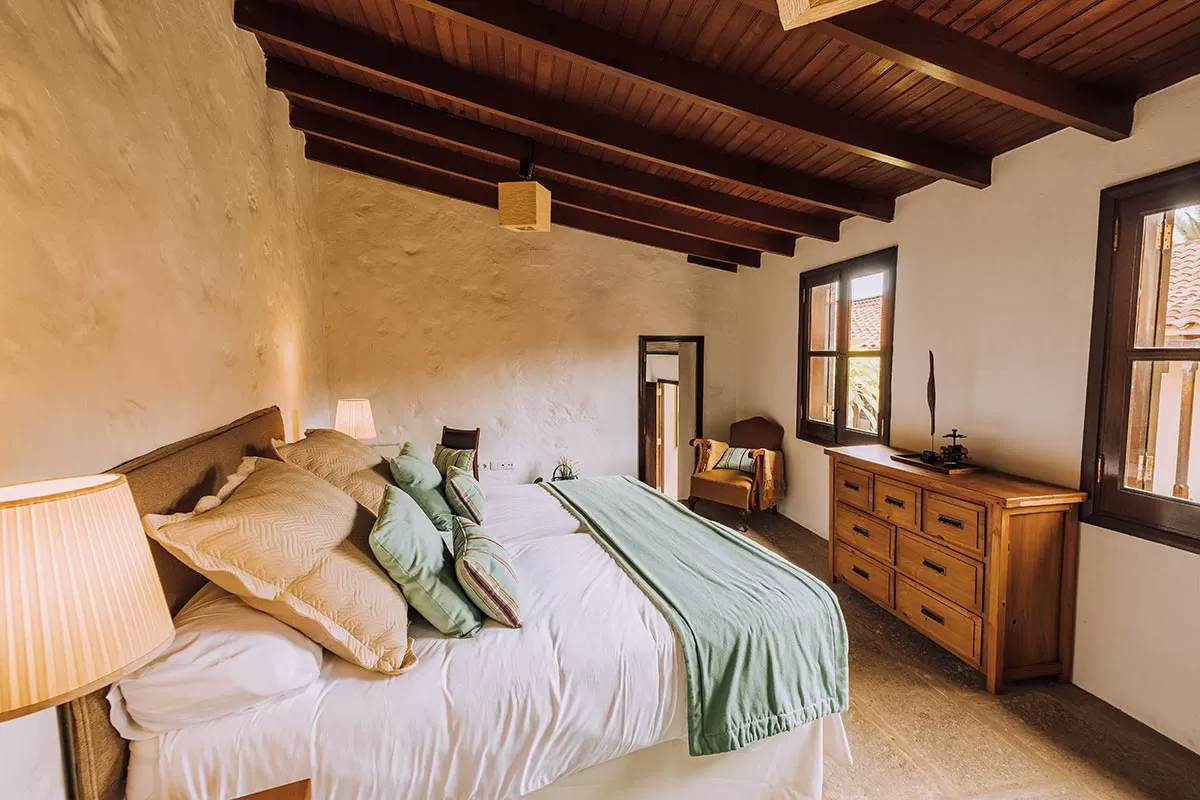
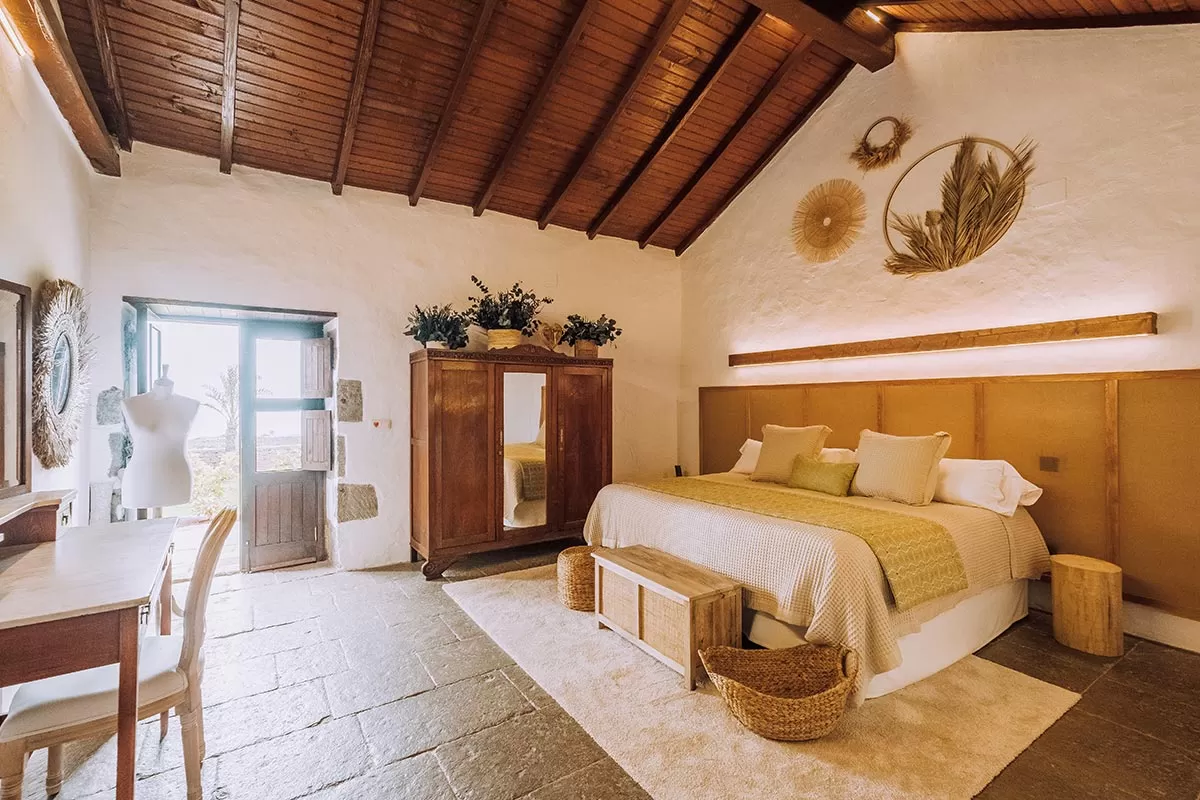
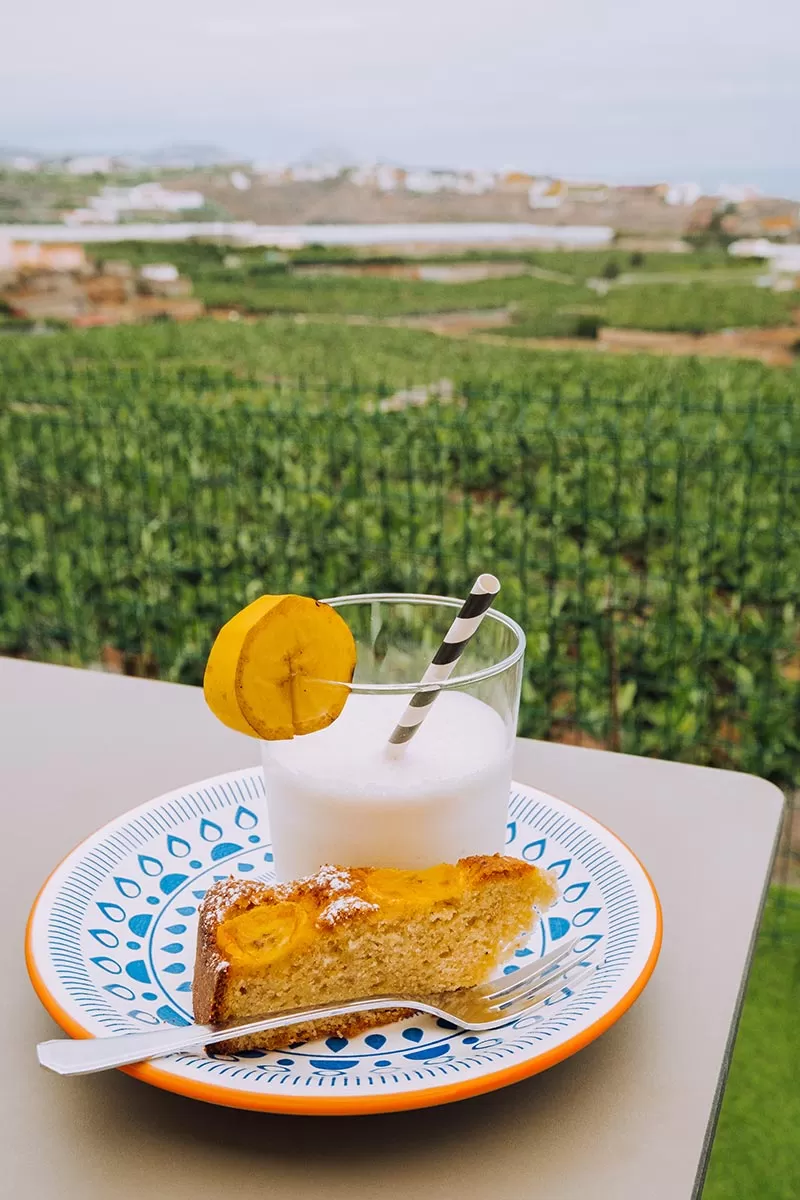
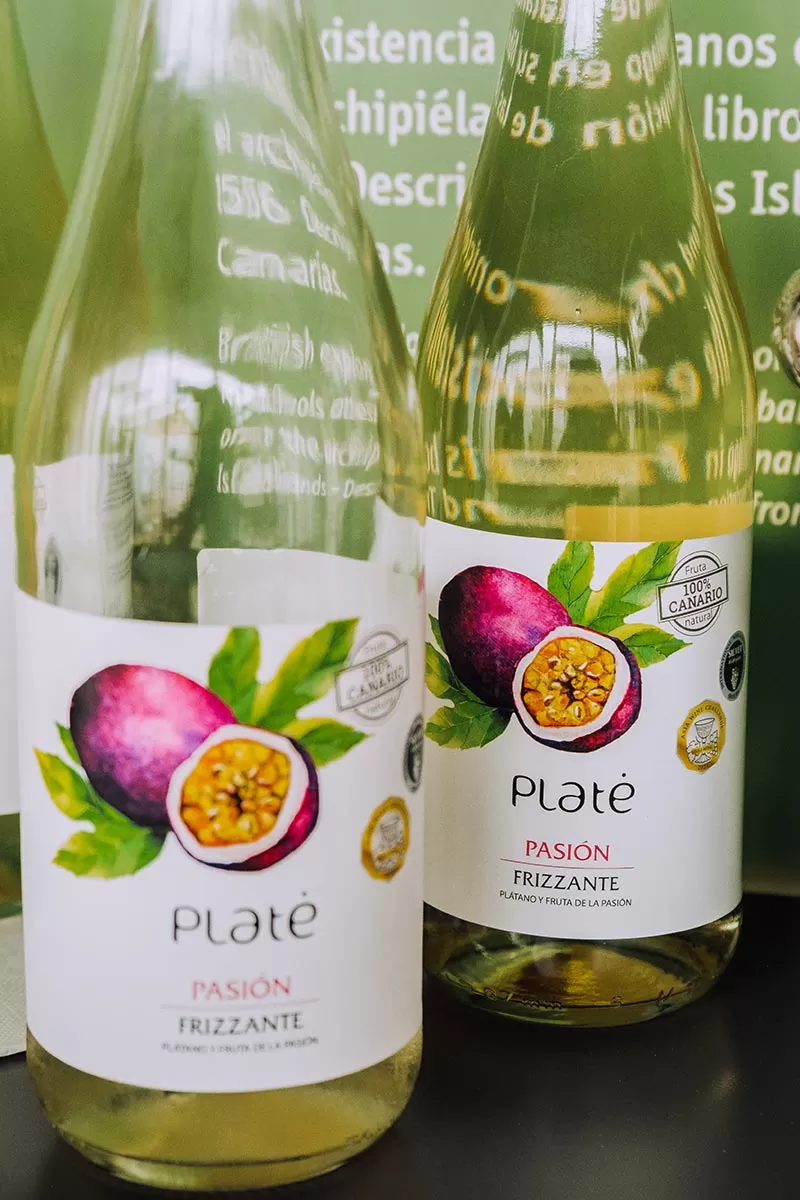
Bananas (and sugar cane) arrived in the Canaries from Asia when Spain settled the islands around 500 years ago. Interestingly, bananas were then exported to the Caribbean. Today, there are over 1,000 banana cultivars growing in 150 countries. Just two varieties are found amongst the 400 trees at the hacienda. La ReKompensa is not the only banana plantation in Gran Canaria. Yet the thirsty trees, which soak up 20-40 litres of water daily, thrive in the wetter north of the island.
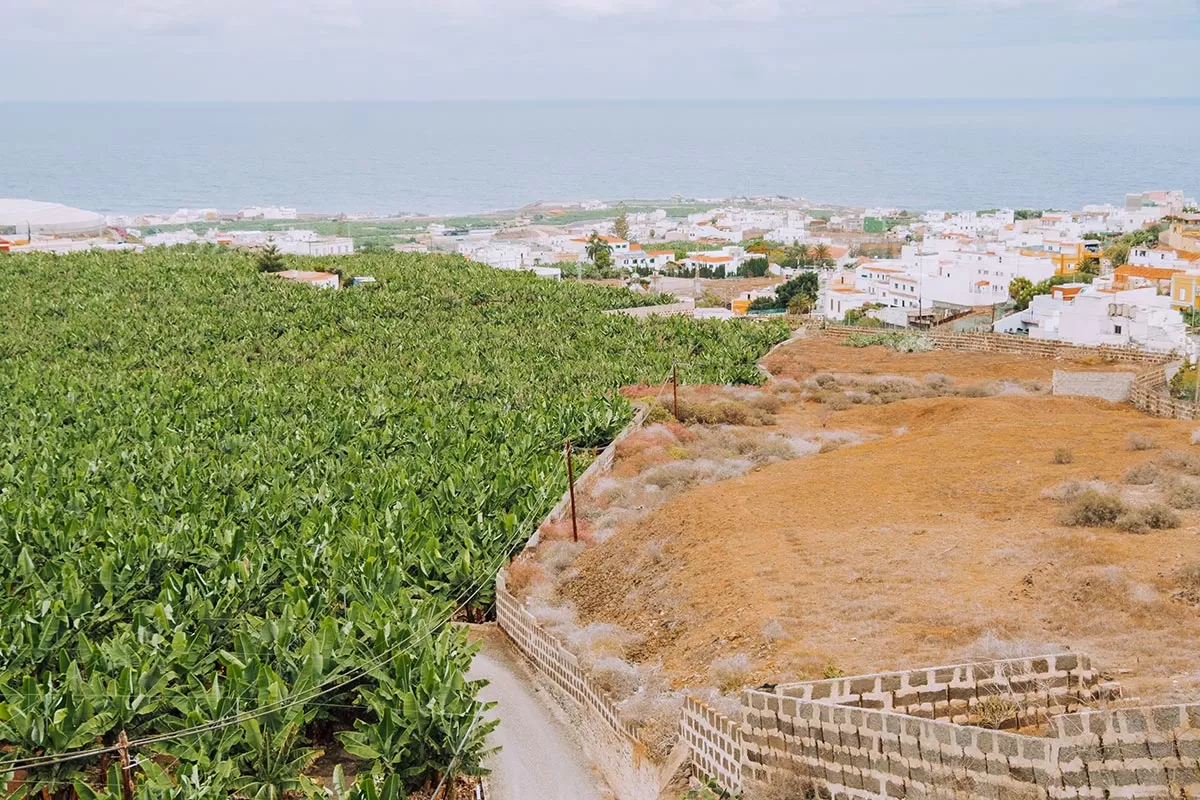
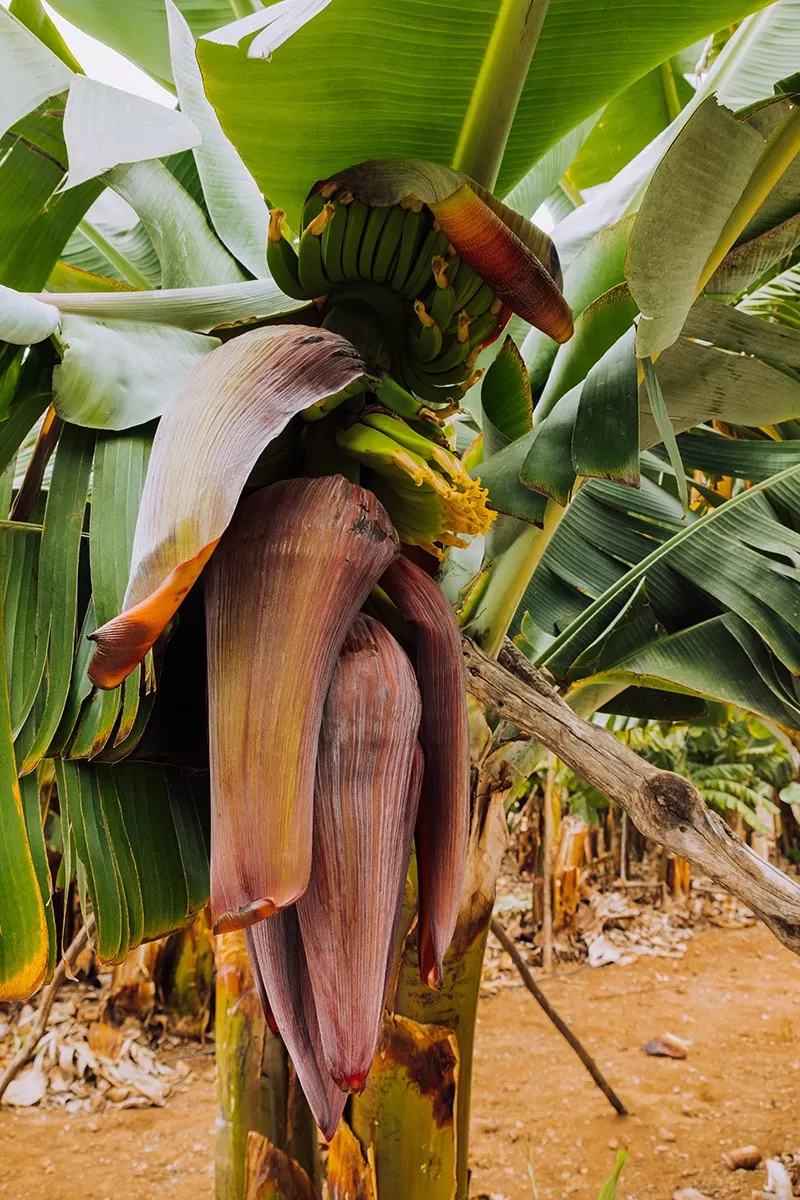
The plantation at La ReKompensa has been here since the 1800s, so the horticulturists know what they’re doing. Even better, the team at the hacienda knows a few things about putting the fruit to mouthwatering use. Expect to find wine, smoothies, cake, and even marmalade made from this versatile fruit. It is all bananas. And all totally delicious.
Info for La ReKompensa:
- 10 Camino del Laurel, 35413 Arucas, Las Palmas
- Tel: +34 619 68 17 76
- To book your stay in this 100-year-old hacienda, click here to check availability and prices
- For more details, visit the official website
23. Head to Amadores beach for some of the calmest waters on the island
The dolphin cruises leaving Puerto Rico de Gran Canaria pass one of the more unique beaches in Gran Canaria. Crescent-shaped Playa de Amadores is artificial and, consequently, one of the most sheltered and in-demand beaches along the west coast.
It is the standout beach around Puerto Rico de Gran Canaria. Crystal clear waters and an abundance of hotels, restaurants, and beachside shops are a magnet for families and bathers.
Teeming with loungers and parasols, Amadores is a classic resort beach. Yet despite being one of the more spacious beaches along the coastline at ½ mile (800 m) long, it can fill up quickly, especially during peak season. If you plan on renting one of the serried ranks of loungers, best get here before lunch.
Carved from the craggy surrounding landscape and protected from the tides, the waters are shallow and immaculately clean. It’s a beach that was literally made for bathing.
In the deeper waters of the beach, there is a small aquapark of inflatable slides, trampolines, and other bouncy structures designed to launch you into the waters at high velocity. You’ll have to pay for the pleasure of being repeatedly dunked: €10 for 45 minutes. Or €25 for a day of endless bouncing, although the park is tiny and tiring and unlikely to keep kids entertained all day.
More sophisticated fun for adults can be found at the Amadores Beach Club. Here you get a pool, cocktails, and a realistic chance of getting a sunlounger after midday. The tradeoff is loud music and eye-watering prices.
If you want a sand and salt free beach experience far from the crowds, Amadores Beach Club could be the right solution for you. Although in my opinion, the facilities at the Perchel Beach Club are superior. You can read about that at #17 in this list of things to do in Gran Canaria.If you’re bored of beaches, you might want to skip Playa de Amadores. But for seductively calm waters, it’s hard to beat.
For more details, visit the official website.
24. Unwind in laidback Puerto de Mogán
In the battle of the western ports, Puerto Rico de Gran Canaria edges in front of Puerto de Mogán for popularity. But you would be missing one of the prettiest and most laidback towns along the coast if you skipped past this delightful town.
The “Venice of the Canaries” is known for its picturesque canals linking the town marina with an atmospheric fishing harbor. The quaint canals typify an unhurried vibe that contrasts sharply with the glitzier resorts of Maspalomas.
Underlining the serene character of the town is the old village of Playa Mogán. The original village is an endearing warren of whitewashed houses that gently ascend the imposing cliffs bordering Puerto de Mogán. Enhancing the sense of escape from modernity, few buildings are taller than two-story.
Add in the bobbing boats of the fishing quay and marina and a small, sheltered beach, and Puerto de Mogán is perhaps one of the most charming towns in Gran Canaria.
But there is more to the town than its waterfront attractions. Intrepid travelers are drawn to Puerto de Mogán for the spirited Friday market, plus a handful of archaeological sites that symbolize the extraordinary heritage of the island.
Foremost is Cañada de los Gatos, better known as Lomo los Gatos (“valley of the cats”). Lomo los Gatos sits at the foot of a volcanic ravine overlooking Playa Mogán. It is a small but well-preserved aboriginal village that offers an intriguing insight into pre-Hispanic Gran Canaria. The views are exceptional too, making the short climb and €4 entry fee a small price to pay.
Four miles (7 km) north of Puerto de Mogán is Mogán’s windmill, or Molino Quemado (burnt mill). Built in 1893, it is a more recent addition to the landscape.
The pretty whitewashed mill is an iconic local landmark. Locals regularly petition UNESCO to grant it heritage status. As yet, the applications have been unsuccessful. But you can see why they care so much. The windmill is a strikingly handsome and solitary silhouette set against the volcanic landscape.
There are some delightful hotels in Puerto de Mogán for a slower-paced vacation. But, otherwise, the town is a satisfying day trip when looking for things to do in Gran Canaria that are a little off the beaten path.
If possible, go on a Friday when the market transforms the picturesque quay.
Be sure to go with an appetite. The market overflows with enticingly fresh goodies, but there are also a few fantastic restaurants in the town. The best of the lot is Casito Mediterraneo (Local 107, 35139 Lomo Quiebre), a chic seafood restaurant with calming views over the yacht-filled marina. The chances are, you won’t want to leave!
25. Get wet and slimy at the crazy Fiesta del Charco
Continuing our tour of things to do in Gran Canaria along the western coastline, we’ve got to make a special mention of the Fiesta del Charco.
This eccentric festival dates back centuries and involves getting wet and smelly as you attempt to catch fish with your bare hands. It’s as bonkers as it sounds.
As you might expect, it’s a wild event that attracts around 15,000 participants and spectators every September 11.
Despite the fiesta-like atmosphere, the ritual has its roots in aboriginal practices. At one time, early Canarians would use the sap from the cardón cactus or tabaiba shrub to sedate fishes trapped in puddles before pulling them out by hand.
Over time, the fiesta was adopted as a religious festival to celebrate San Nicolás de Tolentino. He is the patron saint of many things, most notably of souls lost in purgatory. The village hosting the festival — La Aldea de San Nicolás — is named after him.
Nowadays, you can believe what you want provided you follow the rules. The competition starts with everyone gathered behind a lime perimeter drawn around a lagoon filled with fish. A starter pistol unleashes the chaos as everyone dives in and attempts to haul out the fish. No sedatives are applied in the current format, although it’s unlikely everyone is sober.
That’s not the only rule to observe. If you think stripping down to your bathing costume makes sense, think again.
Custom demands you jump in fully clothed. The practice dates back to 1766 when a visiting bishop was appalled to see people stripping off for the event. He soon put a stop to the exhibitionist behavior. Tradition upholds his wishes, although there’s a lot of flexibility in practice.
Grappling slippery fish might not be for everyone. But if you’re looking for utterly bizarre things to do in Gran Canaria, and you happen to be on the island at the time, this is one event you won’t forget in a hurry.
Info for Fiesta del Charco:
- Every 11th September in La Aldea de San Nicolás.
- Anyone can join in. Bring a basket if you plan to barbecue the fish later (mostly tasty, oily mullet). Here’s a video to whet your appetite.
26. Enjoy dizzying views from the Mirador del Balcón viewpoint
There are more sedate things to do in Gran Canaria than hauling fish with your bare hands. The Mirador del Balcón viewpoint is equally unforgettable, and you won’t get wet.
Positioned along the coastal road between Agaete and La Aldea de San Nicolás de Tolentino, the viewpoint is a platform protruding from a cliff face, 1,171 ft (357 meters.) Far below your feet, the Atlantic laps the shoreline.
Along the coast rises the jagged cliffs of the aptly named Cola de Dragón, or Dragon’s Tail. Before you, the horizon stretches away across the ocean. On a clear day, you can see shadows of Tenerife rising from the waters.
It is a breathtaking panorama that demands a stop if you’re traveling along the winding, dizzying coast road to Agaete. Just don’t look down if you’re not a fan of heights.
Where to find the Mirador del Balcón viewpoint: Along the GC-200 (via the GC-2.) Take the exit towards Andén Verde. It’s a 30-40 minute drive from Agaete, and under 10 minutes from La Aldea de San Nicolás de Tolentino.
27. Get back to nature in the Tamadaba National Park
Continuing along the giddying GC-200 highway to Agaete from Mirador del Balcón, you quickly arrive at the Tamadaba National Park.
Home to hiking trails through pine forests, soaring cliffs, and deep valleys, the 7,500-hectare national park sits within a UNESCO biosphere. It is a richly layered landscape peppered with stunning vistas and points of interest.
Its most spectacular sight is the Tamadaba Massif, a breathtaking series of ravines descending to the sea formed by a volcanic eruption 14 million years ago.
At one point, the Tamadaba massif tumbles over the Roque Faneque, an escarpment 3,307 ft (1,008 m) above sea level. At its peak stands a verdant pine forest, 4,737 ft (1,444 m) above sea level. It is one of the most remarkable sights in Gran Canaria.
Take binoculars. Many birds have made the protected parklands their home. The wildlife includes endemic species like the greater spotted Woodpecker and blue chaffinch.
Several signposted hiking trails disappear deep into the park. The Roque Faneque trail is the best known. But the Camino del Fin del Mundo (which translates to the End of the World Trail) delivers on its name with stunning views that could easily be the end of the world.
Whether you are the type to lace up your hiking boots or enjoy the parts you can reach by car, the Tamadaba National Park amply rewards sight-seekers.
28. Travel down the sublime Fataga ravine
Fataga ravine is one of many spectacular ravines found in the mountainous interior of Gran Canaria. Yet this one has a poignant history to go with the views.
Formed nine million years ago, the vast gorge scythes vertiginously through the rocky landscape. The island’s second longest ravine is a protected site of geological interest, shaped by volcanic eruptions and erosion revealing how the island was formed.
But the ravine also holds cultural significance as one of the last strongholds of the Guanche islanders who lived here before the Castillian conquest. The Guanche used the caves — natural and man-made — and the challenging terrain to resist the unstoppable invaders.
Within the ravine’s protected biosphere is the picturesque Fataga village, which can trace its history back 2,000 years, and the Arteara Archaeological Site.
Arteara necropolis is the largest aboriginal burial complex on the Gran Canaria. There are 809 tombs in a cemetery covering nearly 14 hectares. The tombs date back 1,300 years and include individual and collective burial mounds. Walkways that let you explore their layout, and an information center help visitors understand the cultural importance of the historic site.
The most significant mound is the ceremonial ‘King’s Tomb,’ which reveals an understanding of the solar system. During the equinox, the tomb is bathed in light that pours through the ravine during the morning, underlining advanced scientific knowledge and the importance of the Fataga ravine in Guanche culture.
With stunning views and a rare insight into the pre-Hispanic culture of the island, Barranco de Fataga is a rewarding destination. As I will illustrate with my following recommendations for things to do in Gran Canaria, there is plenty more to see in the area.
Info for the Arteara Archaeological Site:
- Entry €4.
- Open 10 am to 2 pm daily. Check opening hours here, as the site may be closed during the off-season.
- Location: On the GC-60 heading towards Fataga.
29. Drink in panoramic island views at Degollada de la Yeguas Lookout
To truly appreciate the scale of the Fataga Ravine, the Degollada de la Yegua Lookout is an essential stop. The views are spectacular, sweeping through the ravine and out to the Maspalomas Dunes.
The viewpoint sits on the winding GC-60, a marvelous drive rewarded with endless views. The observation deck sits nearly 1,000 ft (300 m) above sea level. From that vantage point are commanding views over the canyon. It is an essential stop to savor the sheer scope of the Fataga Ravine.
Of note is the surprisingly verdant landscape in the gullies and foothills of the ravine, which contrast markedly with the arid and rocky topography near the summit.
The only reason to make the detour to Mirador Astronómico de la Degollada de las Yeguas is for the views. But those views are awe-inspiring.
30. Visit the timeless Valley of a Thousand Palms and Fataga Village
The Valley of a Thousand Palms is as beautiful as it sounds. The lush green valley, home to thousands of palm and fruit trees, leads to the enchanting Fataga Village.
The drive through the valley illustrates how fertile Gran Canaria is when you leave the craggy peaks of the highlands. You may even spot visitors riding camels through the verdant valley, a gimmick that befits the terrain.
The short drive through the valley brings you to one of the quaintest villages in Gran Canaria. Fataga village was once a Guanche settlement and can trace its roots back 2,000 years. Today it is known for pristine whitewashed houses, colorful floral decorations, and cute narrow streets. An unhurried air is only punctuated by the coach loads of tourists drawn to the treasures in and around Fataga.
Fataga was at the center of Guanche’s resistance against the Castilian invaders between 1478 and 1483. After 5 years of resistance, the final battles were played out in the hills and caves of the region until Guayarmina Semidán, queen of the Guanche, finally accepted defeat.
Fataga proved to be a prosperous region for settlers on the island. At one point, the village housed 650 inhabitants living off the rich agricultural terrain. The population stands at around 265 villagers today, sustained by the influx of visitors looking for picturesque things to do in Gran Canaria.
The village is home to several restaurants and an old bakery, making it a pleasant stopover for travelers. But you’ll want to make time to explore the dreamy streets too.
The first stop for many visitors is the Iglesia de San José. The dainty church, built in 1880, has a twin belltower and sits in a leafy square. Opposite is the town’s commercial center, which consists of a couple of shops and restaurants.
The unassuming Restaurante El Labrador overlooks the church. It doubles up as a bar with a shaded terrace. A chilled spot for a cold drink or a simple Canarian meal.
Exploring the picture-postcard streets of a Fataga village is a timeless experience and an idyllic finish to a journey through the Fataga Ravine.
31. Take a gentle stroll under the laurel tree canopies at Los Tilos de Moya Nature Reserve
Northwest of the Parque Rural de Doramas, about a 40-minute drive from Teror, sits the Los Tilos de Moya nature reserve.
The reserve is a verdant forest filled with laurel trees, some of the last on the island. A well-signposted circular walk is far less challenging than many hiking trails on higher ground. Under a shady canopy for much of the route, walking around the forest is a breeze. Ideal if you want outdoor things to do in Gran Canaria that are suitable for small children.
There are several trails, with the shortest being just 1.2 miles (2km) long. It is a rewarding walk for families or anyone craving a bit of greenery. Along the route are some scenic picnic spots, perfect for an al fresco lunch. More energetic explorers can continue down into the Moya Ravine, which is more spectacular, but about 9 miles (15 km) longer.
All the trails start at the Los Tilos Interpretation Center, which provides information about the appealing flora found around the Moya Ravine. After working up an appetite, you might want to stop at the Restaurante Grill Los Tilos, a solid eatery keeping hikers well-fed.
Info for Los Tilos Interpretation Center:
- Entry is free.
- Open daily, 9 am – 2 pm and 2.30 pm to 6.25 pm.
32. Stop for views and local grilled food in historic Firgas
After a short stroll around Los Tilos, you’ll want to make time to visit charming Firgas.
Firgas is a small town nestled in a green landscape, with oodles of character and some fine views over the northern coast of Gran Canaria. It is also only 8 miles (13 km) from Los Tilos Nature Reserve.
Sometimes overlooked by visitors heading to Teror, there are some alluring reasons to stop in Firgas. Founded in 1488, Firgas is one of the oldest towns on the island and has a character that reflects its age and importance.
Topping the local attractions are the Gran Canaria Walkway and Canarias Walkway. Water bubbles down the center of one, like an extended fountain. While the other walkway features colorful paving that depicts the 21 municipal coat of arms of Gran Canaria. Both are showy sights celebrating the town’s role as a freshwater source.
No town in Gran Canaria would be complete without a pretty church, and the fine Iglesia De San Roque does not disappoint. It is another neoclassical, whitewashed gem.
But this time, the town church is eclipsed by the square it sits in. The Plaza De San Roque offers spectacular vistas across the Atlantic. If you need more stunning panoramas, head to the nearby Mirador de Las Madres, which overlooks Las Palmas de Gran Canaria.
Other sights to squeeze in include the handsome Casa de la Cultura, built in 1870. Far older is the Count’s Mill, a water mill that started operating in 1512 and was still turning until 1959, when it was finally abandoned.
Aside from a wealth of magnificent views and architectural gems, Firgas has a vibrant gastronomic heart. Renowned for its watercress plantations and farming heritage, two local specialties are watercress stew and gofio (roasted corn.)
Grill restaurants abound in Firgas. Winning all the plaudits is El Rincon de Marcos. The homely cantina-style restaurant serves inexpensive Canarian and Spanish classics with a mouthwatering grill section. If you are wondering whether to stop in Teror or Firgas for lunch, the good news is they have a restaurant in each town.
It might be tempting to choose between Teror or Firgas. I would recommend fitting both onto your itinerary.
33. Journey back millennia in the Caves of Valerón
Head north of Firgas, and you will find the unusual Caves of Valeron. One of the more intriguing things to do in Gran Canaria, the artificial caves pre-date the Romans and were once used as a giant larder.
Carved into the soft rock of Cenobio de Valerón are 298 compartments on 8 levels. Including storage caves and silos, around 350 food storage spaces have been found in the ancient granary.
Known as Valerón’s “monastery” due to a Roman account of the caves being used by priestesses, the caves were still used to store food until the Spanish conquest in the 15th century.
Recovered fragments demonstrate the compartments were once sealed with hinged doors.
Easy to defend and with a suitable climate for food storage, the caves have been a goldmine for archaeologists. Ceramics, tools, paintings, idols, and human bones have been recovered from the cave complex. Recovered fragments demonstrate the compartments were once sealed with hinged doors.
A site of immense cultural interest, the Valerón caves are absorbing. Carefully arranged walkways let you explore without damaging the fragile structure. While information panels and even several lifesize recreations help bring the island’s ancient history to life.
It doesn’t take long to visit the caves, but they offer a rare glimpse of pre-Hispanic life outside the more common burial grounds. Unmissable, in my opinion.
Info for the Caves of Valerón:
- Entry is €3 (over 14 years) / €2 (10-14) / free (under 10s)
- Open Tuesday to Sunday 10 am – 6 pm (10 am to 5 pm October to March)
- For more details, visit the official website.
34. Admire early wall art in La Cueva Pintada – The Painted Cave in Gáldar
The Caves of Valerón are not the only subterranean legacy from the pre-Hispanic era. The Painted Cave in Gáldar is an even more arresting and historically significant location.
Situated in Gáldar, once the capital of pre-Hispanic Gran Canaria, the “Sistine Chapel” of the Canaries is a splendidly well-preserved set of pre-Hispanic wall paintings. The colorful geometric murals are arranged in groups of 12 shapes (triangles, squares, rectangles), prompting speculation they may have been used as a calendar.
Archeologists date the area’s earliest settlement to the 6th century. Excavations have exposed much of the old hamlet, revealing quadrangular homes centered on one or two rooms. A veritable treasure trove of artifacts was also recovered, with many on display at the Cueva Pintada Museum.
But fascinating as many of the exhibits in the museum are, the headline act is the striking cave decorations. Re-discovered in 1862, the wall paintings were at risk the moment people started visiting them. For many years, this meant you could only view reproductions.
The museum, which opened in 2006, solved the problem by placing the wall paintings behind climate-controlled windows. This precaution allows anyone to come and view the art in its original setting, making the museum one of the most popular things to do in Gran Canaria.
The Caves of Valerón and the Painted Cave in Gáldar are two unmissable places to visit in Gran Canaria for anyone interested in Canarian history.
Info for Cueva Pintada Museum:
- Entry €6 (free for under 18s and for everyone on Sundays)
- From June to September. Open Tuesday to Sunday, 10.30 am – 7.30 pm (opens at 11 am on Sundays)
- From October to May. Open Tuesday to Sunday, 10.00 am – 6 pm (opens at 11 am on Sundays).
- Closed – January 1, 5, and 6. May 1. December 24, 25, and 31.
- For more details, visit the official website.
35. Hike the dramatic Caldera de Bandama
If the history of Gran Canaria interests you, it is impossible to ignore the singular geological history of the island.
Most of the island was formed from volcanic eruptions nine to fourteen million years ago. But head to the Bandama Crater, and you can see the scars of the most recent eruption, which occurred just 2,000 years ago.
The Bandama Natural Monument encompasses a crater measuring 3,300 ft (1 km) across and 700 ft (200 m) deep. The relatively shallow crater resulted from a phreatomagmatic eruption, which occurs when water touches magma. Today, the earthly cavity is verdant terrain, especially at the base where numerous botanic species flourish.
The views from the crater’s rim are awe-inspiring. But the most diverting perspectives are from within. It’s one of the more energetic things to do in Gran Canaria because of a steep 18% gradient. But the designated trail is only 1.9-mile (3 km) long and easy to follow.
The crater was named after a 17th-century Dutch merchant, Daniel Van Damme, who famously tried to farm the land. Walking in the footsteps of the pioneering farmer, you pass several unique features in the caldera: the pond of El Culatón, the Bodegas cave, and a ruined farmhouse, las Casas de Fondo.
Don’t fancy the walk to the base? Or, more pertinently, the trek back up? Then head to the observation platform atop Pico de Bandama, 1,867 ft (569 m) above sea level. You might be relieved to learn you can simply drive to this panoramic viewpoint.
36. Sample artisanal hillside wines at Bodega Señorío de Cabrera



 Defined by the volcanic terroir and sub-tropical climate, the artisanal wines of Gran Canaria are exceptional. And Bodega Señorío de Cabrera produces some of the finest. Sitting just outside Telde and close to the Caldera de Bandama, this small and exclusive winery welcomes couples, families, and small groups by appointment only. This may change in the future. But for the moment, they offer an intimate tour of their vineyard and winery that will make you feel like part of the family for the day.
Defined by the volcanic terroir and sub-tropical climate, the artisanal wines of Gran Canaria are exceptional. And Bodega Señorío de Cabrera produces some of the finest. Sitting just outside Telde and close to the Caldera de Bandama, this small and exclusive winery welcomes couples, families, and small groups by appointment only. This may change in the future. But for the moment, they offer an intimate tour of their vineyard and winery that will make you feel like part of the family for the day.
The innovation of Augustin Cabrera, Señorío de Cabrera (Lordship of Cabrera) is one of the newer vineyards on the island. Developed with assistance from a local wine seller, the winery has gone from strength to strength since opening two decades ago.




The vineyard, which climbs a steep and challenging slope in the García Pérez ravine, grows 6.5-7 tons (6-7,00 kilos) of grapes annually. Among their leading varietals are: Malmsey, suitable for dry and sweet wines; Muscatel, a floral grape used in sweet and semi-dry wines; and Ink, indigenous to Gran Canaria with a delicate flavor ideal for barrel-aging.
With the grapes fermented and bottled in their own cellars, it is an exclusive affair that produces around 4,000 bottles of reds and whites. Sampling them with the viticulturists who know them best is an informative and inspiring experience. Homecooked food helps elevate the gastronomic experience.

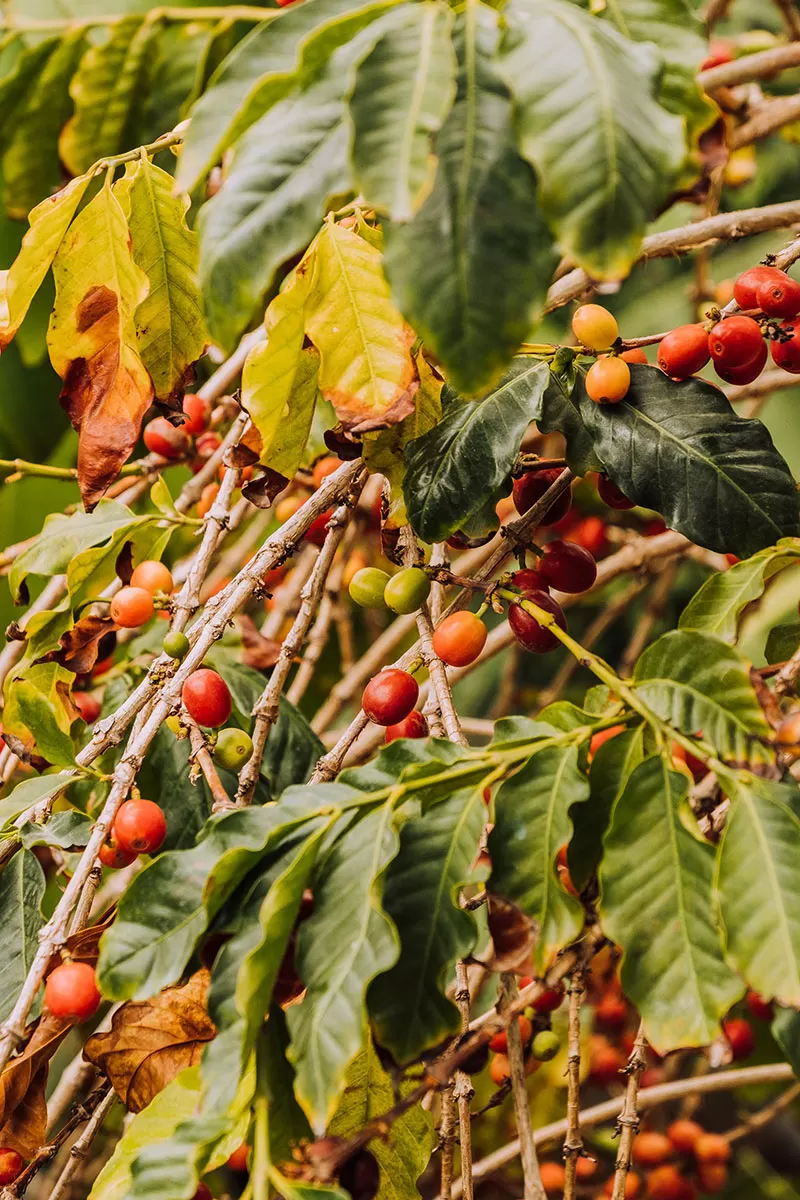
 Aside from the eminently palatable wines, the bodega is also known for growing oranges. Their sun-kissed orange orchards produce around 4.5-5.5 tons (4-5,000 kilos) annually. They make a refreshing addition to the tour. Coffee production is also taking root in the bodega, which like Los Berrazales Bodega, is a rarity in Europe.
Aside from the eminently palatable wines, the bodega is also known for growing oranges. Their sun-kissed orange orchards produce around 4.5-5.5 tons (4-5,000 kilos) annually. They make a refreshing addition to the tour. Coffee production is also taking root in the bodega, which like Los Berrazales Bodega, is a rarity in Europe.
If you love wine, a tour of the scenic ruta del vino is one of the unmissable things to do in Gran Canaria. If you can, make a stop at Bodega Señor de Cabrera. You won’t regret it.
Info for Bodega Señorío de Cabrera:
- Visits by appointment only. Use the contact form or email mail@senoriodecabrera.com
- Señorío de Cabrera, Garcia Ruiz Road, 35218 Balcony of Telde
- Tel: +34 928 572 124
- For more details, visit the official website
37. Explore the exquisitely restored hill town, Agüimes
The east coast may be scenic. But with fewer standout attractions, it has barely featured in this guide to the best things to do in Gran Canaria. But one destination you can’t ignore is Agüimes.
Despite being one of the oldest towns on the island, Agüimes was unloved and unvisited when tourism first exploded in the Canaries. But through the power of local investment, the town has been rejuvenated and now welcomes many visitors.
The immaculately clean streets, dotted with surprise sculptures, are noted for their laidback ambiance. A mix of whitewashed and pink houses contrast beautifully. The eye-catching streets are crowned by the soaring dome and domed towers of the Templo Parroquial de San Sebastián.
Work started on the grand San Sebastián church in 1796, yet was only completed in 1940. While the church lacks an ornate finish found in churches elsewhere on the island, it has an imposing presence.
As a curious footnote, a 1:1 replica of the church was built as part of the Lopesan Costa Meloneras Hotel in Maspalomas. Needless to say, it did not take 144 years to complete.
A short drive from the tranquil streets of Agüimes is some outstanding scuba diving and windsurfing at nearby Pozo Izquierdo.
The route to the coast also passes the Guayadeque Ravine, noted for hundreds of caves that were once lived in. The ravine is a thriving home to the island’s largest lizard, helpfully known as the Gran Canaria giant lizard.
With so many things to do in Gran Canaria, the eastern flank can easily be overlooked. But if you pick one spot to visit, I recommend Agüimes.
38. Complete your Canarian odyssey at the Pueblo Canario (Canarian Village)
When I drew up this guide to things to do in Gran Canaria, I aimed to choose destinations and attractions that provide real insight into the heritage and culture of the remarkable island. Back in Las Palmas de Gran Canaria, there is a destination that offers a final cultural immersion.
Nestled in the pretty Doramas Park, the Pueblo Canario and Museo Néstor invite visitors to dive deep into the culture and history of Gran Canaria.The museum celebrates the art of the modernist artist, Néstor Martín-Fernández de la Torre. The Pueblo Canario, opened in 1956, was his largest creation.
Found in the pueblo are a restaurant serving Canarian dishes, handicraft workshops showcasing the artisanal heritage of the islands, and traditional displays of folk music and dancing.
Set around a familiar town square, the complex of Canarian-style houses recreates a traditional island village. It is free to enter and enjoy the show and exhibits. Although you’ll probably want to spend your last remaining Euros savoring one final taste of the islands. A consummate end to an unforgettable Canarian odyssey.
Info for Pueblo Canario:
- Free Entry.
- Tuesday – Saturday 10 am to 8 pm
- Sunday 10.30 am to 2.30 pm
- Francisco González Díaz, 4, 35005 Las Palmas de Gran Canaria
- Tel: +34 928 24 51 35
I hope you’ve enjoyed this tour and found a few things to do in Gran Canaria that will make your time on the island unforgettable. If you’re looking for your home from home on the island, here are some outstanding hotels in Gran Canaria to stay in.
Recommended day trips, tours and experiences in Gran Canaria
Gran Canaria offers a plethora of unique tours and experiences, here are some of my favourites I recommend:
- Explore the landscapes around the Fataga Natural Park in this off-road adventure tour
- Splash into the clear, colorful waters on a scuba diving experience, choose from the following departure points:
- From Puerto Calma
- From Puerto Rico de Gran Canaria is this likely to sell out scuba trip
- From Puerto de Mogan
- Cruise along the Gran Canaria coast in a luxury catamaran
- See the most iconic and epic landscapes on this private photography tour
- Take this guided tour of vineyards, a wine museum, wineries and wine tasting
- Visit the lush Azuaje Ravine, rainforest, and seaside swimming holes at Agaete
- Tandem paragliding from Las Canteras, Las Palmas de Gran Canaria
- Go skydiving over the Maspalomas Dunes
- Jump the highest bungee jumping of Gran Canaria in La Calzada (28m)
- Rope Swinging (28 m) from La Calzada Bridge near Las Palmas de Gran Canaria
Hopefully, I’ve left little doubt about my love for Gran Canaria. It’s a magical island where the tropics meet Europe. Whether you’re a cultural explorer, gourmand, beach lover, or all three, there are many memorable things to do in Gran Canaria. If (when) you make the journey, buen viaje! (have a great trip!)
Don’t speak any Spanish? Brush up on the local lingo with my free Spanish travel phrase guide or join my online travel course Intrepid Spanish for Travel and learn anytime, anywhere and on any device.
Planning a trip and need travel insurance? Get a free quote from World Nomads here.
Visiting Spain? Check out my other Spain travel guides
- Where to Stay in Gran Canaria, Spain (The BEST Hotels)
- 19 Absolute Best Things to Do in San Sebastián | Spain’s Basque Country
- 19 Absolute Best Things to Do in Bilbao, Spain
- 13 Free things to do in Barcelona, Spain
- 23 Beautiful Must-See Places in Madrid, Spain
- 19 Reasons You’ll Want to Visit Costa Brava in Spain Right Now
- Costa Brava – Get my Ultimate 5-Day Costa Brava Itinerary
Learn Spanish anytime, anywhere with my 80/20 method
Travelling to Spain? Don’t be treated like a tourist! Live your best travel experiences and learn Spanish for less than the cost of eating at a tourist trap restaurant or a taxi driver who has “taken you for a ride”. In addition to my free Spanish travel phrase guide, I’ve made it even easier for you to master the Spanish language so you can create lifelong memories as you mingle with locals, get local tips, avoid tourist traps, and make new friends. Join my popular Spanish course here.
Here’s what my students are saying:

Loved it, loved it, loved it. I’ve been trying to learn languages using various language learning apps for years now and although I know random words I feel no more confident in actually speaking the language than I was when I started.” – Basil Pereira
Click here more details and get instant access!
Like it? Pin it for later!
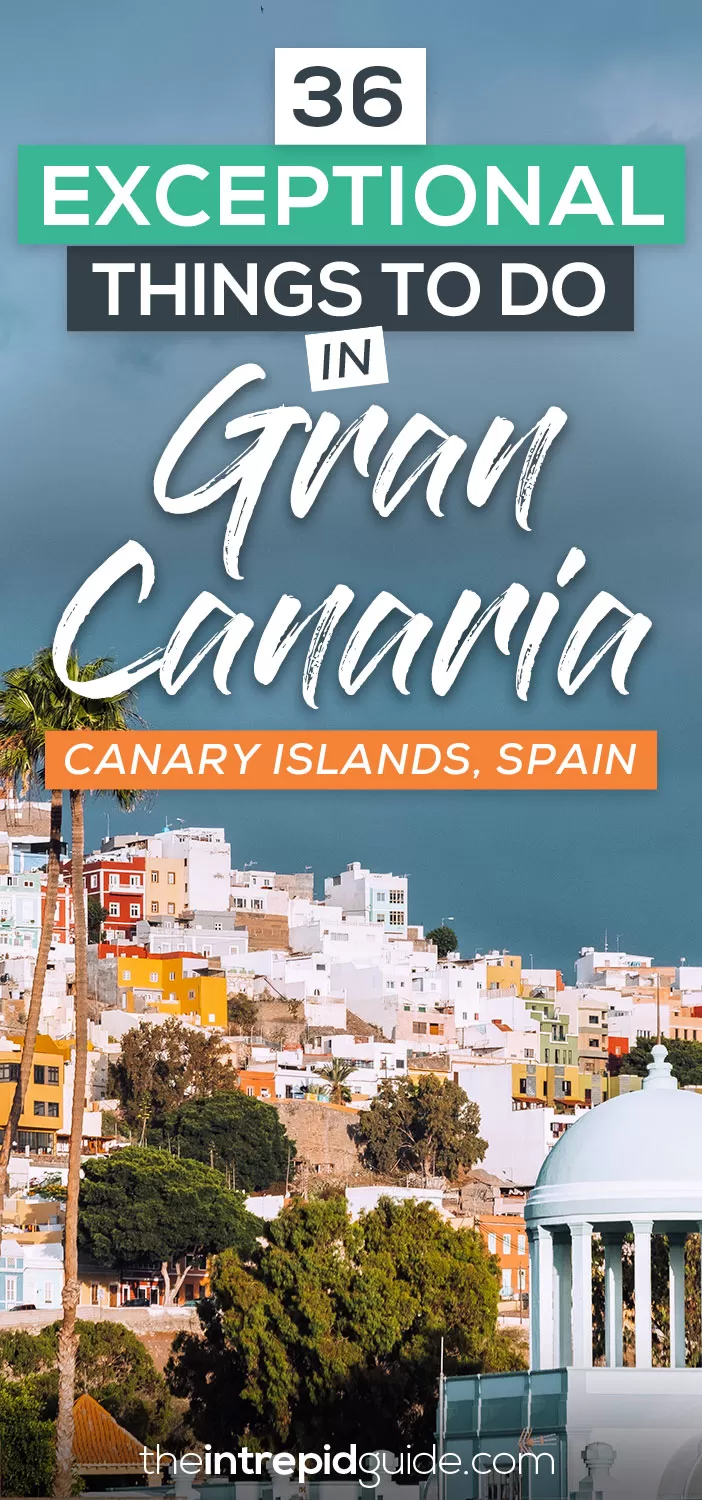
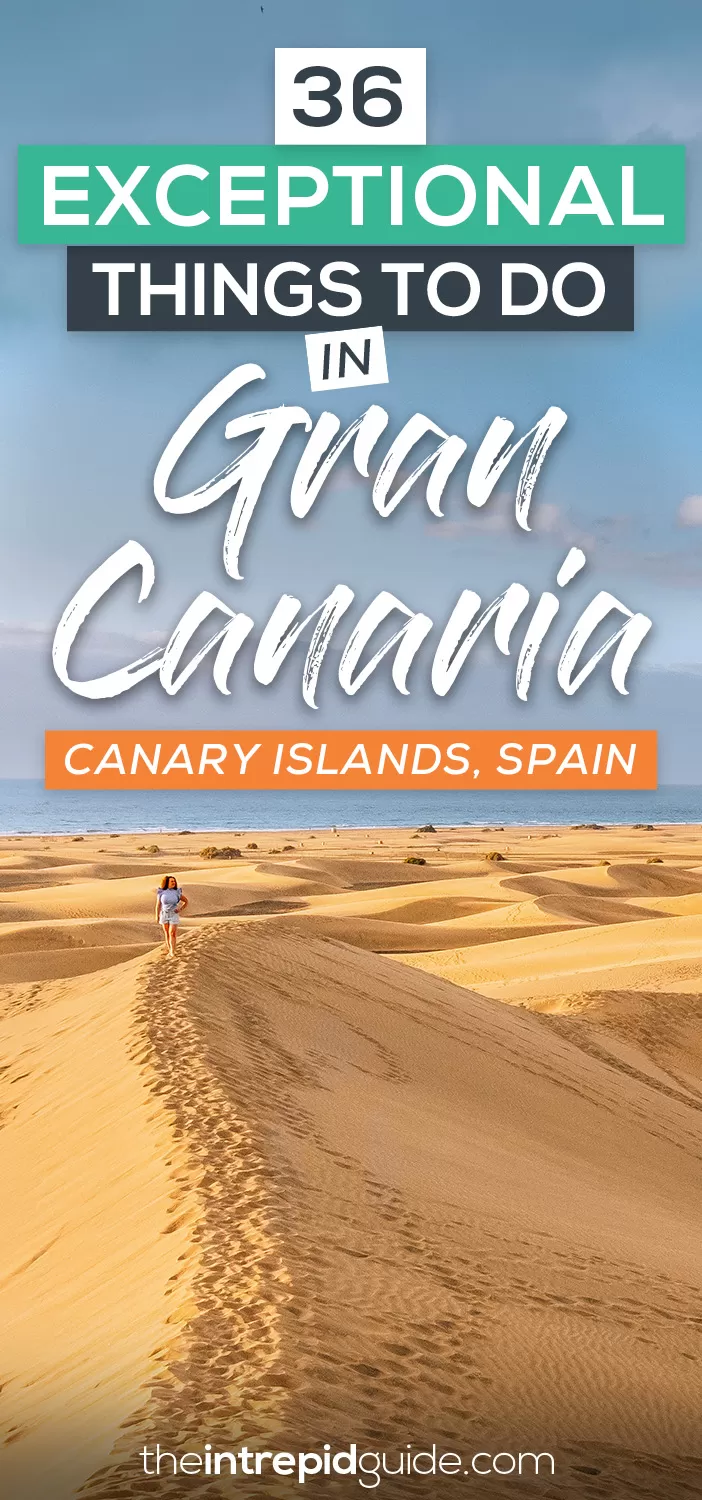
Over to you!
Do you have a question about things to do in Gran Canaria? Ask me below! Let me know using the comments section below or join me on social media to start a conversation.
Thanks for reading and I hope you enjoyed this post.
Like what you see? Subscribe using the form below to have all of my posts delivered directly to your email.

